

Item added to your cart
How to write a business plan for your recruitment agency.
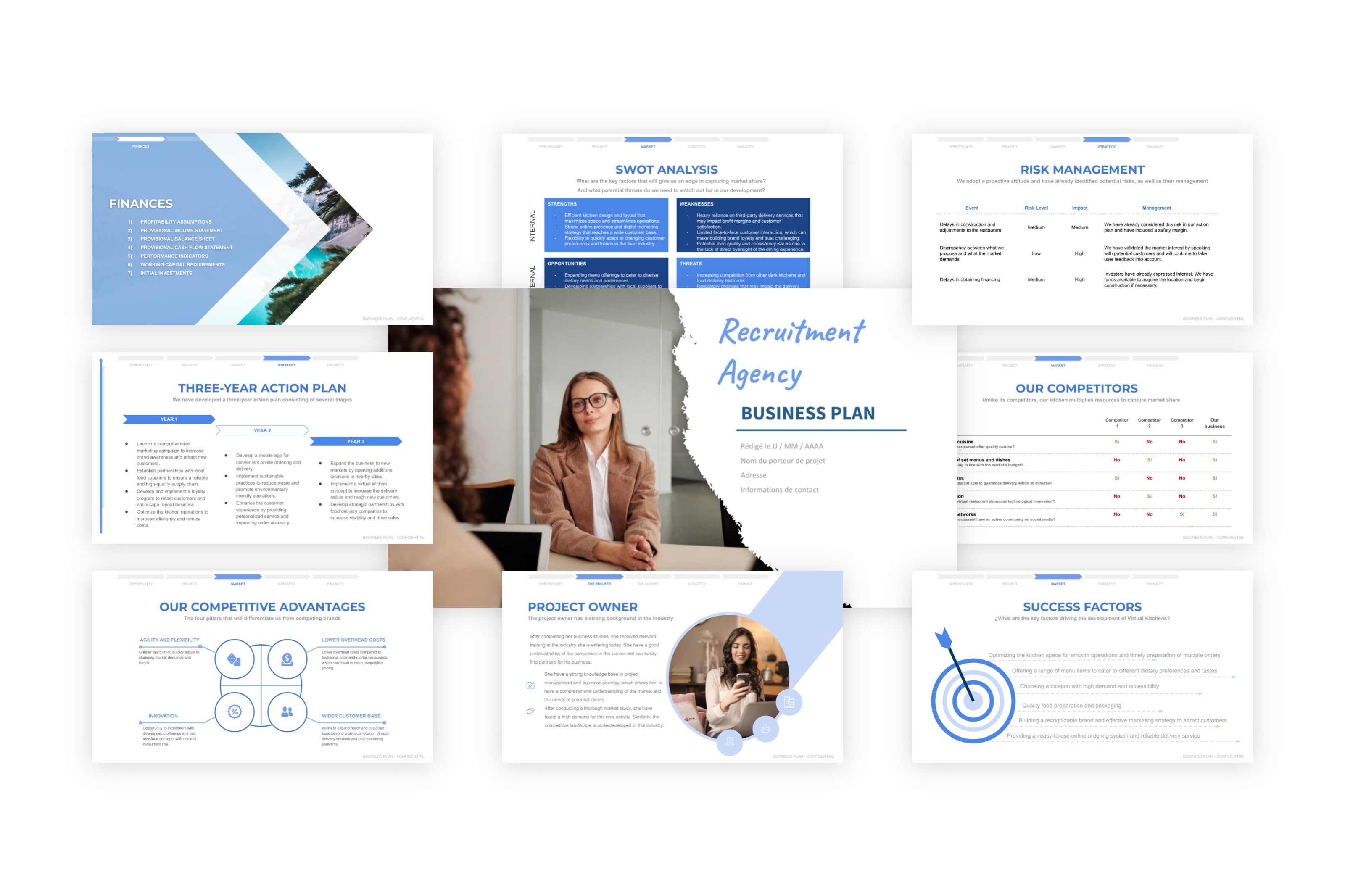
Starting a recruitment agency is a great idea because it provides a valuable service to employers and job seekers alike.
It is a great way to bridge the gap between the two and facilitate successful career placements.
But, first thing first, you need a business plan.
A business plan is essential for any new project, as it allows you to clearly define your goals, objectives, and strategies for success. It also provides a roadmap for the future, helping to ensure that your project is successful in the long term.
In short, a good business plan will help make sure your recruitment agency is profitable .
What information should you put into the business plan of a recruitment agency? What's the basic outline for the structure? What financial metrics should be included? What steps should I follow to write a business plan efficiently?
Stay with us: we'll tackle all these questions!
One last thing, you don't have to start your business plan from scratch.
Feel free to download our detailed business plan for a recruitment agency and customize it for your business.

Mapping out a business plan for a recruitment agency
Do you need to develop a business plan for your recruitment agency.
Yes, you need to develop a business plan for your recruitment agency.
Crafting a well-structured business plan will help you to:
- get familiar with the recruitment agency market
- be aware of new consumertrends and apply them to your project
- recognize profitability factors for a recruitment agency
- understand the hiring needs, job requirements, and talent preferences of client companies
- come up with a winning value proposition for your staffing services agency
- identify potential competitive threats
- find distinctive competitive edges for your recruitment agency
- find a business model that delivers consistent positive financial outcomes
- formulate an airtight strategy to maximize business growth
- evaluate potential risks specific to a recruitment agency, including client satisfaction, candidate vetting, and legal compliance
Our team has created a business plan for a recruitment agency that is designed to make it easier for you to achieve all the elements listed.
How to organize a business plan for a recruitment agency?
Inside a business plan, you'll find a lot of important information and details. It must be presented in a structured format, to make easy to read and digest.
When we built and designed our business plan for a recruitment agency , we made sure to structure it propertly.
We've categorized it into 5 sections (Opportunity, Project, Market Research, Strategy and Finances).
1. Market Opportunity
The section number one is titled "Market Opportunity."
In this section, you will find valuable data and insights about the recruitment agency, helping you understand the market landscape and assist companies in finding and hiring top talent.
We constantly update all the data there.
2. Project Presentation
The second part is dedicated to the "Project" of your recruitment agency. Here, you can outline the industries you specialize in, recruitment services offered, candidate sourcing strategies, screening and selection processes, client partnerships, and the unique value proposition that connects top talent with the right job opportunities.
Also, provide a self-introduction at the end of this section.
Discuss your expertise in talent acquisition, your range of recruitment services, and how you plan to provide comprehensive and tailored staffing solutions to clients. Highlight your industry knowledge, your network of professionals, and your dedication to matching the right talent with the right opportunities through your recruitment agency.
We drafted some language for you in our business plan. Adjust it to suit your idea perfectly.
3. Market Research
Then, there is the "Market Research" section.
In this section, you will find a detailed market segmentation analysis for your recruitment agency.
It includes a presentation of other recruitment agencies in the area that will be competing with you. Your agency's expertise in talent acquisition and competitive advantages are also highlighted. A customized SWOT analysis is included.
4. Strategy
The "Strategy" section outlines a comprehensive 3-year action plan, detailing the initiatives and steps needed to transform your recruitment agency into a highly profitable endeavor.
Additionally, there's a marketing strategy, a risk management strategy, and a Business Model Canvas available in this section.
5. Finances
In the end, you'll find the "Finances" section, which provides a comprehensive overview of the financials for your project.

How to make an Executive Summary for a recruitment agency?
The Executive Summary serves as an introduction to the business plan for your recruitment agency.
Keep it concise and ensure it fits within 2 pages. Highlight only the necessary details.
When you present your business plan to investors, this is the section they will read first. It needs to grab their attention and make them want to explore the rest of the plan.
In the Executive Summary of your recruitment agency, address the following queries: what services does your recruitment agency offer? who is your target market? are there other recruitment agencies in the industry? what sets you apart from them? what funding do you require?
How to do the market analysis for a recruitment agency?
Analyzing the market for your recruitment agency allows you to gain insights into factors such as client demands for talent acquisition, competition within the recruitment industry, and emerging trends in HR and staffing.
By conducting a thorough market study, a recruitment agency can understand client hiring needs, offer effective recruitment solutions, optimize pricing strategies, and execute targeted marketing campaigns, ultimately leading to a larger client base, increased job placements, and a prominent position in the recruitment industry.
Here is what you can expect to find in the "Market Research" section of our business plan for a recruitment agency :
- market trends and data about recruitment agencies, including job market analysis, talent acquisition strategies, and industry-specific hiring trends
- a list of potential customer segments for a recruitment agency
- the competitive comparison
- the potential competitive advantages for a recruitment agency

The key points of the business plan for a recruitment agency
What's the business model of a recruitment agency, business model of a recruitment agency.
A recruitment agency's business model revolves around connecting employers with qualified candidates for job openings. Revenue is generated through fees or commissions based on successful placements.
The business model focuses on understanding clients' hiring needs, conducting candidate sourcing and screening, effective marketing to attract employers and job seekers, and building strong client and candidate relationships based on trust and expertise in recruitment.
Success depends on building a robust candidate database, delivering suitable talent for job openings, fostering positive client and candidate experiences and recommendations, and continuously adapting to changing recruitment methods and job market dynamics.
Business model ≠ Business plan
Make sure you differentiate between "business plan" and "business model."
A business model describes how a company generates income and operates successfully.
In a business plan, you articulate your business model through a framework known as the Business Model Canvas.
Rest assured, there is a Business Model Canvas (already completed) in our business plan for a recruitment agency .
How do you identify the market segments of a recruitment agency?
Market segmentation for your recording studio involves dividing your potential clients into different groups based on their recording needs, music genres, and preferences.
These categories may include factors such as music artists, voice-over artists, podcasters, or clients seeking specific recording services or equipment (e.g., vocal recording, sound mixing, podcast production).
By segmenting your market, you can offer specialized recording services and facilities that cater to each segment's specific requirements. For example, you might focus on music artists and provide state-of-the-art recording studios equipped with instruments and production tools for music production, offer professional voice-over recording services for clients in need of high-quality voice recordings for commercials, audiobooks, or animations, specialize in podcast production and provide podcasters with dedicated recording spaces and podcast editing services, or focus on specific recording services or equipment such as vocal recording, sound mixing, or audio mastering.
Market segmentation allows you to effectively target your marketing efforts, communicate the capabilities and technical expertise of your recording studio, and provide a creative and professional recording environment that meets the unique needs and preferences of each client segment.
In the business plan for a recruitment agency , you will find a comprehensive market segmentation that will help you better understand your potential customers.
How to conduct a competitor analysis for a recruitment agency?
Without surprise, you won't be the only recruitment agency in your market. There will be other agencies offering staffing and talent acquisition services to organizations.
Understanding your competitors' strengths and weaknesses is critical when developing your business plan.
Identify their weaknesses (such as limited industry connections, inadequate candidate screening, or poor client communication).
Why is it important to address these elements? Because these weaknesses can impact the effectiveness of recruitment agency services.
By focusing on these areas, you can offer a wide network of qualified candidates, provide efficient and thorough recruitment processes, and deliver personalized and attentive client support, positioning your recruitment agency as a trusted and preferred partner for businesses seeking top talent and successful staffing solutions.
It's what we call competitive advantages—develop them to make your business stand out.
Here are some examples of competitive advantages for a staffing agency: extensive network of qualified candidates, personalized recruitment solutions, timely placements.
How to draft a SWOT analysis for a staffing agency?
A SWOT analysis can help identify the strengths, weaknesses, opportunities, and threats of a recruitment agency, enabling informed decision-making and increased success.
As you can guess, there is indeed a completed and editable SWOT matrix in our business plan for a recruitment agency
The strengths for a recruitment agency
When we talk about the "S" in SWOT, we mean Strengths, which are the project's internal capabilities or unique strengths.
For a recruitment agency, possible strengths could include an experienced team, a strong network of contacts, an extensive database of candidates, and a comprehensive understanding of the recruitment market.
The weaknesses for a recruitment agency
W stands for Weaknesses, referring to the project's areas or aspects that have room for improvement.
For a recruitment agency, potential weaknesses include difficulty in finding suitable candidates, lack of access to a large pool of qualified applicants, high cost of advertising to attract talent, and potential clients not trusting the agency.
The opportunities for a recruitment agency
The letter "O" in SWOT signifies Opportunities, highlighting the favorable conditions or chances for the project's progress.
In the case of a recruitment agency, potential opportunities include providing executive search services, offering temporary staffing solutions, providing online job postings, and providing career coaching services.
The threats for a recruitment agency
When we use the "T" in SWOT, we're referring to Threats, which are the external risks or challenges that the project may encounter.
How to develop a marketing plan for a staffing agency?
A marketing strategy is a key factor in acquiring customers and increasing revenue, so include it in your business plan.
A well-crafted marketing strategy will attract companies and job seekers to your recruitment agency, emphasizing your expertise in matching the right talent with the right job.
Companies won't hire your recruitment agency without effective marketing; showcasing your talent pool and personalized approach is crucial.
Are you utilizing marketing tactics to attract clients to your recruitment agency? Consider building strong relationships with local businesses and job seekers, offering specialized recruitment services, and utilizing digital marketing strategies to showcase your expertise in the industry.
Don't let a lack of ideas for your project's marketing strategy discourage you.
How to build a solid financial plan for a staffing agency?
A solid business plan must include financial data to provide an accurate assessment of the business's potential success.
Obviously, you should estimate the projected revenue for your recruitment agency.
It's crucial for this revenue forecast to be clear and straightforward.
Our financial plan for a recruitment agency is easy to use and includes built-in checks to help you identify and correct any assumptions, ensuring you create reliable projections with confidence.
Without a doubt, you'll need to come up with a basic budget for starting your recruitment agency. Make sure to include every expense (by the way, they are all listed in the financial plan we've made).
The break-even analysis is central in the financial plan as it will tell you whether your recruitment agency will generate profits or not.
- Choosing a selection results in a full page refresh.
- Opens in a new window.

Recruitment Agency Business Plan: How to Write One

Launching a recruitment agency demands a solid foundation, and crafting a detailed business plan is the cornerstone. Get started on your recruitment agency business plan with our guide. We will walk you through all the details.
The United States, Japan, and the United Kingdom dominated the recruitment and staffing industry in 2022, generating 55% of its revenue. Global revenue for the staffing industry jumped 4% to $648 billion, according to a report from Staffing Industry Analysts . The current job market, characterized by rapid technological advancements and shifting workforce demographics, is creating a market for flexible staffing solutions.
To cut costs and improve the efficiency of human resources, businesses are turning to staffing and recruitment agencies to secure talent. The rise of the gig economy and the preference for contract or temporary positions among workers seeking greater work-life balance is helping fuel the industry’s growth. Nearly 23% of working Americans also have a side hustle, according to a recent study by Pymnts .
Your Business Plan’s Key Elements
Whether you are a seasoned professional in the staffing world or a newcomer to the field, you need to start with a recruitment agency business plan. Creating a business plan requires gathering a significant amount of information. Start by researching the staffing industry, including market size, growth trends, and regulatory considerations. Network with industry professionals, attend relevant conferences, and utilize online resources to gain knowledge. Financial projections should be based on realistic market assumptions and comparable business models.
Keep in mind you will need a business plan at various stages of your business journey. Initially, it will guide your startup phase, helping you to secure funding and establish your business structure. As your agency grows, revisiting your plan can help you to scale your operations and enter new markets.
A comprehensive startup business plan for a recruitment agency should include:
- Executive summary: Start with a clear and concise overview of your business — your elevator pitch. Highlight your business goals, mission statement, and the services you plan to offer.
- Market analysis: Conduct thorough research on the staffing industry, focusing on your niche. Identify your target market, analyze your competitors, and outline the trends and challenges in the industry to understand your unique selling proposition.
- Services: Detail the types of staffing services you plan to provide. Whether it is temporary staffing, permanent placement, or executive search, be clear about your offerings, the verticals you will serve, and how they meet the needs of your target market.
- Marketing plan: Outline how you will attract clients and candidates with your marketing plan and sales strategy. Identify the channels you can use to build your brand and reach your audience.
- Operations: Describe the day-to-day operations of your agency, including the recruitment process, the technology, the tools you need, and how you plan to maintain quality and compliance.
- Financial plan: Make detailed financial projections, such as startup costs, revenue forecasts, and a break-even analysis to understand the financial viability of your business.
- Management: Highlight your team’s expertise and the organizational structure of your agency. If you start solo, outline your experience and any external support you can leverage.
Partnering With AtWork: A Shorter Path to Your Goal
If you are considering opening a recruitment agency, partnering with AtWork to start a staffing franchise can significantly streamline the startup process. By joining forces with a proven brand, you can cut down on startup costs and bypass many of the hurdles of starting from scratch. AtWork’s recruitment agency business plan also allows you to take advantage of the Work Opportunity Tax Credit (WOTC) to lower your operational costs.
AtWork provides comprehensive knowledge, training, and tools essential for launching your staffing business. As a franchise owner, you get in-depth training on running a successful staffing agency, including sales, operations, and compliance. AtWork has state-of-the-art technology and operational tools to simplify day-to-day management, and marketing campaigns to effectively promote your agency and attract clients and candidates. Its support staff also handles all your payroll, allowing you to concentrate on scaling the business.
Learn More About AtWork
Get started to learn more about partnering with AtWork to launch a business in the staffing industry.
Related Articles

Franchise Pros and Cons: 10 Things to Know Before Investing
Discover the pros and cons of owning a franchise. AtWork can help you understand the advantages and disadvantages of franchising to decide whether you are ready for franchise ownership. There

What Is a Community Business and How Do I Start One?
From creating jobs to providing essential services, community-based businesses build a support system for local residents. Explore community business ideas that let you be an entrepreneur while helping others. Customers

5 Career Change Options for Sales Professionals
5 Career Change Options for Sales Professionals Many sales professionals come to a point where the thrill of sales starts to fade and the desire for a new challenge grows.
AtWork Nationwide
Find the AtWork temporary staffing agency most convenient for you. Choose from nearly 100 offices across the country.
Launch Your Business
Find Out About Opening an AtWork Office.

- Search Jobs
- Hiring Process
- Employee FAQs
- Refer a Friend
- Our Services
- Our Approach
- Hire AtWork
- News & Events
Which branch would you like to apply with? Please select your location below to get started.
Recruitment Business Plan Template & Guidebook
For any business looking to take their recruitment efforts to the next level, having an effective plan of action is a must. The #1 Recruitment Business Plan Template & Guidebook offers an easy-to-follow framework for creating a step-by-step recruitment strategy that will get results. This comprehensive guide includes everything you need to know to develop an actionable plan backed by best practices and insightful tips from industry experts. Let's explore what this powerful tool can do to help you increase your hiring success.
Get worry-free services and support to launch your business starting at $0 plus state fees.
- How to Start a Profitable Recruitment Business [11 Steps]
- 10+ Best & Profitable Recruitment Business Ideas [2023]
- List of the Best Marketing Ideas For Your Recruitment Service:
How to Write a Recruitment Business Plan in 7 Steps:
1. describe the purpose of your recruitment business..
The first step to writing your business plan is to describe the purpose of your recruitment business. This includes describing why you are starting this type of business, and what problems it will solve for customers. This is a quick way to get your mind thinking about the customers’ problems. It also helps you identify what makes your business different from others in its industry.
It also helps to include a vision statement so that readers can understand what type of company you want to build.
Here is an example of a purpose mission statement for a recruitment business:
Our mission is to provide world-class and innovative recruitment solutions that help organizations find and hire the best talent to increase their competitive advantage. We strongly believe in the power of bringing together the right people and nurture a culture of employee satisfaction, growth and development.

2. Products & Services Offered by Your Recruitment Business.
The next step is to outline your products and services for your recruitment business.
When you think about the products and services that you offer, it's helpful to ask yourself the following questions:
- What is my business?
- What are the products and/or services that I offer?
- Why am I offering these particular products and/or services?
- How do I differentiate myself from competitors with similar offerings?
- How will I market my products and services?
You may want to do a comparison of your business plan against those of other competitors in the area, or even with online reviews. This way, you can find out what people like about them and what they don’t like, so that you can either improve upon their offerings or avoid doing so altogether.

3. Build a Creative Marketing Stratgey.
If you don't have a marketing plan for your recruitment business, it's time to write one. Your marketing plan should be part of your business plan and be a roadmap to your goals.
A good marketing plan for your recruitment business includes the following elements:
Target market
- Who is your target market?
- What do these customers have in common?
- How many of them are there?
- How can you best reach them with your message or product?
Customer base
- Who are your current customers?
- Where did they come from (i.e., referrals)?
- How can their experience with your recruitment business help make them repeat customers, consumers, visitors, subscribers, or advocates for other people in their network or industry who might also benefit from using this service, product, or brand?
Product or service description
- How does it work, what features does it have, and what are its benefits?
- Can anyone use this product or service regardless of age or gender?
- Can anyone visually see themselves using this product or service?
- How will they feel when they do so? If so, how long will the feeling last after purchasing (or trying) the product/service for the first time?
Competitive analysis
- Which companies are competing with yours today (and why)?
- Which ones may enter into competition with yours tomorrow if they find out about it now through word-of-mouth advertising; social media networks; friends' recommendations; etc.)
- What specific advantages does each competitor offer over yours currently?
Marketing channels
- Which marketing channel do you intend to leverage to attract new customers?
- What is your estimated marketing budget needed?
- What is the projected cost to acquire a new customer?
- How many of your customers do you instead will return?
Form an LLC in your state!

4. Write Your Operational Plan.
Next, you'll need to build your operational plan. This section describes the type of business you'll be running, and includes the steps involved in your operations.
In it, you should list:
- The equipment and facilities needed
- Who will be involved in the business (employees, contractors)
- Financial requirements for each step
- Milestones & KPIs
- Location of your business
- Zoning & permits required for the business
What equipment, supplies, or permits are needed to run a recruitment business?
- Internet access
- Recruiting software
- Phone line (landline or mobile)
- Business license and permits in accordance with local government regulations
- Advertising resources (e.g. newspapers, job boards, recruitment websites)
- Office space (if applicable)
- Business cards, stationery, brochures
5. Management & Organization of Your Recruitment Business.
The second part of your recruitment business plan is to develop a management and organization section.
This section will cover all of the following:
- How many employees you need in order to run your recruitment business. This should include the roles they will play (for example, one person may be responsible for managing administrative duties while another might be in charge of customer service).
- The structure of your management team. The higher-ups like yourself should be able to delegate tasks through lower-level managers who are directly responsible for their given department (inventory and sales, etc.).
- How you’re going to make sure that everyone on board is doing their job well. You’ll want check-ins with employees regularly so they have time to ask questions or voice concerns if needed; this also gives you time to offer support where necessary while staying informed on how things are going within individual departments too!
6. Recruitment Business Startup Expenses & Captial Needed.
This section should be broken down by month and year. If you are still in the planning stage of your business, it may be helpful to estimate how much money will be needed each month until you reach profitability.
Typically, expenses for your business can be broken into a few basic categories:
Startup Costs
Startup costs are typically the first expenses you will incur when beginning an enterprise. These include legal fees, accounting expenses, and other costs associated with getting your business off the ground. The amount of money needed to start a recruitment business varies based on many different variables, but below are a few different types of startup costs for a recruitment business.
Running & Operating Costs
Running costs refer to ongoing expenses related directly with operating your business over time like electricity bills or salaries paid out each month. These types of expenses will vary greatly depending on multiple variables such as location, team size, utility costs, etc.
Marketing & Sales Expenses
You should include any costs associated with marketing and sales, such as advertising and promotions, website design or maintenance. Also, consider any additional expenses that may be incurred if you decide to launch a new product or service line. For example, if your recruitment business has an existing website that needs an upgrade in order to sell more products or services, then this should be listed here.
7. Financial Plan & Projections
A financial plan is an important part of any business plan, as it outlines how the business will generate revenue and profit, and how it will use that profit to grow and sustain itself. To devise a financial plan for your recruitment business, you will need to consider a number of factors, including your start-up costs, operating costs, projected revenue, and expenses.
Here are some steps you can follow to devise a financial plan for your recruitment business plan:
- Determine your start-up costs: This will include the cost of purchasing or leasing the space where you will operate your business, as well as the cost of buying or leasing any equipment or supplies that you need to start the business.
- Estimate your operating costs: Operating costs will include utilities, such as electricity, gas, and water, as well as labor costs for employees, if any, and the cost of purchasing any materials or supplies that you will need to run your business.
- Project your revenue: To project your revenue, you will need to consider the number of customers you expect to have and the average amount they will spend on each visit. You can use this information to estimate how much money you will make from selling your products or services.
- Estimate your expenses: In addition to your operating costs, you will need to consider other expenses, such as insurance, marketing, and maintenance. You will also need to set aside money for taxes and other fees.
- Create a budget: Once you have estimated your start-up costs, operating costs, revenue, and expenses, you can use this information to create a budget for your business. This will help you to see how much money you will need to start the business, and how much profit you can expect to make.
- Develop a plan for using your profit: Finally, you will need to decide how you will use your profit to grow and sustain your business. This might include investing in new equipment, expanding the business, or saving for a rainy day.
Frequently Asked Questions About Recruitment Business Plans:
Why do you need a business plan for a recruitment business.
A business plan for a recruitment business is important because it serves as a roadmap outlining the objectives, strategies and action plans for the business. It can also help to identify potential risks, as well as ways to manage those risks, and establish financial goals. Furthermore, a business plan can help to attract potential investors or lenders and provide a basis for evaluating the success of the business.
Who should you ask for help with your recruitment business plan?
You should ask for help from an experienced recruitment consultant, business consultant, or a professional business coach. They can provide you with valuable advice and resources to help you create a successful business plan. Additionally, you may want to consult with a lawyer or accountant who have expertise in the recruitment industry.
Can you write a recruitment business plan yourself?
Yes, it is possible to write a recruitment business plan yourself. However, it may be more beneficial to consult a professional business plan writer to ensure the plan meets industry standards and contains all the necessary components. A professional also has experience in writing successful plans, which can greatly increase the chances of success.
Related Business Plans

Home Inventory Business Plan Template & Guidebook

Home Inspection Business Plan Template & Guidebook

Home Decor Business Plan Template & Guidebook

Health And Wellness Business Plan Template & Guidebook

Hauling Business Plan Template & Guidebook

Hardware Business Plan Template & Guidebook

Handyman Business Plan Template & Guidebook

Hair Extension Business Plan Template & Guidebook

Handbag Business Plan Template & Guidebook
We're newfoundr.com, dedicated to helping aspiring entrepreneurs succeed. As a small business owner with over five years of experience, I have garnered valuable knowledge and insights across a diverse range of industries. My passion for entrepreneurship drives me to share my expertise with aspiring entrepreneurs, empowering them to turn their business dreams into reality.
Through meticulous research and firsthand experience, I uncover the essential steps, software, tools, and costs associated with launching and maintaining a successful business. By demystifying the complexities of entrepreneurship, I provide the guidance and support needed for others to embark on their journey with confidence.
From assessing market viability and formulating business plans to selecting the right technology and navigating the financial landscape, I am dedicated to helping fellow entrepreneurs overcome challenges and unlock their full potential. As a steadfast advocate for small business success, my mission is to pave the way for a new generation of innovative and driven entrepreneurs who are ready to make their mark on the world.
Sample Recruitment Business Plan
A sample recruitment business plan revolves around basically three words that describe your business philosophy. 3 min read updated on November 02, 2020
Sample Template for Starting a Recruitment Business
Business Niche
Creating a business plan involves making some decisions upfront. This means choosing a niche. By doing so, you'll be deciding the type of recruitment agency to start and the industry to serve.
Observing Competitors
Observe how your competitors' work provides an excellent opportunity and how its recruitment process works.
Gathering Experience
Starting a recruitment agency requires the experience that a recruiter uses to find the perfect match for a company's needs. Examples of what you need to know include:
- Knowledge of recruiting
- Recruitment strategies
- Personal skills
To acquire the type of experience necessary to operate a recruitment agency, it's recommended that you register with a reputable recruitment agency to experience, firsthand, some basic training in how an agency operates.
Building Skills
Keep in mind that part of a recruiter's job is testing the skills of potential candidates for jobs. So, your own skill level must be up to the task. It's equally important that you're able to recognize someone with potential even though they may not possess a lot of experience. You also need the insight to place the right person in the right position.
Evaluating Start-Up Costs
A recruitment agency isn't a cheap business venture to initially get started. You'll need a checklist of all things needed and the cost of each item. Things to include are staff payroll, marketing, insurance, and basic business expenses.
Researching Recruitment Laws
Study and become familiar with the recruitment laws in your state to ensure you aren't in violation. Each has guidelines that may include requirements for specific industries.
Obtain a Business License
Check with your local city and county office as well as the state to find out if or what type of business license is required to operate a recruitment agency. Obtain the license prior to opening for business.
Research Employment Laws
Laws guiding the rules of employment in each state are also in effect and something you must become familiar with. Examples include laws against discrimination and equal opportunity employment .
Business Location
Select a business location that's visible and easily accessible for clients and job applicants.
Register With Recruiters
Register with other companies as a recruiter. This is a way to bring in business should a company need to fill a position and contact you to fill the position.
Create a Marketing Plan
Create a marketing plan that outlines your business and its services. Make a list of businesses to contact and send a letter of introduction letting owners/managers of these businesses know about your company and what it has to offer. Also, follow up on each letter. Take advantage of the internet and newspapers by placing ads to highlight your business.
Create a Business Website
In today's fast-paced world, having a website is the standard operating procedure. A website is a gateway to advertising job vacancies. It's also a way for potential job seekers to provide resumes and conduct online interviews.
Hire Support Staff
A recruitment agency requires lots of paperwork, and you'll need to hire qualified staff to help with the tasks. This means bringing staff on board who have previous recruitment experience.
Contact insurance companies about purchasing liability insurance for your business.
Business Bank Account
Open a business account that's separate from your personal account for accepting payments for services from clients.
Equipment Necessary for a Recruiting Agency
The office space should include a reception area for greeting applicants and receiving applications. There should also be a conference room where you can conduct interviews. Necessary equipment includes:
- At least one computer.
- Testing software (i.e., printer(s), a fax machine, and a photocopier).
- Reliable internet service.
- Business cards.
Potential Recruiter Salary
On average, a recruitment consultant has the potential to earn between $65,000 and $75,000 annually. Charges for placing a candidate can range between 14 and 20 percent. Charges for your services may be based on a percentage of the candidate's first annual salary. The other option is charging a flat fee to the company you're recruiting for.
If you need help with a sample recruitment business plan, you can post your legal need on UpCounsel's marketplace. UpCounsel accepts only the top 5 percent of lawyers to its site. Lawyers on UpCounsel come from law schools such as Harvard Law and Yale Law and average 14 years of legal experience, including work with or on behalf of companies like Google, Menlo Ventures, and Airbnb.
Hire the top business lawyers and save up to 60% on legal fees
Content Approved by UpCounsel
- How to Start a Business: A Comprehensive Guide for Entrepreneurs
- Starting a Company
- How to Start a Insurance Company
- How Does a Business Operate: Everything You Need To Know
- How To Start a Contract Business
- LLC Checklist
- How to Start a Marketing Business
- How Long Does it Take to Get a Business License
- How to Start an Online Business: Step-by-Step Guide
- Sample of a Good Business Plan
How to write a business plan for a recruitment agency
Table of Contents
Why a business plan is important
Provide direction, minimise risk , reduce spending, market research , budgeting and financial planning, examples of swot analysis for a recruitment agency, opportunities , how countingup can benefit your recruitment agency.
If you’re looking to start a recruitment agency, you’ll need to create a business plan as any other startup would. Remember, though, that you’ll need to also account for the specific situations that might arise while working in the recruitment industry.
This article will serve as a guide to writing a great business plan for your recruitment agency. We’ll look at what your plan should look like, as well as why a plan is important. The topics we’ll cover include:
There are a few different reasons why you need a business plan before starting a business , but one of the most important is that it will guide your business going forward. Without a plan, no matter how simple the plan is, you’ll likely struggle to develop your business and make effective decisions.
A business plan doesn’t have to be set in stone — you can adapt it to account for any unique events that affect your recruitment agency. That said, it’s essential to have at least a vague idea of the purpose your business will serve, the potential obstacles you might encounter, and how you’re going to deal with those obstacles.
A business plan is also necessary to minimise the risk you’ll face when starting a recruitment agency . One of the key sections of a business plan is the SWOT analysis, where SWOT stands for strengths, weaknesses, opportunities and threats.
In order to minimise risk effectively, it’s vital that you analyse both the weaknesses of your agency as well as the threats it may face. In doing so, you’ll be able to fix your weak points and avoid potential threats more effectively.
Finally, business plans are important because they provide valuable data for minimising your spending. For example, during your SWOT analysis and financial planning , you may find that you’ve budgeted a large amount of spending to support a part of your business that’s actually very strong.
In a recruitment agency, this might mean you’ve planned to spend a lot of money on marketing, but your business already has a strong brand because you (as the owner) have many good personal contacts in the industry. In this instance, you can safely reduce your marketing budget and save your business money.
Thorough market research is the best first step when you’re writing a business plan . Market research means examining the industry your business will exist in, and finding out the needs and preferences of that industry’s consumers.
For a recruitment agency, a key research topic for your business plan would be finding out the impact COVID-19 has had on the market. Many new markets emerged during the pandemic, which you can provide your services to. As the UK is currently recovering from the pandemic, it would also be wise to look into which industries are now recruiting heavily after laying off staff in recent years.
Planning out how you’ll spend your money when starting your agency is also a key part of a good business plan. You need to consider your budget for starting the business as well as how you’ll manage your business finances going forward.
It’s smart to prepare a budget for each section of your business. For instance, you might set aside different amounts for recruiting staff, purchasing business premises, and marketing. Your advertising budget is particularly important when you’re a small business , as you may not be able to rely on personal contacts or existing clients for referrals, so you’ll need to attract clients independently.
Conducting a SWOT analysis is a great way of evaluating your business even after starting up, but it’s particularly helpful when you first put together your business plan. SWOT stands for strengths, weaknesses, opportunities and threats, so a SWOT analysis requires you to think of an example of these for your business. In a recruitment agency, these might be:
As mentioned above, it may be that you have a good reputation because you have a wealth of experience and personal connections in the recruitment industry, so you’ll not need to worry as much about marketing.
Recruitment agencies frequently have to use a lot of software to track their clients’ needs and organise candidate applications. If you’re not very good with technology, you may need to hire staff who are to account for this weakness.
The UK is currently rebounding from the struggles of the COVID-19 pandemic, and this presents a wealth of opportunities for a good recruitment agency.
You need to take immense care when you’re handling people’s personal information, which you’ll often do at a recruitment agency. Sending this information to the incorrect person can have a considerable negative impact on your business, as there is a lot of new legislation regarding privacy.
Your business plan should include a good amount of financial planning, as tracking your cash flow (your incoming and outgoing cash) is hugely important in any business.
Countingup is the business current account with built-in accounting software that allows you to manage all your financial data in one app. With features like automatic expense categorisation, invoicing on the go, receipt capture tools, tax estimates, and cash flow insights, you can confidently keep on top of your business finances wherever you are.
You can also share your bookkeeping with your accountant instantly without worrying about duplication errors, data lags or inaccuracies. Seamless, simple, and straightforward!
Find out more here .

- Counting Up on Facebook
- Counting Up on Twitter
- Counting Up on LinkedIn
Related Resources
What is the difference between an invoice and a receipt.
As a small business owner or freelancer, you’ll have heard of receipts and
Small business health checklist
Running a business can be a fairly hectic job. There’s often so much
What is financial reporting? 8 must-measure metrics for small businesses
Financial reporting is a crucial part of any business. After all, you need
What is the difference between gross and net profit
Profit is categorised in two ways: gross and net. Each is important in
How to set prices for your small business
Your prices decide whether customers will buy your products or those of your
What are key performance indicators?
To gauge the success of your small business, you need to dive deeper
How to track expenses for a small business
Part of owning a business is spending money to keep it running. Any
What insurance does a self-employed hairdresser need?
As a self-employed hairdresser, you’re open to risks in your everyday work. Whether
What are assets and liabilities in a business?
Anyone going into business needs to be familiar with assets and liabilities. They
Personal car for business use: How does it work?
Access to a car is a must for most businesses, meaning that travel
Advantages and disadvantages of using personal savings in business
Have you got a new business idea? And are you considering using your
How to pay Corporation Tax
Corporation Tax is the main tax your limited company has to pay every
Recruitment Agency Business Plan
Striking out and setting up your own recruitment agency is an exciting prospect, and there’s never been a better time to do it. With over 31,000 agencies in the UK, the recruitment industry is booming. Despite the profound impact of COVID-19 on the labour market, recruitment is projected to bounce back massively in 2024, so now is the perfect time to seize the opportunity and open your own agency.
Pre-pandemic, the recruitment industry generated over £42.3 billion in the UK alone, and recruitment agencies and firms are predicted to grow substantially in the next 3-5 years.
It’s clear that there is huge revenue potential in the recruitment industry. However, to stand out from the crowd, you’ll need a great recruitment agency business plan. This will give you the strategy and understanding of the industry you need to succeed.
So, where should you start? Our guide will take you through each individual step in making your own business plan. We’ll take you through marketing strategy, pricing structure and management, all of which are crucial to the success of your recruitment agency. As a new business owner, there will be a lot to take in, but with our recruitment agency business plan, you’ll have the ultimate guide to take you forward.
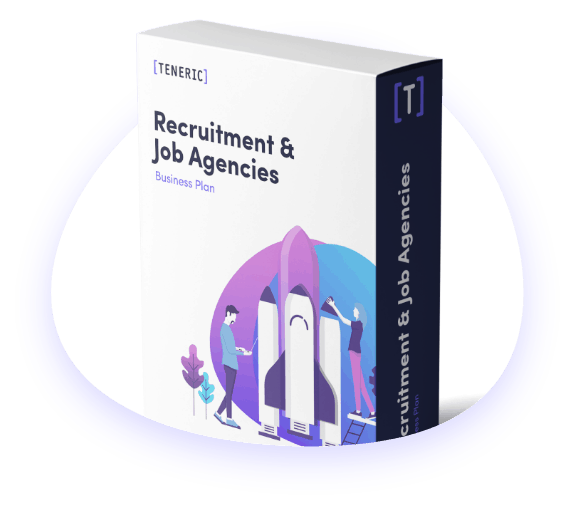
Is opening a recruitment agency for you?
- How much does it cost to open a recruitment agency in the UK?
What's included in our recruitment agency business plan?
- Your free sample recruitment agency business plan template
Summary and recap
As we’ve already mentioned, there is great potential in the UK for recruiters, and the turnover could be really significant. However, with the popularity of the industry comes a lot of high level competition.
Before you do anything else, you should be clear on who your competitors are, who your clients will be and how you will reach them, as well as fees you might have to pay whilst setting up.
You should start with a business plan. You can use it to gather and collate all of your resources, ideas and research.
You should consider things like:
- How many large recruitment agencies operate in the area (Adecco, Impellam, Reed etc.?)
- How many local recruitment agencies operate in the area?
- Is there likely to be any existing brand loyalty in the area?
How much does it cost to start a recruitment agency in the UK?
The average start-up costs to set up a recruitment agency in the UK vary considerably. More expensive start-ups will cover the costs of leasing premises, employing staff, buying equipment and any insurance you might need.
Key costs of starting your recruitment agency include:
- £12 to register your company, and £30 a month for details such as creating a website, designing a unique brand, setting up a LinkedIn company page and advertising jobs.
- You could also pay for added extras such as LinkedIn Premium and a CRM (Customer Relationship Management), a system which manages interactions with customers through data analysis, to win you as much business as possible.
However, there are ways to set up a recruitment agency without having to pay out thousands at first. By starting out as the sole employee, and even working from home, you can reduce costs to a bare minimum. All you really need is your home PC, mobile phone, some basic web tools and an internet connection.
With this in mind, a recruitment agency business plan is the best way to prepare yourself and plan for any financial obligations from the very start. We can also help you to figure out how to raise the capital you need for your business, based on your current financial situation.
We’ll take you through every step you’ll need to take to start your recruitment agency. It’s important to remember that if you plan to secure funds from a bank, it’s essential your business plan is as rigorous as it can be.
Included within our recruitment agency business plan, we offer:
- A fully completed recruitment agency business plan
- Break-even analysis (12-month analysis)
- Complete business plan guide
- Business plan template (.doc and .PDF)
- Financial planning wizard
Along with that, we’ll offer you a further 25 (at least) ways to market your recruitment agency for free. All of this is at your fingertips.
Download now for only £49
In this guide, we’re going to take you through an outline for a recruitment agency business plan, detailing what you should include within each section, and things you should consider when pitching your business to investors.
However, please remember this is only a guide. When writing your business plan for your own recruitment agency, make sure to take your time and work through everything in scrupulous detail.
When it comes to a business plan, the more thorough the better. You can never over-plan when it comes to a business start-up.
Step 1: Executive summary
Imagine you are pitching your business to an investor, what would you say? Remember that banks and investors will have seen thousands of previous pitches, so you really need to stand out to grab their attention. Putting serious thought and effort into your executive summary will be well worth it.
Make sure to think about these three things:
- Keep your language clear, concise and easy to read. Make it short and sweet.
- What makes you stand out from other recruitment agencies?
- Why should they be confident they will get their money back?
Remember, this is your opportunity to convince investors of your business’ credentials. Keep it positive, clear and easy to understand. Don’t get drawn into detailed descriptions or explanations, and avoid technical terms and jargon. Go out and grab their attention.
Step 2: Company overview
The company overview is your chance to properly introduce yourself and your business. You can give your potential investors a more detailed insight into how you plan to make sure your recruitment agency is a success.
Always remember, your focus should be on why investors should choose to put money into your recruitment agency, and why they should believe they’ll make a return on their investment.
You can consider including the following ideas in your company overview:
- What previous experience do you have managing a business
- What made you decide to start a recruitment agency?
- How will you stand out from your competition?
- Exactly who are your target clients? Do you have an ideal customer?
- What is your current financial status?
You need to show that you have a good understanding of the recruitment industry. Let them know the extent of your knowledge of the current market, how you expect it to change, and how your company is suited to thrive in the future.
You should think like a business person and don’t give your investors any reason to doubt your command of the subject.
Some other things to consider include:
- How you plan to expand your recruitment agency in the future.
- Your local market and competition.
- How is your application different to the others your investors have seen?
Basically, the goal of your company overview is to deliver a complete outline of your recruitment agency to your potential investors. Make sure to include facts and figures, and show off all your skills and expertise.
Feel overwhelmed? Not sure where to start? We’ve done all of the hard work for you.
Instant download for £49
Step 3: Management and key personnel
A business is only as good as the people behind it. To really make your recruitment agency a success, you’ll need the support of a great team. In the management and key personal section of your plan you should detail your management, staff, and plans for further growth.
Remember to include:
- Staff members and their roles at the agency
- The previous experience of your staff
- Your staff salaries
- Do you plan to bring new people into the business? If so, when? How many? And what kind of salaries will they be paid?
This section really doesn’t need to be too long or complicated. All investors want to know is that you have a solid management structure and that you’ve made some plans for expansion in the future where necessary. As long as you’ve shown this, you’ll be just fine.
Step 4: External analysis (market research)
It’s crucial to have a strong understanding of your market before launching your start-up. It will help you recognise opportunities for your company to benefit from, and identify threats before they can damage your business.
Make sure you know the competition. What will make you stand out from them?
In this section you’ll also need to look into your target market, and how you’ll attract them over the competition. You should try to make this as detailed as possible, so that investors can see the focus of your agency. Being too vague might lead potential backers to believe you haven’t put much thought into it.
Who’s going to use your recruitment agency? (your target market)
Are you going to focus on recruiting in one particular industry? Or perhaps you’re going to specialise in junior or graduate roles? You need to know who your clients will be so you can tailor your marketing and branding to suit them.
Some things that you should think about include:
- How will you get the attention of clients?
- How much will you charge your clients?
- What will make them choose you over other competitors?
- How can you gain their loyalty?
How many recruitment agencies operate in your area?
In order to attract business you’ll have to stand out from other recruitment agencies that operate in the same region. How do you plan to separate yourself from your competition? Investors might be concerned about market saturation, and you need to prove to them that your agency has more to offer than any other around you.
Some things you can think about:
- How much do you know about your competitors?
- How many large recruitment agencies operate in your area?
- What are the average costs of employing a recruitment agency?
- Do they specialise in any particular industry? How does this compare with your own business?
Put yourself in the shoes of your ideal customer. What is going to make them choose you over another agency?
Step 5: your business objectives
Your business is going to need to have objectives, both for the short term and the long term. These objectives should be an outline to potential investors of what you are expecting to achieve over a time-frame.
Think about where you want your company to be after a month, then six months, a year and even five years. Don’t go crazy though. Ambition is good, but you shouldn’t be suggesting your business is going to become a giant of the industry after the first couple of years, as you will just come across as naive.
You should try to use the S.M.A.R.T criteria to keep track of your objectives.
Your S.M.A.R.T Criteria are:
If you still need some help coming up with objectives, you can consider some of the following:
- How big is the market you’re targeting?
- How do you plan to reach that market?
- How many clients do you expect to have after the first two months?
- How much revenue do you expect after the first six months?
Along with each objective you should provide a plan, as to how you expect them to be achieved.
Step 6: Services, equipment and amenities
By giving a detailed list of all the equipment you need to start your recruitment agency, investors will be able to see what their money is paying for.
This will depend very much on the scale of your planned agency. It would be possible to start by working from home with just your home PC and personal mobile phone. But if you’re thinking bigger, some items and services you should think about would include:
- Office space, along with desks and chairs
- Work Mobiles and mobile contracts
Be realistic in this section. You don’t need twenty PCs if you’re only employing a handful of staff. There’s no point in overspending.
Step 7: Financial forecasting and financial projections
This is the section where we crunch the numbers. Financial forecasting is probably the most important part of your business plan, as you can prove to investors that they will get some return on their investment.
This might be the trickiest and most time consuming part of the whole plan, but it is essential to do it properly.
You’re going to have to show your potential backers how you’ll recuperate the money they’ve invested. How much can you make per client? How many clients will you have?
The fundamentals you’ll need to provide:
- Sales forecast
- Expense budget
- Cash-flow statement
There are a whole lot of things you’ll need to budget for. Some of those might include:
- Purchase estimations
- Hiring costs
If possible, don’t restrict yourself to just one avenue of revenue. Diversifying your income sources will make investors feel much more comfortable with their investment.
We’ve taken all of the hard work out of planning the finances for your recruitment agency. Download your recruitment agency business plan template instantly below.
Instant download
Step 8: Funding
Do you already have existing financial support? Your investors will need to know how much start-up capital you have, and where it’s coming from. You need to let them know whether you’re using money from your own pocket, or whether you have investments from some other backer.
You might have received funding in the form of:
- Personal loans
- Partners or sponsors
- Family and/or friends
Be completely clear about where your money is coming from. Don’t hide anything from your investors.
You also need to be explicit about how much money you need, both now and in the future. You should also detail to investors how you’ll be spending it, whether it’s for equipment, renting premises or paying staff.
At the same time, don’t ask for more than you need, as it’s only likely to put investors off
Your free sample recruitment agency plan
If this is all still seeming a bit overwhelming, you might like to take a look at a small template we provide for a recruitment agency business plan. This can get you started and help you to come up with some of your own ideas.
Included in this template, you’ll get:
- An example of your executive summary
- Products/services on offer
- Staff and management structure
Download .doc here
Launching your own business is a scary prospect. The recruitment industry is already a busy market, but there’s plenty of demand for it and forecasts anticipate its boom to continue. There are over 31,000 recruitment agencies in the UK, with a combined value of over £42.3 billion.
By creating a detailed and clear business plan, you’re giving yourself the best chance of success. You’ll be able to start out knowing you’ve considered every aspect of the business. Investors love an in-depth business plan, so remember: the more detail the better. With our experience, you can kick-start your agency with confidence.
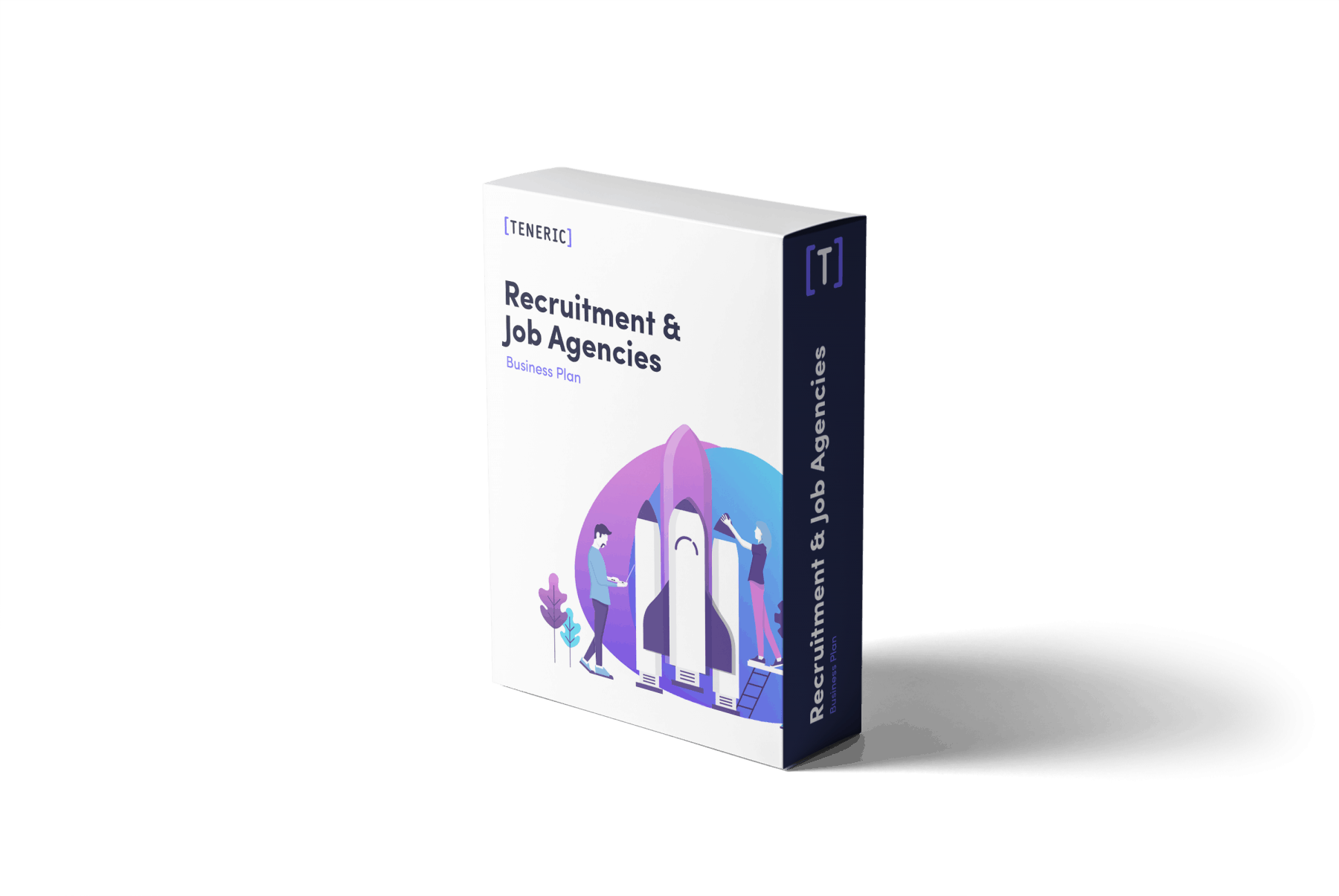
Download the Software
Complete recruitment agency business planning package.
Customer Testimonials
“I needed to put together a long-term business plan to cover all aspects of my new venture. I read a lot of books and attended courses, but I was struggling. Then I came across Teneric and suddenly it was all there in a format I could use and in terminology I could understand. After that, it was plain sailing to the Business Department at my local HSBC Bank”
Jill Shilcock, Managing Director, SEAS Education Advisory Service Limited.
“I wanted ideas for the type of information that needed covering in a business plan, and this gave me a template for the document I submitted to the bank. The business loan we were after was approved. If you have never written a business plan before, then I would recommend your product. It was very straightforward and offered some good advice.”
Gordon Mitchell, UK
“I needed a business plan quickly. The template was easy to use, just fill in the blanks on the wizard and refer to the help guide if I wasn't sure. Your system is good value, and I would recommend them to everyone needing a plan. Attached is the basic plan I threw together in a day for the bank. They specifically wanted cash flow projections, and the Excel spreadsheets were really what I was after from your product.”
John Waterhouse, UK
- Content Library
- Events & Webinars
- Partner Integrations
- Request a Demo
How to Create Your Recruitment Plan for 2024
Many talent acquisition leaders agree the best way to create your annual recruitment plan is to learn what did and didn’t work with your last recruitment strategy.
These TA leaders recommend conducting a retrospective that covers high-level metrics and progress (e.g., overall recruitment budget spent, hiring plan goals met) and more specific objectives (e.g., candidate experience ratings, social media job ad engagement).
Lever Director of Recruiting Caitlyn Metteer mentioned how analyzing your hiring team’s sourcing, nurturing, and interviewing efforts from the last calendar year is the best way to improve your recruitment model and hiring process next year.
“Assessing your recruiters’ efforts to convert potential candidates into new hires can help you refine your team’s recruitment process, address any hiring manager issues, drive down cost per hire, and ensure your headcount grows to meet your business needs,” said Caitlyn.
4 factors that should inform your talent acquisition team’s recruitment plan for 2024
Of course, you need to evaluate and address more than just your people and processes to create a highly effective recruitment plan for your team for the year ahead.
You must also determine if your existing applicant tracking system can help your team better identify and engage candidates efficiently and effectively and streamline your recruiters’ work.
Aptitude Research Founder Madeline Laurano explained to SHRM how “HR and TA leaders are prioritizing candidate relationship management (CRM) solutions ” and ditching their dependence on old-school ATS without CRM functionality.
This increased investment isn’t just to help TA leaders empower their teams to recruit smarter.
Paradox VP Client Advocacy & Marketing Josh Secrest told SHRM recruiting tech “plays a crucial part in why the best recruiters stay in their role and why they also might look elsewhere.”
With that in mind, here are four tech-related considerations for your 2024 recruitment plan that will impact how well your team connects with and converts high-quality candidates .
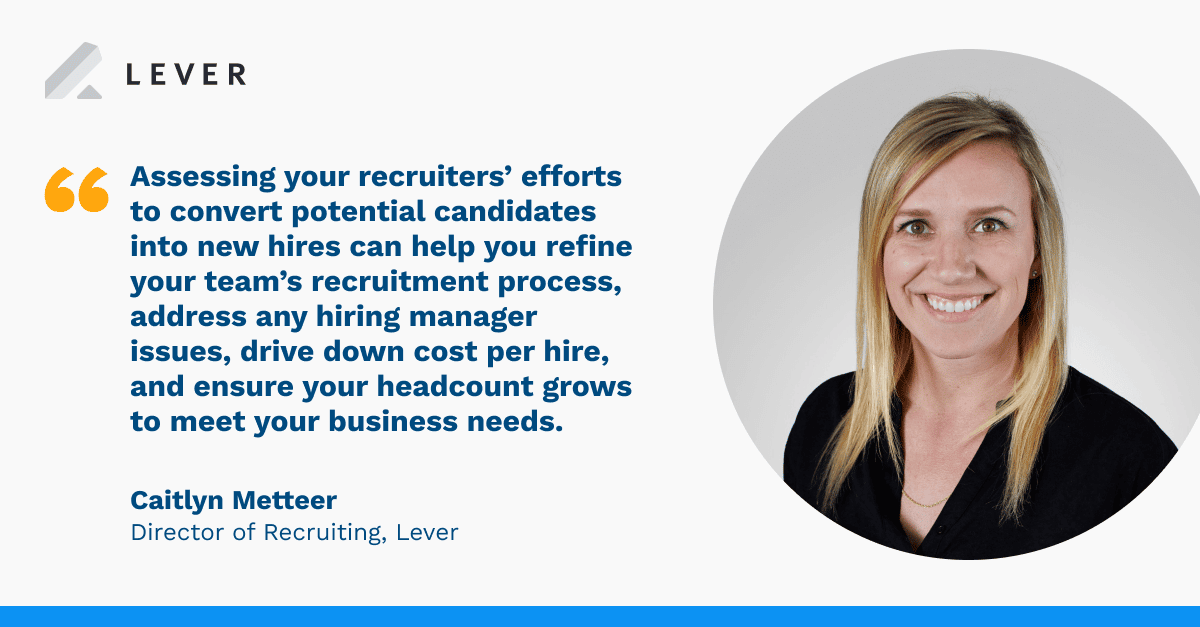
1) Audit your entire talent acquisition tech stack
A recent Talent Board report found one-quarter of talent leaders said their standalone ATS doesn’t easily connect with other recruiting tools in their tech stacks.
More than one-third of talent acquisition directors are also concerned their tools won’t sync with their ATS because it’s a legacy offering.
Want to avoid ending up like these talent leaders? Make upgrades to your tech stack (perhaps an old-school ATS) a primary focus with your 2024 recruitment planning.
Some key questions to ask about your TA tech stack during an audit include :
- Does your ATS offer robust, easy-to-use CRM capabilities?
- Is your candidate data centralized in your ATS, or is it stored in multiple systems?
- Can your recruiters easily and quickly find the info and data required to succeed daily in your ATS (e.g., details on active and archived candidates, pipeline insights)?
- Do other essential tools (e.g., background check tools, team collaboration platforms) and the most popular job boards directly connect to and share key data with your ATS?
- Does each team member have a custom data “view” in your ATS (e.g., recruiter operations dashboard for talent ops managers, team overview dashboard for talent leaders)?
Talent analytics is an important element of the modern TA tech stack.
“Data-driven recruiting is now table stakes for all talent teams,” said Caitlyn. “Fail to provide your recruiters with an intuitive and advanced TA analytics solution, and you won’t be able to compete for talent at the level desired by your C-suite and hire highly qualified candidates.”

2) Assess every aspect of your full-cycle recruiting
Securing the right TA tech is vital. However, your recruiters need to make the most of their central recruiting solution to effectively advance candidates through their funnel .
As a talent leader, you must assess their progress (or regression) in areas including :
- Sourcing : Evaluate your sources and source origins (e.g., organic job board posts, paid ads and InMail). Lessen reliance on “weak” sources and prioritize “strong” ones.
- Job postings : Ensure your job listings have inclusive language, spotlight your company culture and employer brand, and feature engaging copy. Also, adjust job descriptions in postings that tend to generate few applications.
- Nurturing : Analyze your nurture engagement data. Look at open, reply, and conversion rates for emails (and, if applicable, texts) your team sent to candidates in 2023.
- Interviewing : Address any interview process issues. For instance, eliminate or shorten any interview stages you deem took too long to complete, on average, last year.
- Workflows : Adjust recruitment automation workflows in your primary recruiting software to ensure each recruiter’s work is highly streamlined and structured .
“No full-cycle recruiting strategy is perfect,” said Caitlyn. “But regular, data-backed alterations to your team’s daily activities and recruitment model at large can help you consistently improve core metrics tied to your team’s speed, quality, efficiency and productivity.”
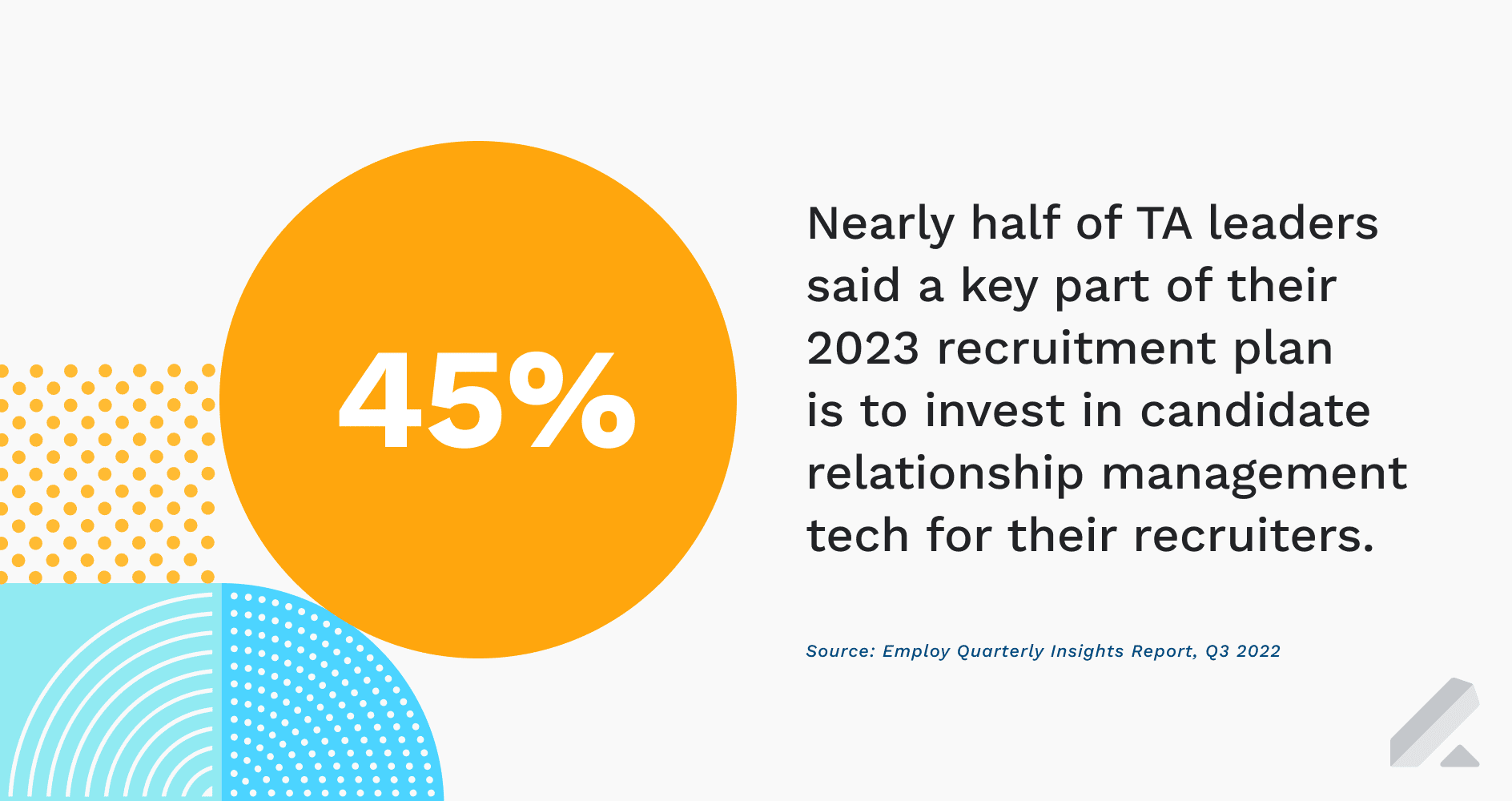
3) Chat with HR, your C-suite, and hiring managers
These three stakeholders can offer invaluable insights you can use to build your recruitment plan. The key is proactively engaging them to secure the data, info, and preferences that will inform your TA resource allocation in 2024 .
Speaking with these hiring team members and executives ultimately helps you :
- Understand which business units and locations are top priorities in 2024 in terms of headcount growth : The more information about your company’s specific hiring needs you can get from your CEO, CRO, CHRO, and other business leaders, the stronger your recruitment plan will be.
- Gauge hiring managers’ satisfaction with your recruiters’ efforts to fill roles over the past year : These chats will help you learn if they were happy with new hires and if they thought the average time to fill for open positions aligned with their timeline expectations.
- Get insights on skills gap analysis your HR team and leadership team conduct : This analysis typically takes frequently year-round. But many C-suites and CHROs tend to conduct an end-of-year skills gap analysis to identify immediate role- and team-based needs companywide.
“Dedicated one-on-ones with these business leaders and people managers will take time,” said Caitlyn. “But, the insights you will glean from these discussions will prove more than worthwhile to your recruitment planning .”

4) Keep your entire recruiting staff in the loop
Don’t forget to share your ultimate recruitment plan — including changes to tech they’ll have to use in the year ahead (and related processes) — with your recruiting staff.
“You likely already schedule time at the end of the year to go over insights tied to your recruiting performance and hiring data with your team,” said Caitlyn.
“Use this time to also explain what will change in the year ahead in terms of your technology and standard recruiting processes for your team,” she added.
Caitlyn added this transparency can instill more trust in your recruiters, who will understand why you’re making changes to the way they work and how those changes will help them improve their output and achieve KPIs.
Talent leaders must also detail what training will be needed for any new tech that will be onboarded — especially if that solution is a new TA suite to replace a legacy ATS .
Note who will teach recruiters how to use new tech and who TA specialists should turn to internally (e.g., talent operations, IT) and externally (e.g., your ATS vendor’s support staff) when they need guidance on how to best use the tech.
“This hands-on guidance and education will ensure your entire team hits the ground running with your new platform of choice from day one of implementation,” said Caitlyn.
Chat with the Lever team to learn how you can build a data-driven recruitment plan using LeverTRM as your talent team’s primary ATS + CRM solution in the years ahead.

Further reading
The ultimate talent search guide: hacks that give mid-sized businesses a competitive advantage, best talent acquisition software: a toolkit for employers, how does an ats work with an hris .

How to write a business plan for recruitment (template included)
- Published on September 23, 2022
Writing a business plan in recruitment has always played a crucial part in the interview process for a number of recruitment agencies around the world.
A comprehensive business plan can demonstrate a recruiter’s commitment, knowledge and commercial acumen. During COVID-19, these qualities are more important than ever and we’re seeing an increase in the number of agencies asking for such a document.
Arriving at an interview armed with a comprehensive business plan before you’re even asked will no doubt set yourself apart from other recruiters.
During these challenging times, managers will need to present a business case to leadership for budget approval in order to make a hire. Your business plan will be an important element of this business case. An impressive business plan could be the difference between landing an offer today, or falling into a pipeline of other candidates or even getting rejected.
In this article, we share a step-by-step guide outlining how to create a comprehensive business plan. We walk through the key components and include examples.
At the end of the article, you can download a free recruitment business plan template which is tailored towards the key components mentioned in this article.
A business plan should be packed full of relevant information but should be compressed and to the point. Avoid verbiage, stay specific and keep to 4 – 6 pages.
Introduction
Start with a title. Include your name and the company you’re writing the business plan for. A little personalisation will go a long way.
Underneath your title, outline the objective of your business plan and again personalise it towards the agency you’re interviewing with. While you have the hiring manager’s attention, this paragraph is an opportunity for you to demonstrate how comprehensive your business plan is. The aim is to capture the hiring manager’s interest so they continue to read each component:
“The objective of this business plan is to outline the value I can add to employer’s name .
In this business plan, I have highlighted my specialism, hiring activity in my market, my candidate and client strategies, my methodology, how I plan to recruit through COVID-19, my competition, my personal revenue projections over 12 months and lastly a suggested solution to reducing my cost during COVID-19.”
You can use this paragraph as a way to introduce your business plan verbally if you’ve called up a hiring manager. You can also use this extract in a cold email.
Your specialisation
This is a crucial positioning statement for your value-add. It sets out precisely where your network and experience lies and what you intend to bring to the table in your new role.
Your specialisation can be described clearly by outlining what roles you will specialise in, what industries you will target, what level of seniority you will focus on and what geographies you will cover.
For ease of reading, you can use each component as a title and use bullet points to expand upon your answers.
Taking a Technology recruiter as an example:
What roles I will specialise in:
- Product Management permanent roles
- UX/UI Design permanent roles
What industries I will target:
- Series A – C funded technology startups (high investment, high growth and high volume of roles)
What level of seniority I will focus on:
- Mid to senior (120 – 180k salary range for Product Managers, 140 – 200k salary range for Designers)
What geographies I will cover:
- Based in Singapore, the local market will be my core market
- Secondary markets include Jakarta, Bangkok and Kuala Lumpur due to less competition from recruiters and high volume of roles
Hiring activity trends
The hiring activity trends section provides an opportunity for you to demonstrate and portray your knowledge of the market.
The 3 important components of this section are: hiring activity over the past 3 years, hiring activity during COVID-19 and how you predict hiring activity to shift post-COVID-19 recovery.
Utilise your own knowledge of the market but back it up with research gained from reputable sources related to your market e.g. Tech in Asia, Tech Crunch, Channel News Asia, The Straits Times or The Financial Times.
You’ll want to cover how hiring activity has increased or decreased, what the drivers of growth are in your industry and what the threats and challenges are within your sector.
Candidate strategies
Moving on from market trends, this section indicates how you will acquire candidates for your desk. It offers an opportunity for you to demonstrate the experience you’ve learnt in candidate management from your previous firm, but also an opportunity for the employer to ensure that your approach aligns with theirs.
3 key components of this section include: how you will generate candidate leads, what challenges you expect to face and how you will overcome these challenges.
Taking a Front Office Banking & Financial Services recruiter as an example:
How do I plan to generate candidate leads:
- Direct headhunting using a LinkedIn Recruiter account, this costs approximately $X amount, the key benefits being access to a high volume of InMails and enhanced search capability. This has been the sourcing tool for 60% of my previous placements
Challenges I expect to face:
- In light of COVID-19, highly sought-after candidates may be risk-averse and may not see this as a good time to move jobs
How I will overcome these challenges:
- I will develop relationships with these candidates for the future but I will adjust my sourcing strategy accordingly by increasing volume of direct approaches. I will also focus on great talent who have been affected by COVID-19
Client strategies
A similar section to candidate strategies but geared towards clients. Arguably more important than candidate strategies during COVID-19 as the market is currently job-short – even in the good times, strong business development capabilities in recruiters are harder to find.
This section includes 6 key components including how you plan to onboard new clients, how you plan to sustain relationships with clients for repeat business, what industries your clients are in, the challenges you expect to face and how you will overcome these challenges.
Take these bullet points as a basic example:
How I plan to onboard new clients:
- During COVID-19, I plan to cultivate relationships by helping and consulting clients on non-recruitment related issues, such as advising clients on the current state of the market
- I plan to generate leads by making 25 cold calls per day during the ramp-up period, to again offer support and advice where needed, and to leverage any open roles
- A soft approach of connecting with hiring managers, HR contact and C-Level candidates on LinkedIn, to establish working relationships and eventually convert into clients
How I plan to sustain relationships with current clients and win repeat roles:
- The most important way to sustain relationships is by offering a service that is superior to competitors. That is by being transparent, sticking to deadlines and delivering results
- Regularly catch up with clients on a monthly basis to see how they’re doing and see if you can generate new roles
- Keep yourself updated on company news and congratulate clients on milestones e.g. if they generate a Series C round of funding
What industries I will target clients in:
- Series A – B funded technology startups
- Durving COVID-19 there is less of an appetite to use agencies due to an unprecedented volume of great candidates available in the market
- Offer free support to companies currently not using agencies, provide an impressive service and convert into paying client post-recovery
The 6th component is “examples of target clients” and this is where you can really demonstrate tangible market knowledge. Use company names, find the potential contact in each company and add your comments, such as the volume of roles you expect from that client. 5 examples should be enough to peak your hiring manager’s interest.
You can use a table to display this information with ease:
It goes without saying that you should never be tempted to use information that is proprietary to your previous employer. This information can be openly found with some basic LinkedIn research.
My methodology
Are you a recruiter that is focussed on crunching numbers? Are you a recruiter who is focussed on cultivating long-term relationships? In this section, you can include a few quick bullet points to explain how you approach recruitment. This information gives your hiring manager an indication about whether you hold similar values and whether you have similar working styles.
How you can adapt to recruiting during COVID-19
This section is a new one in response to current market conditions but can demonstrate how you are prepared to deal with current and upcoming challenges.
You can use this section as the title and include bullet points to outline how you will adapt to these market conditions. You can refer to this article if you want some tips on how to adapt to recruiting during COVID-19.
[INSERT_ELEMENTOR id=”15165″]
My key competitors
Which recruiters and agencies offer the greatest competition? Demonstrating your knowledge in this area highlights that you are commercially aware outside of your core market.
Include about 5 different competitors who are directly competing in your patch. You can use the table below to display this information:
Personal revenue and target projections
In many business plans, financial projections are of utmost importance and can demonstrate your commercial acumen. If you’ve ever watched Dragon’s Den, you’ll know what happens when you don’t know your numbers!
Project your personal revenue for 4 quarters. You can start your calculations by predicting the average annual salary of a candidate in your patch. You can project your average percentage fee agreed with clients and from there you can calculate your average fee. Once you have this, you can predict the amount of placements you’ll be making per month.
Make sure your revenue projections are realistic and achievable. Avoid the temptation to predict vastly optimistic revenues, especially during COVID-19. You must allow time to ramp-up and there must be a logical relationship between your historical and predicted revenues.
The plan only includes project revenue. Your historical revenue should be on your CV.
Take the below as an example:
My predicted average annual salary of candidates:
My predicted average percentage fee agreed with the client:, my predicted average fee:, my predicted average placements per month, my projected revenue over 12 months.
Underneath, you can also include the KPIs you will set yourself to guide you in achieving these numbers. For example, you can set yourself a guideline for how many CVs you need to send, how many candidate meetings you need to arrange, how many client meetings you need to arrange and so on.
My remuneration
This is not a standard component of a business plan but is included in response to COVID-19. As mentioned in my previous article , if you demonstrate your willingness to share the pain of your cost with an employer, it will go a long way.
My last drawn salary:
- SGD $5,000 per month
My expected salary:
- SGD $3,000 per month during COVID-19
- SGD $5,000 per month post-recovery
How I propose we can share the pain during COVID-19:
- Reduce my previous drawn salary by 40%
- Reduce the threshold of my commission scheme of 9x per quarter to 7.5x per quarter
- Agree to return to standard remuneration once I’ve hit personal revenue of $60k per quarter
The template
To help recruiters through these challenging times, we’ve constructed a free template built around the components mentioned above, so you can create your own for when you reach out to hiring managers.
To download this template, please click this link and you’ll be redirected to the template.
This step-by-step guide should give your hiring manager a clear idea of your plan. If executed successfully, you’ve already demonstrated your commitment, knowledge and commercial acumen before even attending an interview.
The way you’ve structured your plan will give your hiring manager a very clear indication of your methodology and whether you’d fit their structure. Keep in mind that if your methodology is focused on high volume recruitment, it’s not going to work well with an executive recruitment agency.
As a next step, learn this plan inside and out. Be prepared to pitch your plan to your hiring manager and answer detailed questions surrounding each component.
Leave your interviewer with no room for concern and secure that job!
Speak to a recruiter
I specialises in senior rec2rec searches in Asia. Get in touch with him to discover opportunities.
Recruitment search
We’re solving the talent crunch in Asia. Find out how we can introduce you to unavailable talent.
If you’d like to enquire about our services, please feel free to get in touch with our team.
Home » Blog » Where to start with a recruitment business plan
Where to start with a recruitment business plan
Rhys jones written by rhys jones managing director – davidson gray.
Rhys sold out of his previous recruitment businesses in 2012 to focus solely on helping recruiters set up and build recruitment businesses. Follow Rhys on LinkedIn or contact him direct here for help with your start-up recruitment business or for coaching to grow an existing one.
You’ll be pleased to hear that in my experience a recruitment agency start up business plan need only contain a few essentials and really isn’t rocket science. You only need a basic plan to start, well thought through definitely, but not War and Peace.
A start up recruitment business plan doesn’t need to be super sophisticated. However what you do need is a well thought through plan so you can build solid foundations for growth, remove as much risk as possible and allow you, once you go live, to concentrate on the exciting bit, BILLING, rather than working things out as you go along. The planning now will make the real fun part of making money so much easier with fewer distractions, and allow you to really enjoy being your own boss and owning your own business. So spend that time now, trust me it’s a fabulous investment and you’ll be grateful for it when you make a flying start in your new recruitment agency.
If you search on the web, you’ll find various contradictory ideas on what a business plan should contain, which can leave you worse-off than when you started, confused on which way is the best way. I hope in this series of blogs I can take some of that confusion away for you. I’ve been lucky enough to have hands on experience of building my first businesses from the ground up. Added to this, I improved my knowledge with additional learning gained at Cranfield Business School, which I applied to those early businesses and the many more recruitment businesses in different sectors I went on to set up, all of which are continuing successful companies. So with this experience, I’d like to think my ideas on recruitment agency business plans are worth considering (sorry if this sounds like I think I’m the Richard Branson of recruitment, it’s not meant to, but think it helps explaining my experience).
The common school of learning on business plans is to use the SWOT analysis, i.e. what will be the planned business’s:
- Opportunities
I don’t disagree that you could add this to your plan, and it’s handy to have in, but this series of blogs look at what I feel are specific and essential to a recruitment business plan (plus the bits you may not know if you’ve never set a business up before). Where to start.
To see if you do have the basics of a business in you, I advise firstly to look at the sales and cash flow forecast. If your business idea doesn’t pass this test, you need not waste your time any further – your business just won’t fly. So let’s start with the engine of the business, money in.
Your Sales Forecast
To allow you to write your cash flow forecast, you’ll need a well thought through sales forecast.
There’s lot to consider here, a lot more than first appears. You can’t just take what you bill now and assume you can simply replicate that without understanding where your current billings come from. So, below are ways to stress test where your current billings actually come from by looking at where you get both your vacancies and candidates.
Candidate Attraction
Needless to say finding good candidates is critical to your placements, so you need to make sure you have thought about where you will get them from. To help understand where you are currently successful, I suggest you look at your last six months’ billings and write next to each candidate placed where that candidate came from. Was it a headhunt call, a referral from previous candidates / clients, was the candidate off the business database, were they from a job board, social media, LinkedIn, Twitter etc? This is a real life study based on you, and how you are currently successful. It’s invaluable to understand what you will be able to easily reproduce when working for yourself e.g. headhunt calls, LinkedIn etc. and parts you may need to make up for e.g. candidates who came from a database search. So this will help you appreciate how easy or not candidate attraction will be for your sales forecast. It will also help get you thinking what you can do to make up for any tools you have now in the workplace but won’t have when you leave. Plus, if it’s job board centric then this is a cost you need to add to your cash flow plan. I’m not going to go into how to improve your candidate attraction here (that will be another blog) but if you’re currently very dependent on the company database, this should ring alarm bells and you need to think ahead and plan how to recruit successfully without it. And try applying these new techniques now whilst you’re still employed to perfect them so you can add their added sales value to your plan with confidence.
Client / Vacancy Attraction
At this stage it’s pertinent that I bring up the potential handicap that your current employment contract’s restrictive covenants may have on your planned client base. The current widely accepted covenant, i.e. what the courts see as ‘fair and reasonable’, is that you can be restricted from trading with any clients you’ve had ‘material dealings with’ over the last twelve months with your current employer, for the next six months once you leave (any more than this is seen as unreasonable).
Now this isn’t to say if it’s in your contract that means you’re definitely frozen out from this potentially lucrative group of businesses, there could be errors elsewhere in your contract that makes this void. So get it legally checked and from a commercial angle if you can. Law isn’t black and white and getting good commercial legal advice is hugely valuable which is why I use Barrister Greg Walsh of Greg Walsh Law for my Davidson Gray partner businesses. I see it as that valuable to get good quality advice. But if your current clients are off limits for the first six months, work this into your plan. Next, go back again over the last six months’ placements and mark where your clients/vacancies came from as you’ve done for your candidates. Do the clients come to you for you, or because of who you work for, are they from a PSL you won’t be on, were there any from a mailshot, new business cold call etc? This will quickly show you where your current vacancies come from so you can write your sales forecast from a true picture of what you can and can’t replicate easily. Plus, if some methods you use now to gain clients are removed or won’t be as effective once you leave, you have time to plan new business development and marketing initiatives to replace this business. And as with the new candidate attraction strategies, see how they work where you are now, but maybe not too much, you don’t want too many new clients your covenants could restrict!
The sales forecast itself
Once you’ve considered the above, you will be able to see more clearly what tools and advantages you currently benefit from where you work. It should now be easier for you to write a realistic sales forecast. I find it helpful to write two sales forecasts, one you feel is realistically achievable and one that you feel is the absolute minimum you’ll achieve. The bare minimum one is important in your cash flow forecast. You don’t want to get five months in and run out of cash, so if you know the bare minimum you’ll achieve, you can see how much of a cash buffer you’ll need. The realistic forecast is the one you plan for with the activity you expect to hit, the KPIs you set yourself etc. Plus this can be your motivator, as you should be earning a lot more on this forecast than you currently are very, very quickly!
So simply start with month one, and take it through to month twelve. You can’t realistically predict year two in a start-up. You will learn a lot midway through year one and you can use this learning for year two’s forecast.
Once you’ve done your sales forecast, you can use this in your cash flow forecast. I will go into this in my next blog where I’ll explain how you can get a very good idea of how much it will cost to set up a recruitment business , running costs, and net profit month by month.
I hope you’ve found this second blog in the series helpful, and as always if you have any questions, feel free to contact me. You can find me on LinkedIn under my main business name of Davidson Gray.
Interested in working with Rhys to grow your start up?
Rhys not only provides the start-up infrastructure for your new business and all the support services your business will need, he can actually work with you to grow it. Take advantage of as much mentoring and coaching as you would like, plus Rhys considers himself a working partner and will take responsibility for the areas that you’d like him to, perhaps those you have the least passion for e.g. Finance and Digital Marketing. When working together on the business’s growth strategy, much of the effort to deliver it can be delegated to the Davidson Gray team.
Book a chat with Rhys here.
Don't forget to subscribe for new content!
Wherever you get your podcast content

- Setting Up a Recruitment Business
- Growing a Recruitment Business
- Managing a Recruitment Business
- Recruitment Tips
- What you need to know to perfect your headhunt
- A recruitment business partner is for life, choose carefully!
- How to pitch for recruitment business investment
- How to use success ratios to produce recruitment KPI’s that WILL work
- How to deliver quality headhunts that WILL win more business.
- Top 7 Reasons To Set Up A Recruitment Business
- Why Recruitment Owner/Managers Need to KPI Themselves for Real Business Growth
- Is building a recruitment business to sell a good idea?
- So you want to be a Headhunter?
- Why bad managers give recruitment KPI’s a bad reputation

A guide to using LinkedIn Recruiter
In this blog, aimed at recruiters, we examine the potential LinkedIn Recruiter options in more detail and find out what you get for your money and how to make the most of the investment.

How to grow your recruitment business in 2023
What does it take to grow a recruitment business in these uncertain economic times? In this blog, originally published in The Global Recruiter, Rhys looks at what it takes to grow a recruitment business in 2023.

Leadership or management – what’s more important to a growing recruitment business?
Leadership or management – which one’s the more important skill to have when growing your recruitment business? We’ll look at why it’s crucial to have both and when to use them to greatest effect.
- London : 0207 127 0661
- Manchester : 0161 327 3279
- [email protected]
- Privacy Policy
- Cookie Policy
Copyright © 2021 Davidson Gray Business Solutions Ltd
Latest Blog Posts
Leadership or management - what's more important to a growing recruitment business, why business owners should never take their staff for granted., what is recruitment factoring and why do we do ours in house, how to choose a crm for your new recruitment agency, useful links.
- Case Studies
- SME Coaching
Don't bother with copy and paste.
Get this complete sample business plan as a free text document.
Employment Agency Business Plan
Start your own employment agency business plan
All About People
Executive summary executive summary is a brief introduction to your business plan. it describes your business, the problem that it solves, your target market, and financial highlights.">.
All About People (AAP) began out of the desire to contribute to this community, just as communities have fed All About People’s proprietor over the years. Although originally from a larger market, the proprietor realizes the need in the southern Willamette Valley for a personnel agency that fills a void left by other temporary and permanent placement agencies. AAP matches specifically skilled workers with clients, saving businesses time and money, while providing for its employees with honesty and honor. This requires a high level of communication. It means asking open-ended questions and listening, not talking. This means knowing the local market so AAP can really serve each client and employee, not just “sell” them our goods. AAP is quality service.
The long-term vision includes a number of offices throughout the southern Willamette Valley. The proprietor sees the challenge in this vision, not in the growth itself, but in training and encouraging all AAP personnel to treat each client and employee with the same care and with the same level of communication.
Managing our Growth AAP is a sole proprietorship that will convert to an S Corporation. As a new corporate entity, AAP will be treated as a start-up in this business plan. During the past couple of years the proprietor provided all services. In Year 1, the company will add a part-time office staff person and an employment specialist. In response to this growth, AAP will have a procedures manual for in-house staff to assure that the information is clear. In addition, AAP will provide employees with regular training within the divisions to assure they understand the details of the work they are doing daily. Year 2 projections include a receptionist, another employment specialist, and a field representative. In Year 3, AAP will examine the feasibility of opening a branch office in the Salem, Bend, or Medford/Ashland areas.
The Market AAP is structured like other temporary and permanent placement agencies. However, it will serve clients with needs for select, specialized professionals rather than clerical or light industrial workers. Several businesses in Portland, Oregon provide a similar service to specific groups of people, but there are none for the Willamette Valley. AAP has five divisions, targeting the following areas of expertise:
- Editors/Writers
Event Planners
Graphic Artists
- Interpreters/Translators.
Services AAP will handle recruiting, including reference checks, skills evaluation, preliminary interviewing, and screening of all employees for its clients. AAP acts as an extension of the client’s human resource department, assuring that there is open communication between supervisor and employee, and assisting with any troubleshooting or problem solving that may be needed.
Financials The company’s start-up requirements are $55,464, of which $7,600 will be provided for by the owner’s personal investment. The rest will be obtained through loans.
We expect to be able to charge a 50% markup to our business clients. Thus, if an employee is being paid $10 per hour, we are charging the client $15 per hour. The company predicts that it will be able to produce sales of approximately $300,000 by Year 3. The company does not have any direct cost of sales; we track payments to placed individuals as regular payroll.
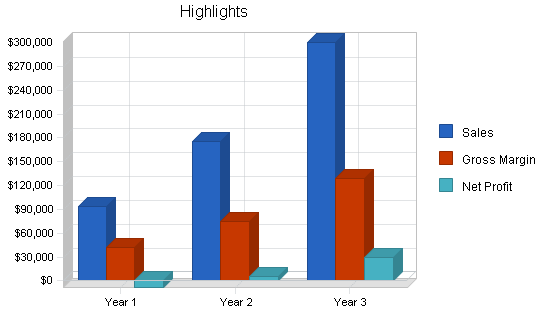
1.1 Objectives
AAP is structured like other temporary and permanent placement agencies. However, we serve clients with needs for select specialized professionals, rather than clerical or light industrial workers. Several businesses in Portland, Oregon provide a similar service to specific groups of people. AAP followed the model of one placement firm described below.
A contract engineering firm places temporary workers who are hardware and software engineers. Employees earn between $80- $100 per hour and approximately seven employees are placed per month. The firm recruits through its website, advertises in newspapers, magazines, and trade publications. Incentives offered to contingent workers include medical, dental, and disability insurance, 401(K), and a reference finder’s fee for placement referrals. They find their employees are 60 percent male, 40 percent female, and ages spread evenly.
AAP serves the business client by locating a professional worker, interviewing and screening that worker, setting up interviews if necessary, and administering all hiring paperwork. The company runs payroll and bills the client bi-monthly. AAP will also manage the professional, staying in close contact with the client and communicating with the worker regarding any personnel issues that may arise.
The professional worker is served with employment opportunities at no cost; pay rates that are within industry standards; and health insurance may be purchased, if a worker becomes eligible, at a group rate starting at $124/mo. AAP will pay $65/mo for any coverage chosen from the group package.
1.2 Mission
All About People’s mission is to contribute to the community by filling a need for specialized, professional, contingent workers. The company will provide workers with a safe and independent environment. It will also provide businesses with a high-caliber of employee available for project or permanent work. All About People listens to individual needs and customizes personnel solutions for both businesses and workers.
Company Summary company overview ) is an overview of the most important points about your company—your history, management team, location, mission statement and legal structure.">
AAP is a temporary and permanent placement personnel agency working solely with skilled, professional workers and Willamette Valley businesses. AAP differs from other temporary and permanent placement agencies because of our skilled workers. The company believes that the temporary industry pays only cursory attention to providing businesses highly qualified workers for permanent and non-permanent positions. AAP has five divisions, targeting the following areas of expertise:
AAP does not provide general clerical, light industrial, engineers, accountants, nurses, or other medical technicians.
AAP does the following for each client:
- Recruiting (reference checking)
- Skills evaluation (preliminary interviewing)
AAP conducts regular evaluations: AAP checks in with the supervisor and the worker during the first week on the assignment. AAP then checks in as agreed with the client. AAP acts as an extension of the client business’ human resource department assuring that there is open communication between supervisor and employee, and assisting with any troubleshooting or problem solving that may be needed.
Prior to opening our doors, research showed support for the development of a personnel agency working solely with professional contingent workers and Willamette Valley businesses (see topic 7.3 Supporting Research).
According to the Oregon Department of Employment, Lane County has 31 temporary agency firms with 3200 individuals employed. Total employment figures for Lane County are 250,000; therefore, we support between two and four percent of the population.
Through connections in a variety of areas, AAP is able to locate qualified workers not only through advertising, but through a channel of networking. This past year has shown that qualified, willing workers are certainly available as we currently have hundreds on staff willing and able to work.
2.1 Company Ownership
AAP is a sole proprietorship that will convert to an S Corporation. As a new corporate entity, AAP will be treated as a start-up in this business plan.
The sole proprietor, Sarah Wayland, can be reached at AAP’s office, [contact information omitted in this sample plan].
2.2 Start-up Summary
Projected start-up figures are shown in the chart and table below.

| Start-up | |
| Requirements | |
| Start-up Expenses | |
| Legal | $100 |
| Stationery etc. | $100 |
| Brochures | $164 |
| Insurance | $300 |
| Rent | $800 |
| computers, printers, software | $8,000 |
| Total Start-up Expenses | $9,464 |
| Start-up Assets | |
| Cash Required | $46,000 |
| Other Current Assets | $0 |
| Long-term Assets | $0 |
| Total Assets | $46,000 |
| Total Requirements | $55,464 |

| Start-up Funding | |
| Start-up Expenses to Fund | $9,464 |
| Start-up Assets to Fund | $46,000 |
| Total Funding Required | $55,464 |
| Assets | |
| Non-cash Assets from Start-up | $0 |
| Cash Requirements from Start-up | $46,000 |
| Additional Cash Raised | $0 |
| Cash Balance on Starting Date | $46,000 |
| Total Assets | $46,000 |
| Liabilities and Capital | |
| Liabilities | |
| Current Borrowing | $2,720 |
| Long-term Liabilities | $45,000 |
| Accounts Payable (Outstanding Bills) | $144 |
| Other Current Liabilities (interest-free) | $0 |
| Total Liabilities | $47,864 |
| Capital | |
| Planned Investment | |
| Owner | $7,600 |
| Other | $0 |
| Additional Investment Requirement | $0 |
| Total Planned Investment | $7,600 |
| Loss at Start-up (Start-up Expenses) | ($9,464) |
| Total Capital | ($1,864) |
| Total Capital and Liabilities | $46,000 |
| Total Funding | $55,464 |
The company is uniquely positioned to take advantage of this market opportunity because of the management and field expertise of the proprietor. Sarah Wayland worked in the temporary employment industry for three years with ADIA Personnel Services (now ADECCO) as Area Account Manager (in training as a branch manager): building business relationships; hiring employees; handling employee issues; working with clients during the implementation of ADIA; and opening an additional office in Beaverton, Oregon.
For one year the proprietor was a District Sales Manager at Columbia Distributing, showing a 10% increase on $3.5 million in annual sales. Managing a staff of nine in sales and customer service, she had the opportunity to delve further into hiring/firing, reviewing, incentives outside of salary, and personnel issues.
Most recently, she has spent several years as Funds and Contracts Manager at the Oregon University System; managing four grants totaling $1.5 million annually and all personal service and interagency contracts as well.
The proprietor’s most notable success was bringing the second branch of Cellular West located in Portland, Oregon, from running in the red, to breaking even within four months of its opening. She accomplished this by using motivational tools and providing the sales force with extensive training.
3.1 Products and Services Plan
Changing labor market conditions threaten the concept of full-time permanent employment.
AAP provides a complex blend of services to distinct populations. The company serves businesses through connecting them with the professional contingent work force. It also serves the worker by connecting them with businesses, at no charge, and providing benefits not often provided by other employment agencies.
Market Analysis Summary how to do a market analysis for your business plan.">
All About People (AAP) is a local firm that costs less than a consultant or agency, provides for both project and long-term needs, and has an easy, pay and billing rate system that covers employee payroll and worker’s compensation insurance.
There are a variety of reasons why businesses may need AAP’s services:
- Spikes in work load
- Business expands into an area that in-house expertise does not yet match
- Special events
- Pregnancy leave or sabbatical
- Business increases after layoffs
- Smaller business does not yet have staff on-hand to complete extra projects.
According to economic forecasters, employment agencies and financial services are expected to have the largest industry growth over the next 25 years. The trend toward businesses cutting back on employees and their benefits due to high costs creates the demand for AAP’s services.
Just consider the time, energy, and resources an employer may spend trying to employ a person for a 20-hour task.
In addition to the already lucrative temporary industry, several companies in the Portland Metro Area place professional contingent workers, but the southern Willamette Valley is not currently being served.
The company approaches businesses primarily through networking and cold calls. Our intention is to utilize a PR agency for more coverage as soon as possible. AAP is a member of the area Chamber of Commerce and actively participates in as many activities as possible, the proprietor is a member of the Women’s Business Network, the Professional Women’s Organization, and we are in the process of connecting with the Society for Human Resource Management. Prior to start-up, AAP also surveyed several area businesses about their use of contingent workers. The company will use its website and other marketing materials that describe what services we provide and explain how simple it is to work with us.
AAP advertises in local papers and trade magazines when absolutely necessary, but most often uses the Oregon Employment Department, both community college and university campuses, and the networking groups we are members of to search out the right employee. Prior to the sole proprietor start-up, the company started recruiting by administering twenty personnel surveys and advertising locally to create a staff of qualified contingent workers. This staff will be unaffected by AAP’s corporate restructuring.
4.1 Market Segmentation
The market can be broken down into two segments: the business market segment, and the employee market segment. Both of these segments are lucrative.
Business market targets: The company targets the University of Oregon, Lane Community College, the nonprofit organizations, the publishing industry, the advertising industry, and other large businesses.
Employee market targets: Editors/writers, graphic artists, computer specialists, event planners/fundraisers, and language translators/interpreters working in the business target markets listed above, as well as any applicants with unusual skills and talents.
4.2 Service Business Analysis
These charts demonstrate the types of workers employed, the type of qualified professionals on file to work for the company, and the types of businesses who have used AAP’s services. These statistics cover the 15-month sole proprietorship period from July 1, 1998 through September 30, 1999.
Types of workers employed by or signed up with AAP
|
| ||
| Computer | 34 | 24 |
| Editor/Writer | 20 | 25 |
| Event Planner | 13 | 10 |
| Graphic Artist | 10 | 13 |
| Language Interp/Trans | 13 | 17 |
| Other | 10 | 11 |
Types of employers using AAP
| High Tech | 14 |
| Nonprofit | 39 |
| Manufacturing | 18 |
| Publisher | 11 |
| Service | 18 |
Each and every contact is entered into the database-either in the professionals file if they are a potential candidate, or in the contacts file if they are another type of contact. The client and jobs files utilize the contact and client numbers to automatically fill in the information from the contact or client files. This means no duplicate typing. In addition, the contacts, clients, and professional files all have follow-up sheets attached making daily follow-up easy. Simply pull the file up for that day and all calls that need to be made that day will be marked.
Searching is easy. The check boxes within each professionals file allows us to check for singular or multiple skills and experience with a click and a return.
4.2.1 Competition and Buying Patterns
First form filled out from the moment the candidate calls. Three screens constitute one file: Personal Information; Job Information; Skills. The professional and contact files have a conversation record that will allow easy follow-up with a list daily of those records needing a call.
Interview Form
Directly from the employee forms the Employment Specialist can select the appropriate interview form. This form consists of three sheets: Basic Questions; Other Information/Recommendations; and Reference Checks.
Employee Profile Sheet
From the above information, a profile sheet is generated in hard copy for the inside of each file. This is our second backup system (besides the tape drive) in case of a power outage, etc.
4.2.2 Contact Sheet
This form is used for all other contacts. From here, a contact can be turned into a client by merely typing the contact number in on the client sheet, automatically bringing in all of the information.
4.2.3 Client Sheet
The client sheet is easily created by filling in the contact number. All pertinent information is automatically entered. The client sheet has its own contact sheet attached generating a daily follow-up list. The client files can also be pulled into a handy contact list.
Strategy and Implementation Summary
AAP is completely service minded, customizing personnel packages and offering the most it can to both employers and employees. The company brokers professional workers to Willamette Valley businesses. Because we serve two distinct groups of people, both businesses and employees will be considered equally important to AAP.
The company consists of five divisions, targeting the following types of workers and needs in businesses:
Computer Division
- Computer Application Specialists
- Computer Hardware Specialists
- Computer Programmers
- Network Administrators
- Web Specialists
Editor/Writers
- Multi-lingual
- PR/Marketing
- Fundraisers
- Large and Small
Language Interpreters and Translators
- Multiple Languages
- Person-to-Person
Within these categories, we originally set up a system of single sheets on card stock and filed them in binders. Since then, an electronic database has been created by one of our professionals. With the push of a button, AAP can search for a client or an employee needed.
Businesses and employees will be able to communicate with AAP via both new technological and traditional methods. Our Web page provides information about AAP including what professional fields we serve, what clients we are working with, and what services we offer. A second-generation Web page will provide information about employees for businesses through a password-protected area. AAP forwards candidates’ resumes and other information through a variety of methods: phone, fax, personal visit, mail, and the Web page.
In August 1999 we moved the offices to the center of town. Accounting is handled electronically by the proprietor through QuickBooks, with the complex needs handled by our CPA. All payroll is generated through the payroll service, Paychex. The office is furnished with all of the technology needed to operate on a daily basis, increase market share, and serve clients.
5.1 Competitive Edge
When a business is contacted and expresses interest in contingent employees that the company can provide, the following procedures will be followed:
- Consult with client and create a follow-up plan.
- Complete the contact, client, and job sheet in the database.
- Print one of each and forward a copy of the job sheet on yellow paper to the employment specialist.
- File original sheets in the appropriate binders.
- Search for matches in the database and pull each folder that looks like it will work.
- Review that folder to assure a match.
- Call each potential candidate and discuss the job and pay to its fullest.
- Fax, e-mail, or otherwise contact client with information and/or resumes for review.
- Schedule interviews or make a decision on appropriate candidates.
5.2 Sales Strategy
When an employee seeks to work with the company, the following procedures will be followed:
- Complete the professional’s form in the database.
- While completing this sheet, screen the employee for experience levels, requiring professional experience in each arena they wish to work.
- Set up an interview with the employment specialist if the professional is qualified.
- Create a file for each employee and place all paperwork, along with a copy of the professional’s form.
- Keep in touch with the professional quarterly if nothing comes up, more often if at all possible.
- When the professional agrees to a position, they will be supplied with an employee policy manual, pieces of letterhead for invoicing, and will complete the IRS I-9 and W-4 forms prior to beginning work.
5.2.1 Sales Forecast
Our sales forecast projections are presented in the chart and table below. Three years annual projections are shown in the table. The chart shows first year monthly forecast. First year monthly table is included in the appendix.
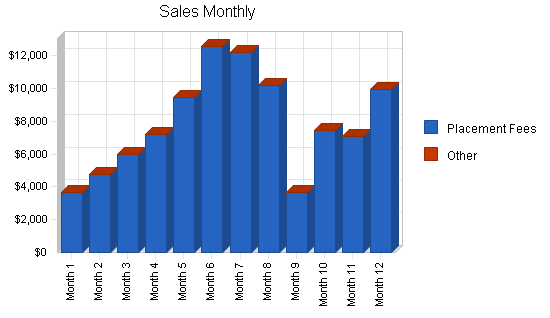
| Sales Forecast | |||
| Year 1 | Year 2 | Year 3 | |
| Sales | |||
| Placement Fees | $94,248 | $175,000 | $300,000 |
| Other | $0 | $0 | $0 |
| Total Sales | $94,248 | $175,000 | $300,000 |
| Direct Cost of Sales | Year 1 | Year 2 | Year 3 |
| Placement Fees | $0 | $0 | $0 |
| Other | $0 | $0 | $0 |
| Subtotal Direct Cost of Sales | $0 | $0 | $0 |
5.2.2 Target Market Segment Strategy
The pay rate data will be determined by changing market factors including business demand.
Our experience shows that the following is true in regards to pay and bill rates. A “good deal” for most temporary agencies is a 50% of pay rate markup. Thus, if the pay is $10, the bill is $15. However, we have traditionally used a flat markup that seemed appropriate. Pay and bill rates generally are outlined as follows:
Editors Most editors require between $25 and $35 per hour, and our history has shown a $10 per hour markup is acceptable. One exception is in the technical arena, garnering between $45 and $55 per hour pay; again a $10 per hour markup is typical.
Writers The only writing we have done is creative for [client name omitted], and we paid $15 with a $10 markup.
Event Planners Event planners often will work for between $12.50 and $25 per hour, depending on the length of the job, requirements, and experience needed. We find a $5 per hour markup on the $12.50-$17.50 is reasonable, and a $10 per hour markup on anything over $17.50 per hour.
Fundraisers Fundraisers can start at $10 per hour (nonprofit) and go up to $20 per hour. This usually depends on client and length of assignment. Bill rate markup for nonprofits is $5 per hour, others between $7.50 and $10 per hour.
Graphic Artists Entry level beginning at $12.50 per hour, intermediate at $15 per hour, and a top of the line professional at $25 per hour. The exception may run about $50 per hour. Bill rates are between $7.50 per hour markup ($12.50-$15), and $10 markup.
Language Interpreters This is a tricky arena. Pricing depends on the language (typical/atypical) and the length of the assignment. Interpreters have been known to work for as little as $15 per hour and for as much as $35 per hour. A $10 per hour markup is acceptable.
Language Translators This division is difficult as each language and situation varies slightly. Translators tend to work by page or by word. Technical translation can be as much as $.30 per word. Other translation can be $10 per hour (an hour a page). We are unsure of markup at this time, but would suggest 50% of pay rate.
Computer Specialists:
- Application-Starting at $12.50 an hour based on Xerox experience. Markup $5 per hour.
- Programmer-Starting at $20 an hour based on AlbertIQ experience. Markup $10 per hour at a minimum. Try for $15.
- Web Designer-Entry level positions can start at $10 per hour with a markup of $5. Project work typically starts at $15 an hour, markup at least $10 per hour.
- Administration-Pay rates range between $50 and $75 per hour, with a preferred markup of $25 per hour.
When determining the bill rate, additional expense factors to remember above the pay rate are 15% employer taxes, advertising, and staff time to fill the position.
5.3 Milestones
The company has an outstanding client list and an incredible number of qualified employees available. AAP has a good reputation for providing qualified people in a timely manner.

Management Summary management summary will include information about who's on your team and why they're the right people for the job, as well as your future hiring plans.">
In a variety of settings the proprietor of AAP has strong management experience. The proprietor has the skills to not only listen well, drawing out a person’s needs through open-ended questions, but also has the ability to recognize people’s strengths and weaknesses. She will draw upon this extensive successful experience in addition to the knowledge collected over a period of 18 years working professionally. Much of the “people” skills have been developed during the seven years spent in management roles. This experience, along with a varied background, supports AAP’s goals.
AAP’s objectives are threefold:
- To provide high quality, experienced, professional workers to businesses that are currently relying on the instability of word-of-mouth contacts, and are spending much of their time and resources (and, therefore, money) locating such workers;
- To provide these workers with a path by which to reach the employer without spending their own time, money, and energy finding the work; and
- To use this opportunity to make the contingent work force a better place for both the employer and the employee.
The long-term goal of the company is to franchise and/or to become multi-location, and eventually sell this business.
Management is a style, a belief, and a strategy.
In managing our clients, AAP will communicate regularly with them, setting up a schedule that meets their needs. The company will set goals for retention of clientele and strive to reach those goals by building relationships, listening to the client’s needs, and meeting those needs with a smile on our faces. We will take responsibility for our errors and the outcome.
In managing our workers, AAP will communicate regularly with them, providing them with an employee manual to minimize their confusion, and offer them the best pay and benefits possible. AAP will set goals for retention of employees and strive to reach those goals by treating each employee with respect, provide protection when appropriate, and do everything within our power to assure a healthy working environment.
This is a relationship business. AAP will manage all clients and employees through relationship building.
During 1998-99 the proprietor provided all services. In 2000 the company will add a part-time office staffer and an employment specialist. In response to this growth, we will have a procedures manual for in-house staff assuring that the information is clear. In addition, we will provide employees with regular training within the divisions to assure they understand the details of the work they are doing daily. 2001 projections include a receptionist, another employment specialist, and a field representative. In 2002 AAP will examine the feasibility of opening a branch office in the Salem, Bend, or Medford/Ashland areas.
| Personnel Plan | |||
| Year 1 | Year 2 | Year 3 | |
| Placed Employees Personnel | |||
| Placed Workers at 2/3 of Sales | $51,836 | $99,750 | $171,000 |
| Other | $0 | $0 | $0 |
| Subtotal | $51,836 | $99,750 | $171,000 |
| General and Administrative Personnel | |||
| Office Employees | $10,929 | $25,000 | $30,000 |
| Other | $0 | $0 | $0 |
| Subtotal | $10,929 | $25,000 | $30,000 |
| Total People | 0 | 0 | 0 |
| Total Payroll | $62,765 | $124,750 | $201,000 |
6.1 Payroll
All About People runs its payroll twice a month. Each professional will be given a check schedule when they work with AAP. Each check covers the previous two weeks.
In order to process payroll; AAP must receive a professional’s signed invoice the Wednesday prior to payday. The invoice, must be on AAP letterhead and include: name, social security number, mailing address, dates of work completed, location worked (at home, at the client’s office), one or two sentences describing what tasks were completed, and how much time was spent each day. At the bottom there must be a place for the client to sign and date in acceptance of the work to date. The original will be submitted to AAP, the client will receive one copy, and the professional will keep a copy.
AAP is unable to provide payroll advances. If a check is lost in the mail, we must wait seven days from the date of mailing, and then if the check has not arrived we will stop the check at the bank and have one reissued.
6.2 Benefits
Because we value our employees, we have employee group health insurance available, and contribute a major portion of the monthly premium. According to the Insurance Pool Governing Board (IPGB) employees must work at least 17.5 hours per week. Employees who work intermittently or who have worked fewer than 90 calendar days are not eligible. IPGB also states that all carriers may decline to offer coverage to the business or to any employee.
Technically, All About People is employer of the professionals we place. This means that we are responsible for covering the worker’s compensation insurance, running payroll, and that we are the ones to whom each employee is responsible. We understand that this can be tricky when employee professionals are working with a client, so we want to describe the expectations of this relationship:
- If the professional doesn’t understand the work or assignment that has been given by the client, then discuss the work with the client.
- If there are issues at work, the employee should inform AAP and then speak with the client.
- If these issues continue, the employee should talk with AAP immediately.
- If the professional feels they are being harassed at work they should let AAP know immediately.
- If the employee should be being asked to perform tasks other than the original assignment, the employee should talk with AAP before beginning any tasks other than the original assignment.
- If the professional is being asked to work overtime (more than 40 hours per week), they should let us know immediately.
AAP does not guarantee either work or wages when you join us to become an AAP employee. We will, of course, strive to keep you as busy as possible. AAP is also not able to guarantee an hourly wage prior to the assignment beginning. If you work on a job, and complete the work successfully, you will be paid at the agreed rate.
This employment relationship differs from others because you, AAP, or the client may end your employment with or without notice and with or without reasons. However, if you accept a job with AAP, we do expect you to finish the assignment.
Marketing Strategy
AAP’s target market is both businesses and professional workers. Phase one of the marketing plan will target the University of Oregon, the technology industry, and the top 500 businesses in Eugene through networking and cold calling. Phase two will target small businesses with less than five employees because smaller businesses may not have the in-house capability to locate, evaluate, and hire potential professional contingent workers through a small PR campaign.
7.1 Businesses
We began marketing the businesses through several personnel surveys. The University of Oregon Alumni Association, University of Oregon Foundation, and University of Oregon Human Resources Department, as well as Symantec’s Human Resources director were approached for information regarding their need for professional temporary and permanent workers. These initial interviewees have all (with the exception of U of O HR Dept) become clients within the first year of business. After these personnel surveys were complete, we adjusted our recruitment of professional workers to meet the demand.
Another tactic was joining multiple business groups. AAP became a member of the Eugene Chamber of Commerce and attends the weekly greeters meetings; the Women’s Business Network and attends the monthly meetings; the Professional Women’s Organization and attend the monthly meetings; as well as the City Club, keeping a pulse on what is happening in the community, attending as the proprietor sees fit.
The next approach is face-to-face cold calls. The tools for these calls are simple-a business card and a brochure. The information collected during the cold call is vital: how many employees does the business have; in what areas have they experienced a need for professional contingent employees; and who is the appropriate contact.
7.2 Professional Workers
Our beginning point in marketing to workers was approximately 30 personnel surveys to professional contingent workers, building the foundation of our database. AAP intends to recruit workers through advertising in the newspaper and appropriate trade magazines, trade shows, the University of Oregon career center, and by referral. We have found that each division within the company requires a different approach for recruitment. We try not to depend on newspaper advertising as we find the results are moderate. Results are far better with the employment department for some areas, with the U of O for others, and also through a series of developed contacts for the other divisions.
7.2.1 Trust
In order to build trust with both businesses and employees AAP will follow through as promised. We will treat each business, employee, and ourselves, with integrity. AAP will communicate clearly, asking businesses to specify the needs for follow-up service during the time that they employ our contingent worker. We will work with employees to assure that they have a clear understanding of what AAP offers and what we expect of them.
7.3 Supporting Research
“A fading model of employment in the United States envisions a business enterprise with full-time employees who can expect to keep their jobs and perhaps advance so long as they perform satisfactorily and the business continues. Changing labor market conditions threaten the concept of full-time permanent employment. As reported by the Conference Board in September 1995, contingent workers account for at least 10 percent of the workforce at 21 percent of the companies surveyed, or almost double the 12 percent of respondents with that number in 1990. Writing in the Monthly Labor Review in March 1989, Belous estimated that contingent workers constitutes 24 to 29 percent of the labor force in the United States. In August 1995, however, the U.S. Bureau of Labor Statistics (BLS) estimated the size of the contingent labor force at 2 to 5 percent of the total workforce. However, BLS did not count long-term part-time employees, who constitute 90 percent of part-time workers.” — Society for Human Resource Management, The Contingent Worker: A Human Resource Perspective, by W. Gilmore McKie & Laurence Lipset taken from Chapter 1, What Is a Contingent Worker?
AAP is a service company providing businesses with customized personnel solutions by connecting them with the professional contingent work force. Research suggests that 2000 is an opportune time to be in the Eugene market with this service. Even with all of the evidence that contingent work is the wave of the present, and of the future, the niche of placing contingent workers who are paid $12.50 to $40 per hour is untapped in the Eugene area. However, a few companies place high-end contingent workers in the Portland area.
There are many reasons why businesses are turning to contingent workers. The Economic Policy Institute’s article “ Contingent Work ” by Polly Callaghan and Heidi Harmann explains that:
“Growth in involuntary part-time employment is causing total part-time employment to grow faster than total employment. Another indication of the shift toward part-time workers: hours for part-time workers are growing faster than hours for full-time workers. Temporary employment has grown three times faster than overall employment and temporary workers are being used for more hours. Contingent employment is growing faster than overall employment. Part-timers are disproportionately women, younger, or older workers. There has been a shift away from manufacturing toward trade and services. These structural changes help explain the growth in part-time employment.”
Because of the changing nature of jobs themselves, AAP’s services are desirable to employers of all sizes. Unlike five or ten years ago, many positions are so diversified, or specialized, that it is not financially feasible for an employer to hire a person to fill one position, requiring several areas of expertise. This is not financially wise for the business because of the pay range required to recruit and hire such a talented person (especially in areas such as graphics, design, etc.). The cost of payroll, taxes, benefits, and other miscellaneous staff required to run employees add to the burden of a downsized staff. Contacting AAP and using a professional contingent worker for each portion of a position as needed will solve this dilemma. Currently most businesses locate needed “qualified” workers by word of mouth. With one phone call, e-mail, or connection with our Web page, AAP makes the task easy.
In addition, Oregon’s economy is expected to continue growing, and employment, total personal and per capita income, and population growth rates are expected to exceed the national average (according to the 1997-98 Oregon Blue Book). Although Oregon’s economy is among the best there is an obvious group of contingent workers available to build an employee labor pool. The company draws from a labor pool of qualified contingent workers which consists of people who work at home, retirees, others who wish to work part-time. According to the Oregon University System, approximately 33% of bachelor’s degree graduates will be unable to find jobs in Oregon each year. So, recent college graduates are also a part of AAP’s labor pool.
Research shows that a large percentage of workers who tend to work more than one job are well-educated individuals who have a higher degree of education. According to Oregon Employment Department’s Occupational Outlook Quarterly , Spring 1997, 9.4% have Ph.D.’s; 6.5% a Professional degree; 9.1% a Master’s degree; 7.9% a Bachelor’s degree; 7.9% an Associate degree; and the remaining 15.8% lesser education. According to a Personnel Journal article “ Contingent Staffing Requires Serious Strategy ,” April 1995, there are also many retirees that enjoy doing contingent work.
Financial Plan investor-ready personnel plan .">
The following sections contain the financial information for All About People. Tables show annual projections for three years. Charts show first year monthly figures. First year monthly tables are included in the appendix.
8.1 Important Assumptions
The financials of this plan are predicated on the following table of assumptions.
| General Assumptions | |||
| Year 1 | Year 2 | Year 3 | |
| Plan Month | 1 | 2 | 3 |
| Current Interest Rate | 10.00% | 10.00% | 10.00% |
| Long-term Interest Rate | 7.00% | 7.00% | 7.00% |
| Tax Rate | 0.00% | 30.00% | 30.00% |
| Other | 0 | 0 | 0 |
8.2 Projected Profit and Loss
Profit and Loss figures are projected in this table.

| Pro Forma Profit and Loss | |||
| Year 1 | Year 2 | Year 3 | |
| Sales | $94,248 | $175,000 | $300,000 |
| Direct Cost of Sales | $0 | $0 | $0 |
| Placed Employees Payroll | $51,836 | $99,750 | $171,000 |
| Other | $0 | $0 | $0 |
| Total Cost of Sales | $51,836 | $99,750 | $171,000 |
| Gross Margin | $42,412 | $75,250 | $129,000 |
| Gross Margin % | 45.00% | 43.00% | 43.00% |
| Operating Expenses | |||
| Sales and Marketing Expenses | |||
| Sales and Marketing Payroll | $0 | $0 | $0 |
| Advertising/Promotion | $1,165 | $1,200 | $2,500 |
| Bank Service Charges | $1,019 | $1,000 | $1,500 |
| Contributions | $255 | $300 | $300 |
| Dues & Subscriptions | $887 | $250 | $500 |
| Total Sales and Marketing Expenses | $3,325 | $2,750 | $4,800 |
| Sales and Marketing % | 3.53% | 1.57% | 1.60% |
| General and Administrative Expenses | |||
| General and Administrative Payroll | $10,929 | $25,000 | $30,000 |
| Marketing/Promotion | $6,516 | $6,500 | $12,800 |
| Depreciation | $0 | $0 | $0 |
| Telephone & Pager | $4,168 | $4,800 | $5,000 |
| Recruitment | $1,573 | $1,575 | $2,000 |
| Referral Fees | $170 | $250 | $500 |
| Rent | $6,102 | $9,600 | $10,000 |
| Office Supplies | $2,114 | $2,000 | $3,000 |
| Postage | $1,062 | $1,250 | $1,500 |
| Printing | $3,362 | $4,000 | $5,000 |
| Professional Fees | $6,941 | $5,000 | $7,500 |
| Payroll Taxes | $0 | $0 | $0 |
| Maintenance and Repairs | $311 | $750 | $2,000 |
| Total General and Administrative Expenses | $43,248 | $60,725 | $79,300 |
| General and Administrative % | 45.89% | 34.70% | 26.43% |
| Other Expenses: | |||
| Other Payroll | $0 | $0 | $0 |
| Consultants | $0 | $0 | $0 |
| Misc. | $1,050 | $500 | $1,000 |
| Total Other Expenses | $1,050 | $500 | $1,000 |
| Other % | 1.11% | 0.29% | 0.33% |
| Total Operating Expenses | $47,623 | $63,975 | $85,100 |
| Profit Before Interest and Taxes | ($5,212) | $11,275 | $43,900 |
| EBITDA | ($5,212) | $11,275 | $43,900 |
| Interest Expense | $3,046 | $2,678 | $2,363 |
| Taxes Incurred | $0 | $2,579 | $12,461 |
| Net Profit | ($8,257) | $6,018 | $29,076 |
| Net Profit/Sales | -8.76% | 3.44% | 9.69% |
8.3 Projected Cash Flow
Our cash flow estimates are shown in the chart and table below. The owner expects to invest further amounts in the business over the next two years to finance continued growth.

| Pro Forma Cash Flow | |||
| Year 1 | Year 2 | Year 3 | |
| Cash Received | |||
| Cash from Operations | |||
| Cash Sales | $23,562 | $43,750 | $75,000 |
| Cash from Receivables | $58,112 | $120,477 | $208,324 |
| Subtotal Cash from Operations | $81,674 | $164,227 | $283,324 |
| Additional Cash Received | |||
| Sales Tax, VAT, HST/GST Received | $0 | $0 | $0 |
| New Current Borrowing | $0 | $0 | $0 |
| New Other Liabilities (interest-free) | $0 | $0 | $0 |
| New Long-term Liabilities | $0 | $0 | $0 |
| Sales of Other Current Assets | $0 | $0 | $0 |
| Sales of Long-term Assets | $0 | $0 | $0 |
| New Investment Received | $10,000 | $20,000 | $0 |
| Subtotal Cash Received | $91,674 | $184,227 | $283,324 |
| Expenditures | Year 1 | Year 2 | Year 3 |
| Expenditures from Operations | |||
| Cash Spending | $62,765 | $124,750 | $201,000 |
| Bill Payments | $37,123 | $43,357 | $67,812 |
| Subtotal Spent on Operations | $99,888 | $168,107 | $268,812 |
| Additional Cash Spent | |||
| Sales Tax, VAT, HST/GST Paid Out | $0 | $0 | $0 |
| Principal Repayment of Current Borrowing | $2,720 | $0 | $0 |
| Other Liabilities Principal Repayment | $0 | $0 | $0 |
| Long-term Liabilities Principal Repayment | $4,500 | $4,500 | $4,500 |
| Purchase Other Current Assets | $0 | $0 | $0 |
| Purchase Long-term Assets | $0 | $0 | $0 |
| Dividends | $0 | $0 | $0 |
| Subtotal Cash Spent | $107,108 | $172,607 | $273,312 |
| Net Cash Flow | ($15,434) | $11,620 | $10,012 |
| Cash Balance | $30,566 | $42,186 | $52,199 |
8.4 Projected Balance Sheet
Three year annual balance sheets estimates appear below.
| Pro Forma Balance Sheet | |||
| Year 1 | Year 2 | Year 3 | |
| Assets | |||
| Current Assets | |||
| Cash | $30,566 | $42,186 | $52,199 |
| Accounts Receivable | $12,573 | $23,346 | $40,022 |
| Other Current Assets | $0 | $0 | $0 |
| Total Current Assets | $43,139 | $65,533 | $92,221 |
| Long-term Assets | |||
| Long-term Assets | $0 | $0 | $0 |
| Accumulated Depreciation | $0 | $0 | $0 |
| Total Long-term Assets | $0 | $0 | $0 |
| Total Assets | $43,139 | $65,533 | $92,221 |
| Liabilities and Capital | Year 1 | Year 2 | Year 3 |
| Current Liabilities | |||
| Accounts Payable | $2,761 | $3,635 | $5,747 |
| Current Borrowing | $0 | $0 | $0 |
| Other Current Liabilities | $0 | $0 | $0 |
| Subtotal Current Liabilities | $2,761 | $3,635 | $5,747 |
| Long-term Liabilities | $40,500 | $36,000 | $31,500 |
| Total Liabilities | $43,261 | $39,635 | $37,247 |
| Paid-in Capital | $17,600 | $37,600 | $37,600 |
| Retained Earnings | ($9,464) | ($17,721) | ($11,703) |
| Earnings | ($8,257) | $6,018 | $29,076 |
| Total Capital | ($121) | $25,897 | $54,973 |
| Total Liabilities and Capital | $43,139 | $65,533 | $92,221 |
| Net Worth | ($121) | $25,897 | $54,973 |
8.5 Business Ratios
The table below presents important business ratios from the help supply services industry, as determined by the Standard Industry Classification (SIC) Index code 7363, Help Supply Services.
| Ratio Analysis | ||||
| Year 1 | Year 2 | Year 3 | Industry Profile | |
| Sales Growth | 0.00% | 85.68% | 71.43% | 9.00% |
| Percent of Total Assets | ||||
| Accounts Receivable | 29.15% | 35.63% | 43.40% | 28.80% |
| Other Current Assets | 0.00% | 0.00% | 0.00% | 44.00% |
| Total Current Assets | 100.00% | 100.00% | 100.00% | 76.30% |
| Long-term Assets | 0.00% | 0.00% | 0.00% | 23.70% |
| Total Assets | 100.00% | 100.00% | 100.00% | 100.00% |
| Current Liabilities | 6.40% | 5.55% | 6.23% | 44.00% |
| Long-term Liabilities | 93.88% | 54.93% | 34.16% | 17.50% |
| Total Liabilities | 100.28% | 60.48% | 40.39% | 61.50% |
| Net Worth | -0.28% | 39.52% | 59.61% | 38.50% |
| Percent of Sales | ||||
| Sales | 100.00% | 100.00% | 100.00% | 100.00% |
| Gross Margin | 45.00% | 43.00% | 43.00% | 0.00% |
| Selling, General & Administrative Expenses | #NAME? | 39.56% | 33.31% | 82.20% |
| Advertising Expenses | 1.24% | 0.69% | 0.83% | 1.50% |
| Profit Before Interest and Taxes | -5.53% | 6.44% | 14.63% | 2.40% |
| Main Ratios | ||||
| Current | 15.63 | 18.03 | 16.05 | 1.64 |
| Quick | 15.63 | 18.03 | 16.05 | 1.31 |
| Total Debt to Total Assets | 100.28% | 60.48% | 40.39% | 61.50% |
| Pre-tax Return on Net Worth | 6817.49% | 33.20% | 75.56% | 4.40% |
| Pre-tax Return on Assets | -19.14% | 13.12% | 45.04% | 11.50% |
| Additional Ratios | Year 1 | Year 2 | Year 3 | |
| Net Profit Margin | -8.76% | 3.44% | 9.69% | n.a |
| Return on Equity | 0.00% | 23.24% | 52.89% | n.a |
| Activity Ratios | ||||
| Accounts Receivable Turnover | 5.62 | 5.62 | 5.62 | n.a |
| Collection Days | 57 | 50 | 51 | n.a |
| Accounts Payable Turnover | 14.40 | 12.17 | 12.17 | n.a |
| Payment Days | 27 | 26 | 24 | n.a |
| Total Asset Turnover | 2.18 | 2.67 | 3.25 | n.a |
| Debt Ratios | ||||
| Debt to Net Worth | 0.00 | 1.53 | 0.68 | n.a |
| Current Liab. to Liab. | 0.06 | 0.09 | 0.15 | n.a |
| Liquidity Ratios | ||||
| Net Working Capital | $40,379 | $61,897 | $86,473 | n.a |
| Interest Coverage | -1.71 | 4.21 | 18.58 | n.a |
| Additional Ratios | ||||
| Assets to Sales | 0.46 | 0.37 | 0.31 | n.a |
| Current Debt/Total Assets | 6% | 6% | 6% | n.a |
| Acid Test | 11.07 | 11.60 | 9.08 | n.a |
| Sales/Net Worth | 0.00 | 6.76 | 5.46 | n.a |
| Dividend Payout | 0.00 | 0.00 | 0.00 | n.a |
| Sales Forecast | |||||||||||||
| Month 1 | Month 2 | Month 3 | Month 4 | Month 5 | Month 6 | Month 7 | Month 8 | Month 9 | Month 10 | Month 11 | Month 12 | ||
| Sales | |||||||||||||
| Placement Fees | 0% | $3,660 | $4,769 | $5,965 | $7,226 | $9,471 | $12,554 | $12,237 | $10,216 | $3,692 | $7,458 | $7,059 | $9,941 |
| Other | 0% | $0 | $0 | $0 | $0 | $0 | $0 | $0 | $0 | $0 | $0 | $0 | $0 |
| Total Sales | $3,660 | $4,769 | $5,965 | $7,226 | $9,471 | $12,554 | $12,237 | $10,216 | $3,692 | $7,458 | $7,059 | $9,941 | |
| Direct Cost of Sales | Month 1 | Month 2 | Month 3 | Month 4 | Month 5 | Month 6 | Month 7 | Month 8 | Month 9 | Month 10 | Month 11 | Month 12 | |
| Placement Fees | $0 | $0 | $0 | $0 | $0 | $0 | $0 | $0 | $0 | $0 | $0 | $0 | |
| Other | $0 | $0 | $0 | $0 | $0 | $0 | $0 | $0 | $0 | $0 | $0 | $0 | |
| Subtotal Direct Cost of Sales | $0 | $0 | $0 | $0 | $0 | $0 | $0 | $0 | $0 | $0 | $0 | $0 | |
| Personnel Plan | |||||||||||||
| Month 1 | Month 2 | Month 3 | Month 4 | Month 5 | Month 6 | Month 7 | Month 8 | Month 9 | Month 10 | Month 11 | Month 12 | ||
| Placed Employees Personnel | |||||||||||||
| Placed Workers at 2/3 of Sales | $2,013 | $2,623 | $3,281 | $3,974 | $5,209 | $6,905 | $6,730 | $5,619 | $2,031 | $4,102 | $3,882 | $5,467 | |
| Other | $0 | $0 | $0 | $0 | $0 | $0 | $0 | $0 | $0 | $0 | $0 | $0 | |
| Subtotal | $2,013 | $2,623 | $3,281 | $3,974 | $5,209 | $6,905 | $6,730 | $5,619 | $2,031 | $4,102 | $3,882 | $5,467 | |
| General and Administrative Personnel | |||||||||||||
| Office Employees | $0 | $213 | $350 | $350 | $350 | $466 | $700 | $1,500 | $1,750 | $1,750 | $1,750 | $1,750 | |
| Other | $0 | $0 | $0 | $0 | $0 | $0 | $0 | $0 | $0 | $0 | $0 | $0 | |
| Subtotal | $0 | $213 | $350 | $350 | $350 | $466 | $700 | $1,500 | $1,750 | $1,750 | $1,750 | $1,750 | |
| Total People | 0 | 0 | 0 | 0 | 0 | 0 | 0 | 0 | 0 | 0 | 0 | 0 | |
| Total Payroll | $2,013 | $2,836 | $3,631 | $4,324 | $5,559 | $7,371 | $7,430 | $7,119 | $3,781 | $5,852 | $5,632 | $7,217 | |
| General Assumptions | ||||||||||||
| Month 1 | Month 2 | Month 3 | Month 4 | Month 5 | Month 6 | Month 7 | Month 8 | Month 9 | Month 10 | Month 11 | Month 12 | |
| Plan Month | 1 | 2 | 3 | 4 | 5 | 6 | 7 | 8 | 9 | 10 | 11 | 12 |
| Current Interest Rate | 10.00% | 10.00% | 10.00% | 10.00% | 10.00% | 10.00% | 10.00% | 10.00% | 10.00% | 10.00% | 10.00% | 10.00% |
| Long-term Interest Rate | 7.00% | 7.00% | 7.00% | 7.00% | 7.00% | 7.00% | 7.00% | 7.00% | 7.00% | 7.00% | 7.00% | 7.00% |
| Tax Rate | 30.00% | 30.00% | 30.00% | 30.00% | 30.00% | 30.00% | 30.00% | 30.00% | 30.00% | 30.00% | 30.00% | 30.00% |
| Other | 0 | 0 | 0 | 0 | 0 | 0 | 0 | 0 | 0 | 0 | 0 | 0 |
| Pro Forma Profit and Loss | |||||||||||||
| Month 1 | Month 2 | Month 3 | Month 4 | Month 5 | Month 6 | Month 7 | Month 8 | Month 9 | Month 10 | Month 11 | Month 12 | ||
| Sales | $3,660 | $4,769 | $5,965 | $7,226 | $9,471 | $12,554 | $12,237 | $10,216 | $3,692 | $7,458 | $7,059 | $9,941 | |
| Direct Cost of Sales | $0 | $0 | $0 | $0 | $0 | $0 | $0 | $0 | $0 | $0 | $0 | $0 | |
| Placed Employees Payroll | $2,013 | $2,623 | $3,281 | $3,974 | $5,209 | $6,905 | $6,730 | $5,619 | $2,031 | $4,102 | $3,882 | $5,467 | |
| Other | $0 | $0 | $0 | $0 | $0 | $0 | $0 | $0 | $0 | $0 | $0 | $0 | |
| Total Cost of Sales | $2,013 | $2,623 | $3,281 | $3,974 | $5,209 | $6,905 | $6,730 | $5,619 | $2,031 | $4,102 | $3,882 | $5,467 | |
| Gross Margin | $1,647 | $2,146 | $2,684 | $3,252 | $4,262 | $5,649 | $5,507 | $4,597 | $1,661 | $3,356 | $3,177 | $4,474 | |
| Gross Margin % | 45.00% | 45.00% | 45.00% | 45.00% | 45.00% | 45.00% | 45.00% | 45.00% | 44.99% | 45.00% | 45.01% | 45.00% | |
| Operating Expenses | |||||||||||||
| Sales and Marketing Expenses | |||||||||||||
| Sales and Marketing Payroll | $0 | $0 | $0 | $0 | $0 | $0 | $0 | $0 | $0 | $0 | $0 | $0 | |
| Advertising/Promotion | $12 | $0 | $0 | $23 | $10 | $111 | $27 | $72 | $30 | $599 | $102 | $179 | |
| Bank Service Charges | $0 | $57 | $3 | $73 | $539 | $106 | $38 | $3 | $8 | $48 | $129 | $15 | |
| Contributions | $0 | $0 | $0 | $100 | $5 | $0 | $0 | $100 | $0 | $0 | $0 | $50 | |
| Dues & Subscriptions | $43 | $30 | $54 | $0 | $0 | $21 | $275 | $94 | $0 | $250 | $60 | $60 | |
| Total Sales and Marketing Expenses | $55 | $87 | $57 | $196 | $554 | $239 | $340 | $268 | $38 | $897 | $291 | $304 | |
| Sales and Marketing % | 1.50% | 1.82% | 0.95% | 2.71% | 5.85% | 1.90% | 2.78% | 2.63% | 1.02% | 12.03% | 4.12% | 3.06% | |
| General and Administrative Expenses | |||||||||||||
| General and Administrative Payroll | $0 | $213 | $350 | $350 | $350 | $466 | $700 | $1,500 | $1,750 | $1,750 | $1,750 | $1,750 | |
| Marketing/Promotion | $213 | $236 | $331 | $691 | $756 | $656 | $592 | $441 | $154 | $1,149 | $784 | $514 | |
| Depreciation | $0 | $0 | $0 | $0 | $0 | $0 | $0 | $0 | $0 | $0 | $0 | $0 | |
| Telephone & Pager | $226 | $88 | $416 | $125 | $374 | $220 | $439 | $638 | $697 | $240 | $616 | $90 | |
| Recruitment | $115 | $77 | $189 | $220 | $71 | $147 | $106 | $251 | $45 | $192 | $65 | $95 | |
| Referral Fees | $0 | $20 | $0 | $50 | $0 | $100 | $0 | $0 | $0 | $0 | $0 | $0 | |
| Rent | $195 | $195 | $195 | $195 | $195 | $195 | $983 | $788 | $788 | $788 | $788 | $798 | |
| Office Supplies | $92 | $188 | $96 | $197 | $49 | $62 | $116 | $442 | $24 | $670 | $177 | $0 | |
| Postage | $9 | $49 | $55 | $107 | $133 | $94 | $36 | $99 | $8 | $175 | $89 | $209 | |
| Printing | $0 | $2 | $669 | $26 | $290 | $350 | $175 | $224 | $832 | $179 | $520 | $94 | |
| Professional Fees | $240 | $170 | $664 | $988 | $367 | $270 | $0 | $528 | $844 | $342 | $2,013 | $516 | |
| Payroll Taxes | 15% | $0 | $0 | $0 | $0 | $0 | $0 | $0 | $0 | $0 | $0 | $0 | $0 |
| Maintenance and Repairs | $0 | $0 | $103 | $100 | $0 | $25 | $0 | $39 | $0 | $0 | $44 | $0 | |
| Total General and Administrative Expenses | $1,090 | $1,239 | $3,068 | $3,049 | $2,585 | $2,585 | $3,146 | $4,949 | $5,142 | $5,485 | $6,845 | $4,065 | |
| General and Administrative % | 29.77% | 25.97% | 51.43% | 42.19% | 27.30% | 20.59% | 25.71% | 48.45% | 139.28% | 73.55% | 96.97% | 40.90% | |
| Other Expenses: | |||||||||||||
| Other Payroll | $0 | $0 | $0 | $0 | $0 | $0 | $0 | $0 | $0 | $0 | $0 | $0 | |
| Consultants | $0 | $0 | $0 | $0 | $0 | $0 | $0 | $0 | $0 | $0 | $0 | $0 | |
| Misc. | $40 | $0 | $44 | $244 | $90 | $240 | $159 | $0 | $40 | $20 | $173 | $0 | |
| Total Other Expenses | $40 | $0 | $44 | $244 | $90 | $240 | $159 | $0 | $40 | $20 | $173 | $0 | |
| Other % | 1.09% | 0.00% | 0.74% | 3.38% | 0.95% | 1.91% | 1.30% | 0.00% | 1.08% | 0.27% | 2.45% | 0.00% | |
| Total Operating Expenses | $1,185 | $1,325 | $3,168 | $3,488 | $3,229 | $3,064 | $3,645 | $5,218 | $5,220 | $6,403 | $7,309 | $4,369 | |
| Profit Before Interest and Taxes | $462 | $821 | ($484) | ($236) | $1,033 | $2,585 | $1,862 | ($621) | ($3,559) | ($3,047) | ($4,132) | $104 | |
| EBITDA | $462 | $821 | ($484) | ($236) | $1,033 | $2,585 | $1,862 | ($621) | ($3,559) | ($3,047) | ($4,132) | $104 | |
| Interest Expense | $283 | $281 | $260 | $258 | $256 | $254 | $251 | $245 | $243 | $241 | $238 | $236 | |
| Taxes Incurred | $0 | $0 | $0 | $0 | $0 | $0 | $0 | $0 | $0 | $0 | $0 | $0 | |
| Net Profit | $180 | $540 | ($744) | ($494) | $777 | $2,332 | $1,610 | ($866) | ($3,802) | ($3,287) | ($4,370) | ($132) | |
| Net Profit/Sales | 4.90% | 11.32% | -12.48% | -6.84% | 8.21% | 18.57% | 13.16% | -8.47% | -102.97% | -44.08% | -61.91% | -1.33% | |
| Pro Forma Cash Flow | |||||||||||||
| Month 1 | Month 2 | Month 3 | Month 4 | Month 5 | Month 6 | Month 7 | Month 8 | Month 9 | Month 10 | Month 11 | Month 12 | ||
| Cash Received | |||||||||||||
| Cash from Operations | |||||||||||||
| Cash Sales | $915 | $1,192 | $1,491 | $1,807 | $2,368 | $3,139 | $3,059 | $2,554 | $923 | $1,865 | $1,765 | $2,485 | |
| Cash from Receivables | $0 | $92 | $2,773 | $3,607 | $4,505 | $5,476 | $7,180 | $9,408 | $9,127 | $7,499 | $2,863 | $5,584 | |
| Subtotal Cash from Operations | $915 | $1,284 | $4,264 | $5,413 | $6,873 | $8,614 | $10,240 | $11,962 | $10,050 | $9,363 | $4,628 | $8,069 | |
| Additional Cash Received | |||||||||||||
| Sales Tax, VAT, HST/GST Received | 0.00% | $0 | $0 | $0 | $0 | $0 | $0 | $0 | $0 | $0 | $0 | $0 | $0 |
| New Current Borrowing | $0 | $0 | $0 | $0 | $0 | $0 | $0 | $0 | $0 | $0 | $0 | $0 | |
| New Other Liabilities (interest-free) | $0 | $0 | $0 | $0 | $0 | $0 | $0 | $0 | $0 | $0 | $0 | $0 | |
| New Long-term Liabilities | $0 | $0 | $0 | $0 | $0 | $0 | $0 | $0 | $0 | $0 | $0 | $0 | |
| Sales of Other Current Assets | $0 | $0 | $0 | $0 | $0 | $0 | $0 | $0 | $0 | $0 | $0 | $0 | |
| Sales of Long-term Assets | $0 | $0 | $0 | $0 | $0 | $0 | $0 | $0 | $0 | $0 | $0 | $0 | |
| New Investment Received | $0 | $0 | $0 | $0 | $0 | $0 | $0 | $0 | $0 | $0 | $0 | $10,000 | |
| Subtotal Cash Received | $915 | $1,284 | $4,264 | $5,413 | $6,873 | $8,614 | $10,240 | $11,962 | $10,050 | $9,363 | $4,628 | $18,069 | |
| Expenditures | Month 1 | Month 2 | Month 3 | Month 4 | Month 5 | Month 6 | Month 7 | Month 8 | Month 9 | Month 10 | Month 11 | Month 12 | |
| Expenditures from Operations | |||||||||||||
| Cash Spending | $2,013 | $2,836 | $3,631 | $4,324 | $5,559 | $7,371 | $7,430 | $7,119 | $3,781 | $5,852 | $5,632 | $7,217 | |
| Bill Payments | $193 | $1,465 | $1,449 | $3,089 | $3,388 | $3,125 | $2,863 | $3,222 | $3,954 | $3,752 | $4,923 | $5,699 | |
| Subtotal Spent on Operations | $2,206 | $4,301 | $5,080 | $7,413 | $8,947 | $10,496 | $10,293 | $10,341 | $7,735 | $9,604 | $10,555 | $12,916 | |
| Additional Cash Spent | |||||||||||||
| Sales Tax, VAT, HST/GST Paid Out | $0 | $0 | $0 | $0 | $0 | $0 | $0 | $0 | $0 | $0 | $0 | $0 | |
| Principal Repayment of Current Borrowing | $0 | $0 | $2,220 | $0 | $0 | $0 | $0 | $500 | $0 | $0 | $0 | $0 | |
| Other Liabilities Principal Repayment | $0 | $0 | $0 | $0 | $0 | $0 | $0 | $0 | $0 | $0 | $0 | $0 | |
| Long-term Liabilities Principal Repayment | $375 | $375 | $375 | $375 | $375 | $375 | $375 | $375 | $375 | $375 | $375 | $375 | |
| Purchase Other Current Assets | $0 | $0 | $0 | $0 | $0 | $0 | $0 | $0 | $0 | $0 | $0 | $0 | |
| Purchase Long-term Assets | $0 | $0 | $0 | $0 | $0 | $0 | $0 | $0 | $0 | $0 | $0 | $0 | |
| Dividends | $0 | $0 | $0 | $0 | $0 | $0 | $0 | $0 | $0 | $0 | $0 | $0 | |
| Subtotal Cash Spent | $2,581 | $4,676 | $7,675 | $7,788 | $9,322 | $10,871 | $10,668 | $11,216 | $8,110 | $9,979 | $10,930 | $13,291 | |
| Net Cash Flow | ($1,666) | ($3,392) | ($3,411) | ($2,375) | ($2,449) | ($2,257) | ($428) | $745 | $1,940 | ($616) | ($6,303) | $4,777 | |
| Cash Balance | $44,334 | $40,942 | $37,530 | $35,156 | $32,707 | $30,450 | $30,022 | $30,767 | $32,707 | $32,091 | $25,789 | $30,566 | |
| Pro Forma Balance Sheet | |||||||||||||
| Month 1 | Month 2 | Month 3 | Month 4 | Month 5 | Month 6 | Month 7 | Month 8 | Month 9 | Month 10 | Month 11 | Month 12 | ||
| Assets | Starting Balances | ||||||||||||
| Current Assets | |||||||||||||
| Cash | $46,000 | $44,334 | $40,942 | $37,530 | $35,156 | $32,707 | $30,450 | $30,022 | $30,767 | $32,707 | $32,091 | $25,789 | $30,566 |
| Accounts Receivable | $0 | $2,745 | $6,230 | $7,931 | $9,744 | $12,342 | $16,282 | $18,279 | $16,534 | $10,176 | $8,270 | $10,701 | $12,573 |
| Other Current Assets | $0 | $0 | $0 | $0 | $0 | $0 | $0 | $0 | $0 | $0 | $0 | $0 | $0 |
| Total Current Assets | $46,000 | $47,079 | $47,172 | $45,462 | $44,900 | $45,049 | $46,732 | $48,301 | $47,301 | $42,883 | $40,361 | $36,490 | $43,139 |
| Long-term Assets | |||||||||||||
| Long-term Assets | $0 | $0 | $0 | $0 | $0 | $0 | $0 | $0 | $0 | $0 | $0 | $0 | $0 |
| Accumulated Depreciation | $0 | $0 | $0 | $0 | $0 | $0 | $0 | $0 | $0 | $0 | $0 | $0 | $0 |
| Total Long-term Assets | $0 | $0 | $0 | $0 | $0 | $0 | $0 | $0 | $0 | $0 | $0 | $0 | $0 |
| Total Assets | $46,000 | $47,079 | $47,172 | $45,462 | $44,900 | $45,049 | $46,732 | $48,301 | $47,301 | $42,883 | $40,361 | $36,490 | $43,139 |
| Liabilities and Capital | Month 1 | Month 2 | Month 3 | Month 4 | Month 5 | Month 6 | Month 7 | Month 8 | Month 9 | Month 10 | Month 11 | Month 12 | |
| Current Liabilities | |||||||||||||
| Accounts Payable | $144 | $1,419 | $1,347 | $2,976 | $3,283 | $3,030 | $2,756 | $3,090 | $3,831 | $3,589 | $4,730 | $5,604 | $2,761 |
| Current Borrowing | $2,720 | $2,720 | $2,720 | $500 | $500 | $500 | $500 | $500 | $0 | $0 | $0 | $0 | $0 |
| Other Current Liabilities | $0 | $0 | $0 | $0 | $0 | $0 | $0 | $0 | $0 | $0 | $0 | $0 | $0 |
| Subtotal Current Liabilities | $2,864 | $4,139 | $4,067 | $3,476 | $3,783 | $3,530 | $3,256 | $3,590 | $3,831 | $3,589 | $4,730 | $5,604 | $2,761 |
| Long-term Liabilities | $45,000 | $44,625 | $44,250 | $43,875 | $43,500 | $43,125 | $42,750 | $42,375 | $42,000 | $41,625 | $41,250 | $40,875 | $40,500 |
| Total Liabilities | $47,864 | $48,764 | $48,317 | $47,351 | $47,283 | $46,655 | $46,006 | $45,965 | $45,831 | $45,214 | $45,980 | $46,479 | $43,261 |
| Paid-in Capital | $7,600 | $7,600 | $7,600 | $7,600 | $7,600 | $7,600 | $7,600 | $7,600 | $7,600 | $7,600 | $7,600 | $7,600 | $17,600 |
| Retained Earnings | ($9,464) | ($9,464) | ($9,464) | ($9,464) | ($9,464) | ($9,464) | ($9,464) | ($9,464) | ($9,464) | ($9,464) | ($9,464) | ($9,464) | ($9,464) |
| Earnings | $0 | $180 | $719 | ($25) | ($519) | $258 | $2,590 | $4,200 | $3,334 | ($467) | ($3,755) | ($8,125) | ($8,257) |
| Total Capital | ($1,864) | ($1,684) | ($1,145) | ($1,889) | ($2,383) | ($1,606) | $726 | $2,336 | $1,470 | ($2,331) | ($5,619) | ($9,989) | ($121) |
| Total Liabilities and Capital | $46,000 | $47,079 | $47,172 | $45,462 | $44,900 | $45,049 | $46,732 | $48,301 | $47,301 | $42,883 | $40,361 | $36,490 | $43,139 |
| Net Worth | ($1,864) | ($1,684) | ($1,145) | ($1,889) | ($2,383) | ($1,606) | $726 | $2,336 | $1,470 | ($2,331) | ($5,619) | ($9,989) | ($121) |

The quickest way to turn a business idea into a business plan
Fill-in-the-blanks and automatic financials make it easy.
No thanks, I prefer writing 40-page documents.

Discover the world’s #1 plan building software
How to Create a Recruitment Plan in 6 Easy Steps
Keeping a company brimming with the best talent requires a detailed recruitment plan , one that can be adapted quickly to internal and external changes.
Follow the steps below to create a steady flow of job candidates and help your business kick up a storm in your industry.
TL;DR – Key Takeaways
- What is a recruitment plan exactly? It’s the strategy that the hiring team uses to carry out recruitment. Done well, it can help the team be more effective and impactful business-wide!
- Wondering when you need this plan? Lot’s of occasions could warrant a recruitment plan. Think annual planning or a big change in your industry, for instance.
- The benefits of a successful recruitment plan range from working smarter and reducing hiring costs to freeing up your time for core tasks and more.
- Finally, we share the 6 steps you need to create a kickass recruitment plan that’ll help HR align smoothly with the business and contribute to impactful change.
- P.s. Within every recruitment plan, you’ll find a candidate screening and assessing requirements. For a modern, automated, all-in-one skills testing solution, check out Toggl Hire today.
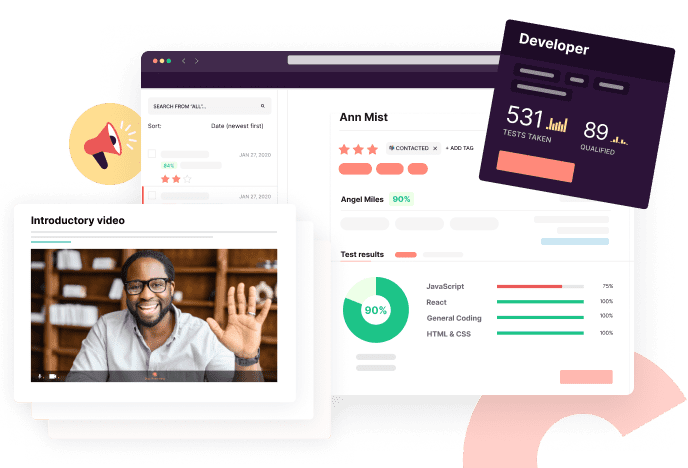
What is a strategic recruitment plan?
A recruitment plan outlines a company’s approach to recruitment and how it will implement its recruitment processes most effectively. The plan should include all the relevant details required for making strategic future hires, such as hiring goals, procedures to follow, and the hiring budget, for example.

A good recruitment strategy will align with the organization’s goals to ensure the hiring manager is contributing to company growth and helping to manage any organizational changes.
Are Recruitment plan and Recruitment strategy the same thing?
While a company typically develops its recruitment strategy and recruitment plan in parallel, the terms refer to different components of the recruitment process. The easiest way to tell the two apart is to think of the recruitment strategy as the overarching, high-level document that covers the ‘ what ‘ and the ‘ why ‘, while the recruitment plan is more of a step-by-step detailed roadmap that outlines the ‘ how ‘ and ‘ when ‘.
| Recruitment Strategy | Recruitment Plan | |
|---|---|---|
| An overarching approach or method an organization uses to attract and hire new talent, focusing on long-term goals, types of roles to fill, ideal candidate profiles, channels for reaching these candidates, and . | A detailed, step-by-step roadmap for implementing the recruitment strategy. It outlines specific tasks, timelines, responsibilities, and resources required to execute the strategy. | |
| Long-term goals, the ‘what’ and ‘why’ of the recruitment process. | Short-term objectives, the ‘how’ and ‘when’ of implementing the strategy. | |
| Employer branding, sourcing strategies, candidate profiles, diversity goals, etc. | schedules, resume screening criteria, interview timelines, assigned responsibilities, etc. | |
| To define the overall approach and objectives in attracting and hiring talent. | To detail the exact steps and resources required to implement the strategy. | |
| More adaptable to changes in the market, industry, or company objectives. | Less flexible due to its task-oriented and time-bound nature. | |
| Establishes the direction and focus of the recruitment efforts. | Facilitates the successful execution of the recruitment strategy. |
When is the best time to create a recruitment plan?
If you’re wondering whether your company needs a recruitment plan or can wait a while before developing one, consider whether you’re in one of the situations listed below.
Annual planning — is your organization about to undergo its annual planning process? At that stage, hiring managers have an important role to play in aligning hiring strategy with the company goals during this process.
Organizational changes — if your company is growing , starting a new initiative or has seasonal hiring needs, a recruitment strategy will be essential in attracting quality candidates for your talent pipeline .
High turnover rate — if the business is losing it’s talent too fast, recruitment plans can help patch up any gaps in the workforce and ensure the best approach to improve retention .
External changes — a big change in your industry or shifts in the market could mean that your business needs to adapt its recruitment strategy to continue attracting the best candidates.
Why does our team need a recruitment plan?
A recruitment plan is your guiding star when it comes to predicting and meeting the company’s staffing needs. It provides a framework for all stakeholders that keeps everyone aligned and working towards the same deliverables in a structured, effective way.
With a detailed hiring plan, your team can streamline the hiring process and reduce recruitment costs . But the benefits don’t end there.
Recruitment Planning: 5 Key Benefits
| Benefit | Description |
|---|---|
Helps to ensure a consistent approach to hiring | |
Aligns recruitment efforts with bigger company goals | |
| Facilitates long-term | |
Helps to reduce hiring costs | |
Delivers an effective approach to hiring |
The benefits of creating recruitment plans
Next, let’s dive a little deeper into what hr professionals, businesses, and applicants will get out of making planned recruiting efforts.
Smarter decision-making
Hiring teams need to work effectively and make smarter decisions throughout the talent acquisition and onboarding process.
By working with tools such as a recruiting funnel and modern recruitment software and using metrics throughout the process, the team can continually make accurate data-driven decisions to improve their output.
Delivering a streamlined hiring process
A recruitment plan can help recruiters work strategically , resulting in a continually improving hiring process that saves time and enables more focus on high-priority tasks.
Providing an engaging candidate experience
A well-executed recruitment plan improves the overall candidate experience . Treating applicants like professionals will likely enhance your company or department’s reputation and increase the likelihood of attracting top talent.
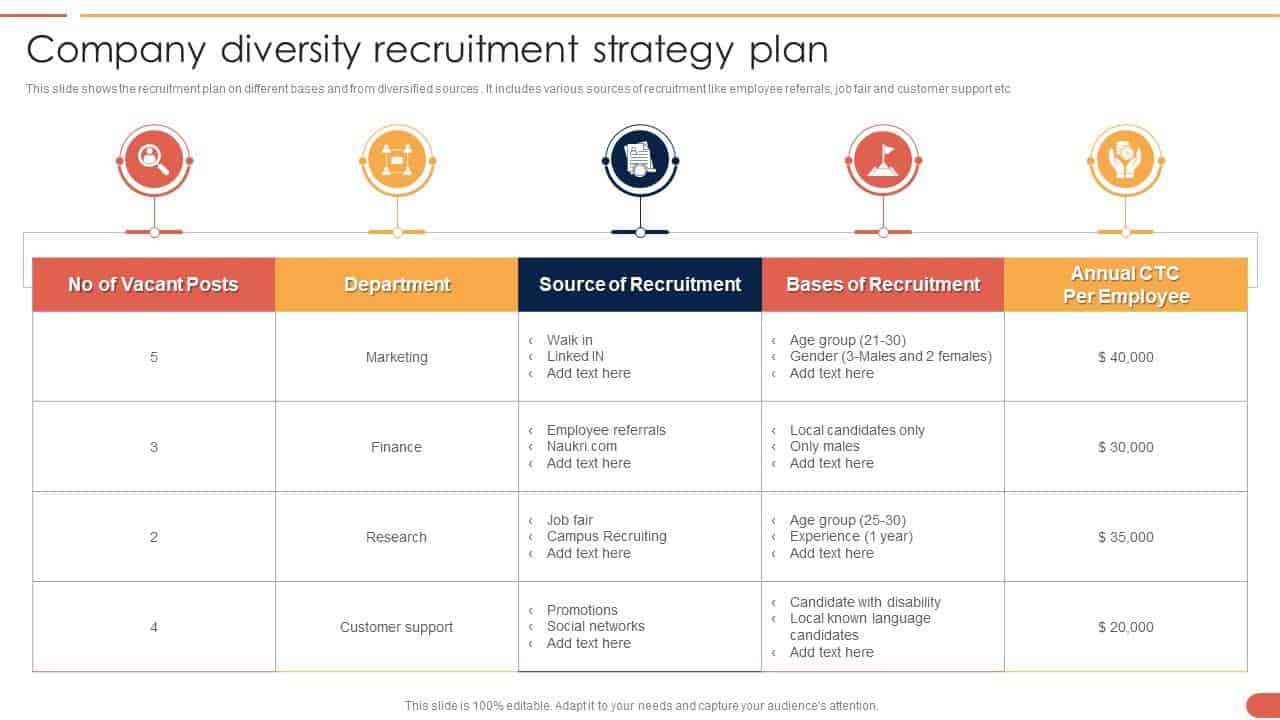
Meeting specialized hiring goals
The hiring team can include and adapt its recruitment strategies to reach specific hiring targets , such as diversity and inclusion goals , and the right candidates.
Reducing hiring costs
By continually updating and improving the hiring plan, the team can optimize metrics like Cost-per-Hire and more easily stick to the recruitment budget .
Boosts adaptability to internal and external changes
Hiring managers can predict and adapt to any internal changes , like a new office location, or external changes , like an economic crisis, to ensure an optimal workforce at all times.
Ok. Now that we’ve explored the benefits of a recruitment plan, let’s get you started on the right steps for how to develop a recruitment plan successfully.
6 steps for creating a successful recruitment plan
Keeping the hiring team and other stakeholders on the same page with proper planning will ensure everyone’s work complements each other, and enable you to make smarter decisions faster .
Plus, you can provide feedback quickly to queries from those who need to know (and those who are just sticking their nose in. 😉 )
Following these 6 steps will help you prepare for your recruitment planning period.
#1 – Setting recruitment goals
A recruiting plan means nothing without including specific goals . Rather like building a house without an architectural diagram, it could result in things going horribly wrong! That’s why your hiring team needs to set short-term and long-term goals , to ensure that your recruiting plans are set for success.
Note : It’s essential to define and assign a metric for each goal too. Without metrics, you won’t know how well you’re achieving your goals, or whether you’re lagging on some of them.
Why separate long-term and short-term goals?
Short-term and long-term recruitment goals are typically a bit different. While a short-term goal may be to update your career webpage, a long-term goal could be to improve the diversity of your candidate pool.
Over the hiring timeline, it can help a lot to split goals into short-term and long-term targets. Here’s why:
Improved team focus — so your team can more easily prioritize tasks, know how to best manage resources, and keep a focus on immediate needs and future goals.
Ensure a feasible plan — by marking goals as either short-term or long-term, the team can rest assured that not everything must happen immediately. And prevent a feeling of mental overwhelm.
Facilitate continuous improvement — short-term goals are the best opportunity for testing new ideas or recruiting tactics, like trying out a new candidate screening tool. Once you’ve established how effective the initiative was, you can adjust it so it delivers long-term benefits, like improving the candidate experience .
Examples of short-term vs long-term goals
| Goals | Goals |
|---|---|
| Improving job descriptions | Building a |
| Meeting seasonal hiring needs | Strengthening your employer brand |
| Onboarding the right employees for new projects | Boosting employee retention |
| Reducing Time-to-hire and Cost-per-hire metrics | Adapting to industry changes and workforce trends |
| Introducing skills assessments | Delivering strategic talent pipelines |
| Testing and implementing new recruitment software | Improving the candidate experience |
#2 – Identifying hiring needs
Before you start planning your new hires, you need to know what skills and competencies the business will need over the next year. So, how do you evaluate and prioritize these hiring tasks?
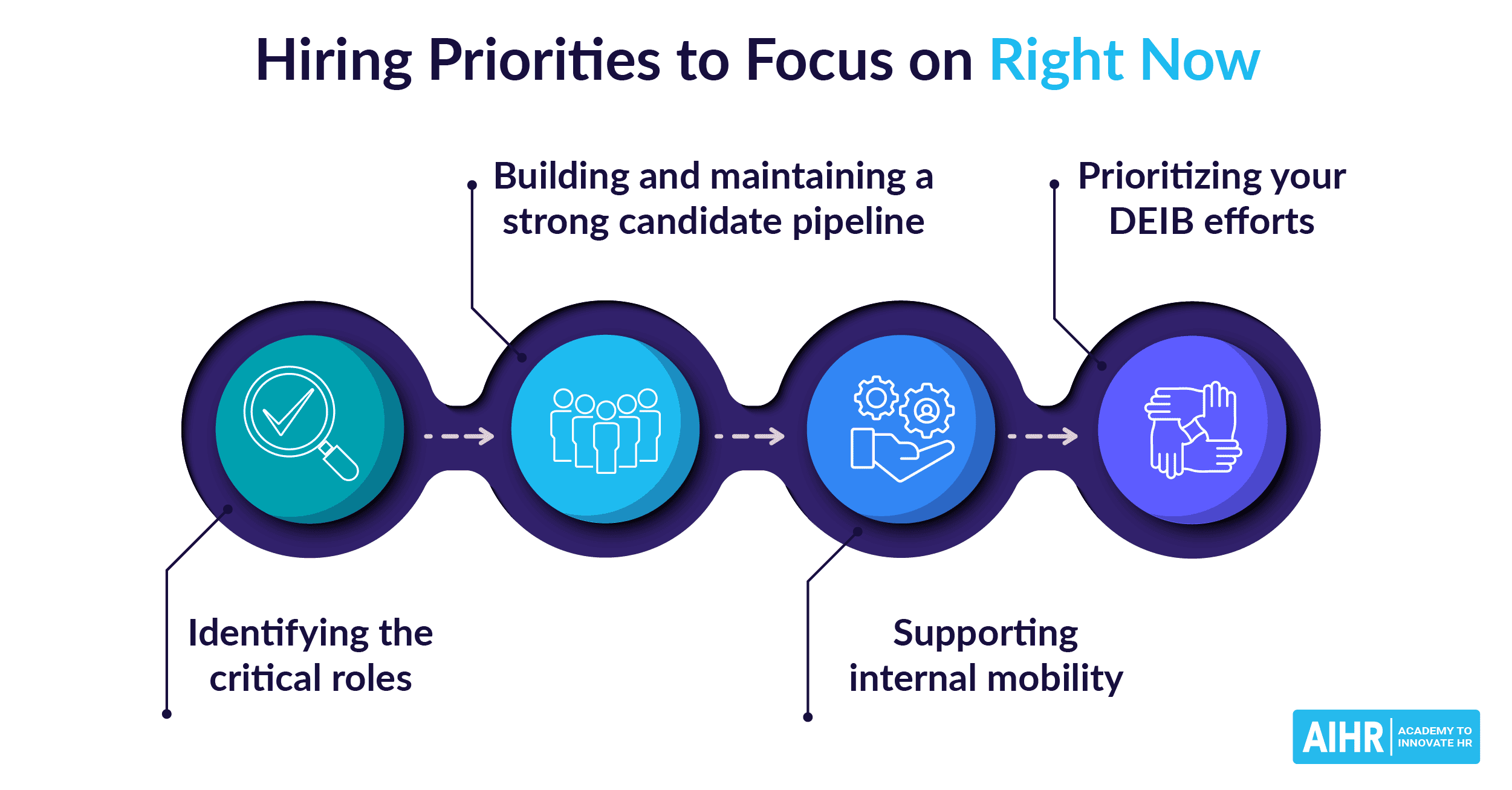
High-priority needs could include things like analyzing the company’s annual goals and strategy to align recruitment planning and successfully complement the rest of the business. Or performing skills gap analysis to spot any skill gaps between the current workforce’s capabilities and the skills that you’ll need to have onboard in the long term.
While medium priority tasks could include evaluating your staff turnover rate to ensure sustainability and keeping a close eye on industry and workforce trends .
On the other hand, improving the collaboration between HR and other departments is a good example of a lower-priority hiring need .
Ok, but how do you know which roles to prioritize?
You can make your hiring activity choices based on factors like these below.
| Does the role meet new or urgent business directives like hiring no more support staff for the rest of the recruitment calendar or a new initiative to attract and hire staff? | |
| Is there an open position that needs filling urgently, like a Sales Director or Product Manager? | |
| Have you checked whether there are suitable candidates available internally to fill the role? | |
| Is the organization meeting its diversity and inclusion goals? And does the role fall under those goals? | |
| Does the role’s salary or salary level align with the recruitment budget? | |
| Have you assessed the level of difficulty in filling the role? If it’s a tricky one to fill, it’ll take more time, costing more. |
#3 – Setting your hiring budget
Think about the costs associated with these components of the hiring process to optimize your hiring budget (and put a smile on your hiring manager’s face 😊).
- Recruitment marketing — what you’re spending (and will spend) on advertising roles and improving your employer brand, including social media advertising, job posting, job boards and career events.
Recruitment technology — the tools your team uses to streamline the hiring process, such as chatbots, applicant tracking systems, and candidate relationship management ( CRM ) software.
Assessments — an online skills testing platform for screening applicants.
Interviewing costs — any costs incurred through in-person or video interviews.
Recruitment team salaries — the total salary cost for your team.
External recruiting — if you need the services of external recruitment agencies, perhaps for a new or niche role.
#4 – Attracting and sourcing the best talent
You need to get the word out through as many channels as possible to keep your recruitment funnel topped up with qualified candidates. Your sourcing methods are essential in attracting potential candidates for your job postings.
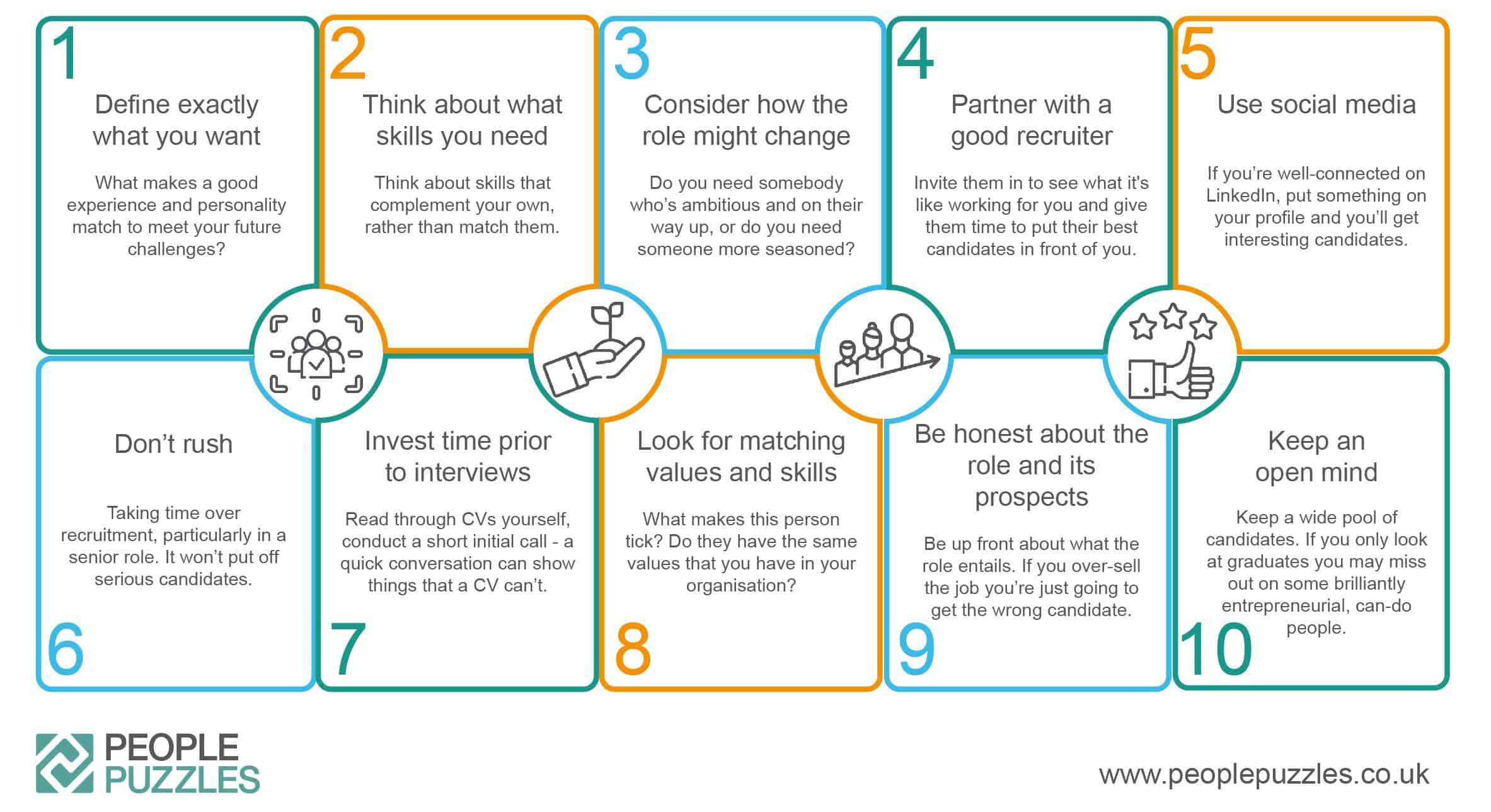
For the candidate selection process part of your recruiting plan, you could include components like:
Defining your target candidate profiles — what skills and experience do they need for the role (and include this info in the job description ).
Updating your employer value proposition (EVP) — the EVP is what a company offers its employees in return for their work.
Recruitment events — including job fairs, conferences, and internship recruiting .
Managing candidate engagement — staying in touch with your candidate pool via email, social media or another medium.
Employee referral program — getting your employees to refer the great talent they know personally saves your team time.
Need some inspo on new approaches for hiring new employees?

#5 – Streamlining your recruitment process
It’s possible that not all parts of your hiring strategy are as effective as they could be. There may be some methods or tools the team has used for too long that need updating, for instance.
Here are a few tips to help you refresh your recruitment process :
Revamp your application process . Consider letting candidates apply via skills tests instead of CVs, for instance!
Set clear evaluation criteria , such as clearly defined job requirements .
Craft clear and engaging job descriptions that include all the details a candidate needs to know to see if they’re a good match.
Deliver an effective screening process . Your team can save time by automating screening tasks.
Conduct structured interviews using set interview questions and techniques, and skills tests results to inform your interview prep and guide your interview questions.
Use the right candidate assessment tools and homework assignments to screen whether applicants have the right skills.

#6 – Analyzing your recruiting plan
The best way to assess the efficacy of your recruiting plan, and continually improve it, is by using a recruitment funnel (a framework that helps you organize, manage and enhance every stage of the recruiting process).
With a recruitment funnel, you can use recruitment metrics , such as Time to hire, Quality of New Hire made, and Cost per hire, to determine how well you’re doing at each stage of the funnel.
Along with leveraging the findings from your metrics, you can also receive and implement any feedback from candidates and hiring managers.
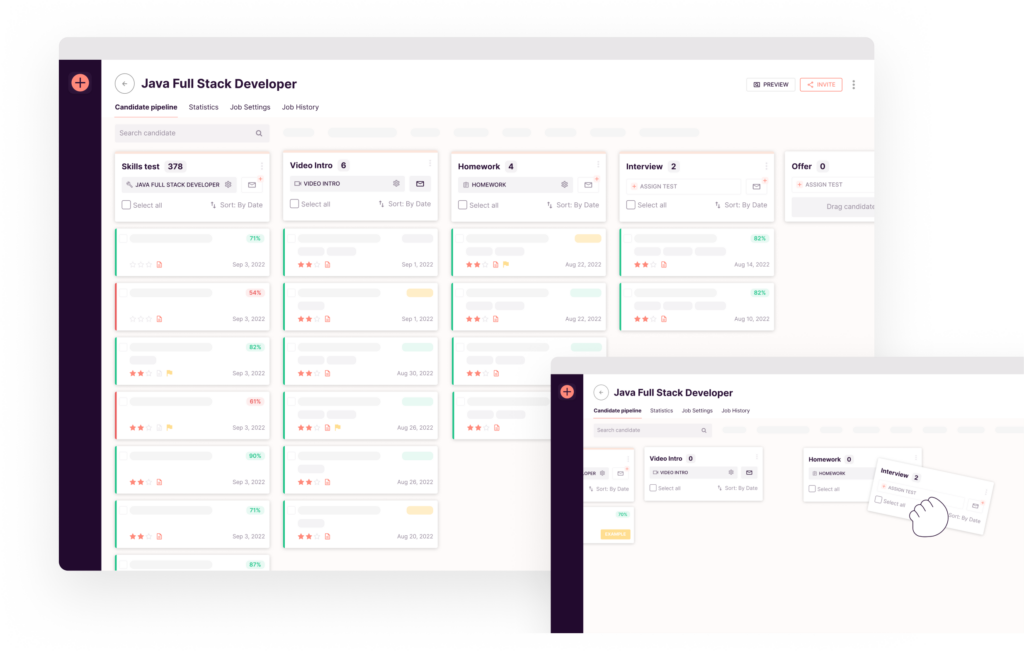
Managing the latest recruitment trends and technology
Staying up-to-date with industry trends and best practices will ensure hiring teams operate efficiently and help the organization retain a competitive edge . Luckily, this is where technology comes to the rescue.
For instance, think about the major industry shift towards skills-based hiring practices. Harvard Business Review shared this recently about how skills-based hiring is on the rise:
Many companies are moving away from degree requirements and toward skills-based hiring , especially in middle-skill jobs, which is good for both workers and employers. HBR
And when hiring teams have the right recruitment tools, their tasks become easier, and the technology saves them time. So, don’t waste time rebuilding everything in-house when you can plug and play an all-in-one skills platform at affordable prices .

Juste loves investigating through writing. A copywriter by trade, she spent the last ten years in startups, telling stories and building marketing teams. She works at Toggl Hire and writes about how businesses can recruit really great people.
Subscribe to On The Clock.
Insights into building businesses better, from hiring to profitability (and everything in between). New editions drop every two weeks.
You might also like...
Related to Talent Acquisition

Talent Pool 101 & 8 Tips for Effective Talent Pooling
Resume Screening 101: Everything You Need to Know
How to Hire for Company Culture Fit the Right Way
Take a peek at our most popular categories:
How To Start Recruitment Agency Business [PLAN]
Do you need help starting a staffing agency? If YES, here is a sample recruitment agency BUSINESS STARTUP GUIDE.
A recruitment agency provides a vital service to businesses that need to hire qualified personnel. Are you interested in setting up one? If you are, we will help you.
This recruitment agency BUSINESS STARTUP GUIDE has been written with aspiring entrepreneurs in mind.
Although it is summarised, it highlights the essence of a plan. By going through this sample, you can avoid the most common mistakes many entrepreneurs make.
As always, our advice to new entrepreneurs is never to have zeal without knowledge. By adhering to this advice, it saves them from making costly mistakes.
You can start several service industry businesses if you have the skill.
However, the purpose of this article is not to dwell on the many available opportunities. We seek to focus on one: a staffing agency business.
Thousands of job seekers stream aimlessly to different offices and business settings to find a place to work. How do you think such ones will feel if you’re doing the work of matching them to their preferred work?
A staffing agency is all about surveying them and matching employees to employers. This is easier said than done.
I present to you all that is needed to start a staffing agency, and in the end, you should be equipped enough to create your staffing agency.
This article will also provide a staffing agency BUSINESS STARTUP GUIDE. This is targeted at aspiring entrepreneurs interested in this business area. All you need to do is follow to the end to understand better how plans are written.
With the rise in the unemployment sector, you will realize that many people are looking to venture into various businesses to improve their standard of living.
In contemporary times, recruitment agencies are created to curb the rising unemployment rate in society.
RECRUITMENT AGENCY BUSINESS STARTUP GUIDE
Starting up a staffing agency can guarantee a source of second income for you by connecting companies that have vacancies with job seekers.
To ensure that you build a cordial relationship and continuous partnership, you must thoroughly examine employment seekers to ensure they meet your client’s requirements.
If the need arises, you will need to register with them as a recruiting agency, and they, in turn, inform you when there is a need to hire.
In this post, I will be giving a few tips on how you can start a recruitment agency to help curb the unemployment problem.
Here is how to start a recruitment firm.
- Pick your Niche
To start up an employment agency business or staffing franchise like Adecco and AtWork, first, you need to pick a field that you think would work for you; you can decide by observing your interest and building upon it; it could be Agriculture or Banking and finance.
Whichever you decide to venture into, you must realize that every industry has its staffing needs. A consultant should prioritize these needs when developing your business proposal and objectives.
In this part of the world, no one is taught how to start up a recruiting agency in school. This is why it is necessary first to learn all there is to know about recruitment agencies.
The information you will gather most importantly would be what recruitment agencies do, how they work, how to build a customer line, how to make a profit or should I say, the employment plans available that make for sure that there is profit in this sector of business.
- Skill development
One requirement to run a recruiting agency is to have the ability to identify raw talents when you see them, and different people with different expertise from diverse places are the people you will be dealing with.
Therefore, you, on your part, will need to be sound in mind and understand to succeed in this sector.
This is a venture that is capital intensive, and to be able to run the recruiting company successfully, there has to be reserve money for payment of your staff, having enough cash to cover business expenses and advertisement of your business.
This is to say, you need to be financially prepared before venturing into any employment business model.
- Study and Comprehend What Is Legal for the Business
What are the documents needed to start a recruitment agency?
• Find out if a business license is required. Consult your local government agency for requirements. • Find out about laws related to advertising for employees . • Learn about taxes and the rates required. Get to know the amount and due dates of payroll and income taxes. • Research on the legal requirement related to insurance.
- Register your Business
For employees and employers to agree that your business is legal or in a valid business setting, you must register your business with the required agency. Writing your business will help you become informed about everything necessary to run a successful business.
Many companies offer business registration depending on your location or where you reside. To find a reputable company and register your business is very essential.
- Get an Employment Agency Business Plan
A well-scripted business plan is needed to set up and run a successful business. A business plan will help a staffing agency know what they need to survive.
The plan will clearly state its unique business name, niche, mission, and vision; it will contain its financial plans, the services it wants to render, and the SWOT analysis.
A good business plan will give dimension and help your business have a clear purpose.
Location is one major factor for your business, which will be determined by the branch or field you want to venture into. This, on the other hand, is dependent on your target market. While choosing a location, take into consideration how profitable it would be to open up this business at whatever location you’re considering,
- Create a Marketing Plan
Creating a recruitment company business marketing plan and strategy would be best. You need to make a list of clients and prospective clients, and this selection can be made based on the industry your online recruiting firm focuses on.
You can create contact by making calls, writing and sending emails to prospective companies, and placing adverts in newspapers, magazines, and online job sites.
You need to design a suitable logo to show how severe and sincere your job agency is; a website is also required to help with marketing, business cards, and newsletters that would be able to send to your clients to help them have enough information about your placement agency and what you generally do.
- Employ Recruitment Staff
This business cannot be run by just one person handling every department, which is why employing the service of others who are specialists in the field should be one area you also have to work on in the business.
To run a recruitment consulting agency successfully, you should look out for individuals who would, in their departments, help you build your business and have a tremendous increase in profits and a boost with clients.
You would need staff specializing in administrative work, staff with superb communication skills, and also staff in accounts. These are necessary to help build your business and guarantee its success.
- Get a Lawyer or Legal Practitioner
Situations might arise where applicants need to be cautioned; in this situation, a lawyer will be the best person to accomplish this.
There must be terms and conditions, rights, and responsibilities that applicants must fulfill so that you will be getting them their required job. To prevent stories that touch or cases of not honoring agreements, you need a legal practitioner to make everything official and valid under the law.
- Secure Insurance
A reasonable level of insurance is needed for your business to be termed original. Most clients will want to be assured that there is a measure of insurance if one of your clients damages their properties while on site.
So, getting an insurance company that understands your business and is ready to help cover expenses incurred by your clients at any time is very important.
- Setup Payroll Processing System
Having filled an order, you need to plan how you will pay your employees: weekly, semi-weekly, or monthly. Rules guiding the payroll system that you must understand as long as you want to be successful in the business; these may include plans for overtime payment and vacation pay, amongst other payments.
You need also to sort out their taxes and remit them to the required governmental body or agencies. Most of the time, hiring payroll administrator personnel is the best option.
- Start Your Business
Having done all the above, it is time for you to start the business; by now, you must have secured a good location and purchased all the needed tools and equipment for the office, at least the basics. Your business must be registered at this point, and all financial calculations must be done and ready for carrying out.
Starting a staffing agency is just as easy as starting any business when you get those points right, and if only you wish to become successful in the field, failure to understand and adopt those points might be catastrophic.
RECRUITMENT AGENCY BUSINESS PLAN EXAMPLE
To start an employment agency, you must understand how it works and your market size. Your feasibility study should take care of that.
- Executive Summary
Best Hire® is a new Human Resource agency business that seeks to contribute to developing a reliable database for businesses and companies looking for competent and qualified workforce.
As a small start-up, our size doesn’t matter as we are well-placed to penetrate the market by deploying industry best practices. The quality of our workforce counts in our favor.
The proprietor has been engaged at the highest levels of human resource recruitment for major multinational companies. His experience will be crucial to providing world-class recruitment services to our clients.
- Our Services
We will be involved in all types of employee matching services for our clients, including major corporate entities and small businesses. We consult with each client to find the right kind of employee.
We do the hard work while our clients concentrate on running their business. We deeply understand Ohio’s local market and seek to allocate human resources where they would perform best.
- Vision Statement
At Best Hire®, we are driven by a vision to contribute to the development of Ohio’s business landscape. This we seek to achieve through matching the correct type of employees to businesses.
These include both skilled and unskilled. In the next five years, we see ourselves among Ohio’s top 5 most preferred recruitment agencies.
- Mission Statement
Our mission is driven by providing unbeatable services to all types of businesses. We are satisfying a growing demand for capable and skilled hands.
Our recruitment agency will make sourcing the best hand easier, allowing our clients to commit to their business growth.
We are a sole proprietorship business sourcing for start-up capital through applying for a bank loan. $900,000.00 is required, and we have met the necessary conditions.
The loan will attract an interest rate of 9% monthly, with the principal sum due for payment in 4 years.
- SWOT Analysis
Our strengths, weaknesses, opportunities, and threats have been tested. The company contracted for this job is a reputable business solutions provider.
The study has allowed us to reorganize our business for the most impact and growth.
It has also helped us exploit opportunities and develop a contingency plan for threats.
For a better understanding of our findings, the results are included below;
This recruitment agency business was conceived to serve a market needing a competent human resources database.
Our strength is our ability to quickly connect businesses to the correct type of employees. The proprietor is experienced and knowledgeable in handling all business labor issues.
Our weakness arises from our current size. Our small size will limit our ability to get across to significant clients.
These clients usually look out for long-established and extensive recruitment agency businesses. This is a weakness we currently face as a small and new firm.
- Opportunities
Opportunities abound in the form of increasing businesses that need our services. We are well adapted to providing the solutions they need. A significant part of this opportunity is that our clients recommend other businesses due to our commitment to providing excellent services.
When there is an economic recession, businesses no longer hire but downsize their workforce. This is bad for our business and will lead to a total halt in demand for our services. This threat is real. However, the good news is that economic recessions do not always happen.
- Sales Projection
We can project the demand for our services through a study of the current situation in the recruitment market. There is clear growth potential. This has enabled us to draw a sales projection covering three years, as reflected in the table below;
- First Financial Year $300,000.00
- Second Financial Year $550,000.00
- Third Financial Year $800,000.00
- Competitive Advantage
Our competitive advantage can be attributed to the extensive network of businesses our proprietor has established during his active years of service. This includes those with big businesses as well as with small business owners. We are using this advantage to leverage our capacity to deliver quality services.
- Marketing Strategies
We must use the most effective information dissemination channels to reach the business community.
This will include visiting our target clients to discuss our services and what we can offer. We will also advertise in newspapers, distribute fliers, and mount billboards that advertise our services.
This recruitment agency BUSINESS STARTUP GUIDE has been summarized to show you the most relevant information. You can follow this plan to write your comprehensive staffing agency business plan .
You should avoid trying to hasten things up. Going slowly and getting it right is much better than speed.
STAFFING AGENCY BUSINESS PLAN EXAMPLE
You can consider this a guide or template against which you can make comparisons when writing your plan. It must be stated that no matter how useful you find this sample, it will be of little value to you if you have not done a proper feasibility study of your business.
Corporate Resource LLC is a company located in Atlanta, Georgia. Our staffing agency provides businesses and corporate entities with a workforce. We offer consulting and training, helping businesses find a suitably qualified workforce. Whatever the staffing needs of our clients, we are up to the task.
We will offer highly skilled, semi-skilled, and unskilled labor consultancy services. We seek to provide the best solutions to our esteemed clients. We understand that our clients do not have the time to get into the nitty-gritty of staff employment.
We handle the problematic aspect of the job by identifying and categorizing our human resource pool. These are provided with added job-specific training to increase efficiency. To enable us to get the job done, we are highly experienced personnel with many years of experience as recruiters. Our clients will include both domestic and foreign corporate entities.
- Products and Services
Consulting entails many processes to match vacancies with the right type of people. Given this, our staffing agency will be involved in staffing for all businesses and industries.
These include the provision of staffing for the healthcare sector, the oil and gas, the provision of training services for specific positions, and the provision of temporary or contract-based staffing services.
Having the right crop of staff is essential to any business. We understand this and are fully equipped to provide such services to our clients. We are focused on eliminating the difficulties businesses face in getting the correct type of labor.
This will enable them to concentrate on efficiently running their businesses while we do the job.
Our staffing agency seeks to provide highly professional services, which will be second to none in the industry. Our reputation means the world to us. Hence, we are committed to building a reputation hinged on excellence. This will be achieved by performing beyond our client’s expectations.
We will need adequate financing to ensure a smooth take-off. We have done the necessary analysis on the capital required; this is more than $800,000.00.
We will be applying for a $1,200,000.00 bank credit. We are hoping to obtain such loans at single-digit interest rates. However, our negotiations will determine the outcome.
We have analyzed our competitiveness for a smooth take-off of our staffing agency. This focuses on vital areas that include our strengths, weaknesses, opportunities, and threats. The following are the results obtained;
We have been careful in choosing our staff. As a staffing agency business that seeks to make a positive impression, we have sought to become an example of the services we will offer.
We have selected professionals with the right experience. Some have served in significant staffing agencies as recruiters, while others have the required skills.
These will work in various capacities, including our recruiting department, training, marketing, and customer service providers.
We are a new entrant into the industry. This means it will take some time before we begin attracting clients and building a steady clientele flow.
In addition to providing staffing services to businesses, we have included training. This allows us to work closely with businesses to provide the correct type of training.
By outsourcing their training, our clients can focus on their business by allowing us to handle one of the most challenging aspects of hiring.
Competitors are a steady threat to this type of business. These are made up of other staffing agencies which will compete for our clients. Another threat is in the form of unfavorable government policies. Such situations are harmful to doing business. The biggest threat among these is a global economic meltdown.
This will lead to businesses shedding off their workforce, creating an unfavorable employment climate. This will directly impact our business as businesses will no longer be looking to hire but to survive.
Over the years, economic growth in the United States has influenced a rising employment rate. This is good for staffing agency businesses like ours.
Using this, we have done a sales projection for our business. This has revealed a positive outcome over three years, as shown below;
- First Financial Year $310,000.00
- Second Financial Year $500,000.00
- Third Financial Year $855,000.00
We welcome competition as it enables us to innovate better ways of serving our clients. Our pride lies in the quality of our management staff. These are composed of thoroughbred professionals who have contributed in no small measure to making the employment industry what it is.
Their impressive experience gives us a greater advantage in excelling over our peers.
- Target Market
We have identified several businesses and industries as potential targets in providing high-value staffing services.
These include the public sector, blue-chip companies, the real estate sector, financial institutions, the manufacturing industry, the healthcare industry, small start-ups, and the educational sector,
- Marketing and Sales Strategies
As a new staffing agency business, marketing is crucial to attracting a steady stream of clients. We are adopting several effective marketing strategies.
These include placing ads in newspapers and business magazines, bidding for all types of staffing agency contracts, using the internet to make our business more visible, and providing staffing services for all categories of businesses.
This staffing agency BUSINESS STARTUP GUIDE has been written with the aspiring entrepreneur in mind. You can review its content and better understand how your plan should be organized.
We have summarized this to allow you to grasp its general structure in the shortest time possible.
Leave a Comment Cancel Reply
Your email address will not be published. Required fields are marked *

Global HR — 7 min
5 steps to an effective recruitment plan template
Recruiting and retaining top talent isn’t easy, especially if you’re hiring for a global workforce.
The good news? You can use a recruitment plan template to streamline the hiring process. This makes it easier to scale your business anywhere in the world.
Read on to learn how to develop a recruitment plan template that works.
What is a recruitment plan template?
How do i create a recruitment plan template, it’s time to implement your recruitment plan template.
Businesses looking to scale can’t afford to waste time and energy developing a new recruitment plan whenever they need to bring on more talent. A recruitment plan template is a business’s structured approach to recruiting, screening, interviewing, and hiring new employees. It includes the detailed steps, strategies, and timelines required to find the best candidates.
A consistent, reusable template makes sure you aren’t recreating the wheel each time you need to recruit and hire new workers. As soon as you’re ready to expand or fill positions, you can start immediately with your template.
HR personnels can save a lot of time by developing a recruitment plan. A comprehensive plan outlining timelines, budgets, and qualifications for new hires cuts down on the guesswork and streamlines the hiring process.
Recruitment plan templates also help you track efficiency. You can see what you are doing well while identifying any areas that need refinement to consistently find the best candidates.
There are five key steps to creating an effective recruitment plan template. Identify your needs, establish your approach, decide how to locate candidates, start your efforts, and refine your methodology over time.
Let’s dive further into each step.
1. Identify your needs
The first step for developing a recruitment plan template is to take stock of your current needs by answering the following questions:
Who does your business need to hire?
Start by narrowing down which positions you need to fill and what type of person you are looking for. Are you looking for independent contractors to complete short-term projects? Or employees interested in remote positions in another country?
Review your short-term and long-term business needs, especially if you plan to expand.
How many positions need to be filled?
Once you’ve taken stock of the types of team members you need, narrow down the number of positions you need to fill. Take a look at your current job descriptions, and revise them as needed.
Don't forget to identify any in-house promotion or advancement opportunities for your current employees. You need to keep this information in mind to determine how many recruits you need.
What is your timeline?
Now set your timelines for recruitment, vetting, and hiring. Of course, recruitment timelines vary depending on your business needs. On average, you can expect the entire process to take about 3 to 6 weeks .
Factor in time to onboard employees. New team members need additional time to familiarize themselves with company policies and job responsibilities. Onboarding may also include company or job-specific training for new hires.
Where are you looking to expand?
If your business is looking to expand internationally, there are additional factors to keep in mind. Each country has unique labor, employment, and tax laws that can affect your recruiting and hiring processes.
A Global HR partner like Remote can help you expand your business in a new country. We have legal entities around the world, offering you the expertise and support you need to stay compliant in every country.
Once you know the answers to these questions, you're ready to tackle your recruiting approach.
2. Establish your approach
Start by looking at your previous hiring efforts to see what worked. Keep past successful strategies in your recruitment plan template.
Next, investigate the region you want to expand into, including any expectation that local employees have. Budget salaries, benefits, and other compensation to attract the best possible candidates.
Plan how to advertise your business to appeal to candidates. Make sure your process is aligned with your company’s values, mission, and goals. Find a talent assessment tool to predict the performance of potential hires. This can increase productivity by 10% and boost employee retention rates.
The average cost per new hire is $4,700 , so keep this in mind to determine your recruitment budget. See how much you want to spend on advertising, job postings, and recruiting events.
It's easy to only consider these hard costs, but you’ll also want to factor in soft costs. For example, managers may need spend valuable time to support HR leaders during recruitment.
3. Determine how to find the best candidates
Businesses have more options than ever to attract top-notch candidates.
Job boards are one way to get the word out that your company is hiring. Most job boards charge a fee for you to advertise, so research your options carefully. Some broadly advertise across industries, while others focus on specific niches.
Job fairs are another option. Some are in-person, while others are held as virtual events. If you go this route, plan who is hosting the event and how those individuals will vet potential candidates.
Social media is a great way to find top candidates. About 57% of people search for a new job through social media, while 73% found their last job using social media. Tap into the social media accounts your company already participates in, whether that’s LinkedIn, Instagram, or something else entirely.
Outsource your recruiting to a reputable staffing agency. Work with a staffing agency to identify your ideal candidate profile. The agency should complete the searching, screening, and interview process for you. If you’re hiring internationally, don’t forget the benefits of partnering with an employer of record (EOR). Remote’s EOR platform helps you hire excellent candidates in your location of interest while keeping your business compliant with local labor, tax, and employment laws.
Once you’ve decided on the specific methods through which to find candidates, you’re ready to start recruiting.
4. Start your recruitment efforts
As you begin the recruitment process, think about how you want to screen applicants. You'll review job applications and resumes, and maybe also do a skills assessment. Continue with background and reference checks as needed, and complete an initial phone or video conference screening. Once candidates are vetted, you can start the interview process. Decide who will interview and the questions will look like. Some jobs may require a panel or succession of interviews to determine the best person for the job.
A good recruitment plan template also covers the onboarding process. Employees are 2.6 times more likely to stay with a company that has a smooth onboarding process. Unfortunately, only 12% of employees say their organization did a good job with onboarding. Don’t be a company that gives a bad onboarding experience for your employees. Check out our tips to create a smooth, satisfying onboarding process for each new hire.
5. Refine your template over time
Once you landed on your ideal recruiting plan, review its efficacy over time. Use a variety of metrics to analyze your recruiting and hiring results, and refine the plan until it’s seamless.
Your metrics could include the time taken to fill new positions. You can also track the acceptance rate of each position listed.
You can also track how new hires grow into their position over time. Are they successful in their roles? Can you identify candidates with growth and advancement potential? Do you notice a difference in employee turnover rate? Consider your metrics carefully, and use them to drive your future recruitment efforts. Over time, you will have a plan focused on locating and retaining the best possible candidates for your company.
Start building your recruitment plan template by defining your company’s needs. Who is your ideal candidate? Which positions do you need to fill? What is your timeline?
If you plan to expand internationally, you can join forces with a Global HR partner like Remote. You can easily post open positions in Remote Talent to attract top talent across the world. Learn how you can find the best international candidate through competitive benefits as part of your recruitment plan. Contact Remote to start recruiting and hiring internationally today.
Attract the best international talent with Remote
Get noticed by diverse, qualified candidates across the globe. Don't let geography stand in the way of hiring great people.
Subscribe to receive the latest Remote blog posts and updates in your inbox.
You may also like

Contractor Management — 4 min
Independent contractor taxes in Virginia: freelancer tax management guide

Contractor Management — 6 min
Independent contractor taxes in Pennsylvania: freelancer tax management guide

Employer of Record & PEO — 10 min
How to transition from a PEO to an EOR

Visas and Work Permits — 7 min
EU Blue Card eligibility: A comprehensive guide for non-EU workers
67+ SAMPLE Recruitment Plan Templates in PDF | MS Word | Google Docs | Apple Pages
Recruitment plan templates | ms word | google docs | apple pages, 67+ sample recruitment plan templates, what is the purpose of a recruitment plan, what are the benefits of using a recruitment plan, how to make a recruitment plan, what are the two types of recruitment, what do you mean by full-cycle recruiting, what are the common activities in the recruitment process, what are the five stages of the recruitment process, what are the common hr recruiting techniques.
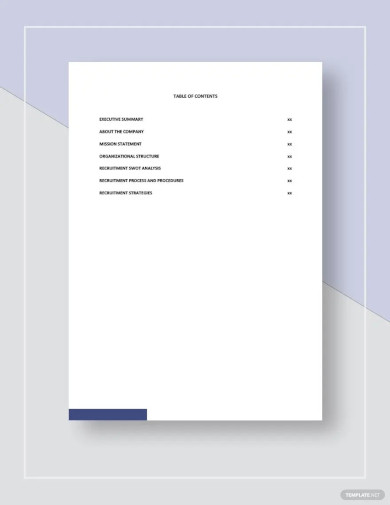
Recruitment Plan Template
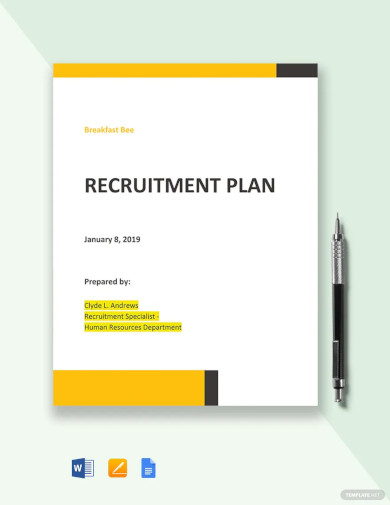
Small Business Recruitment Plan Template

Volunteer Recruitment Plan Template
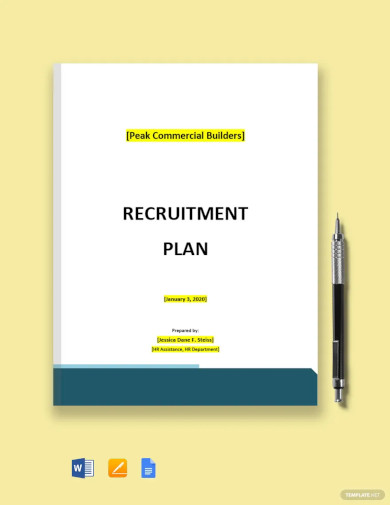
Board Recruitment Plan Template
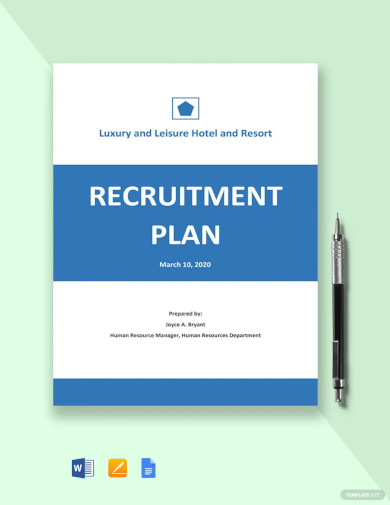
Annual Recruitment Plan Template
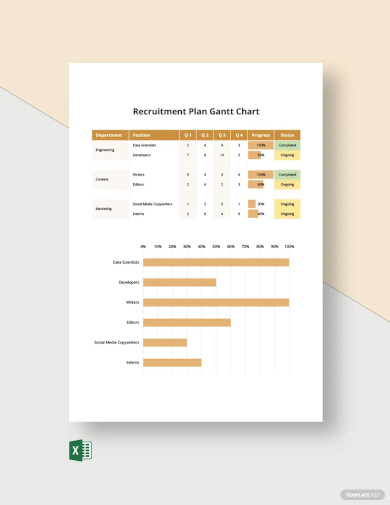
Recruitment Plan Gantt Chart Template
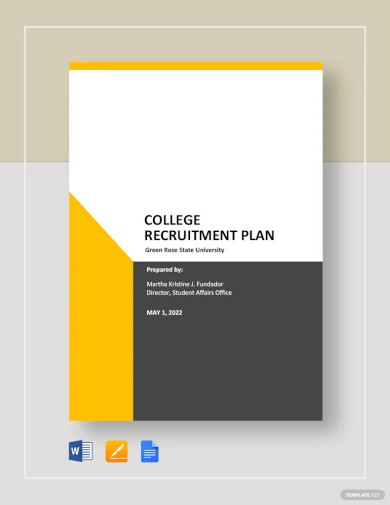
College Recruitment Plan Template

Marketing Recruitment Plan Template

Sample Recruitment Plan Template

Student Recruitment Plan Template
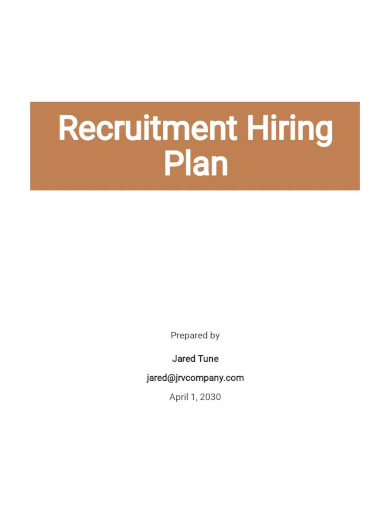
Recruitment Hiring Plan Template
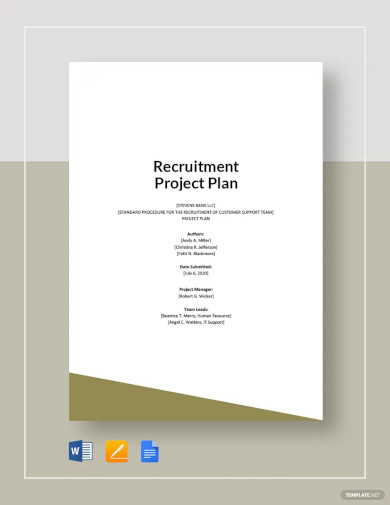
Recruitment Project Plan Template
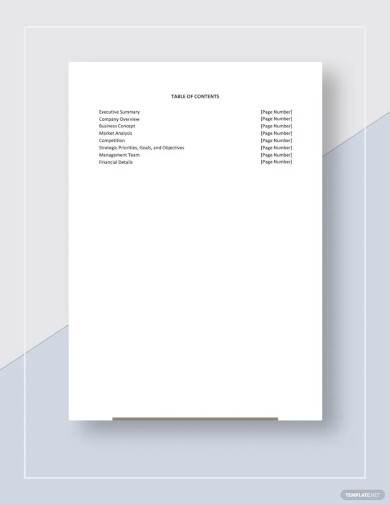
Recruitment Strategic Plan Template
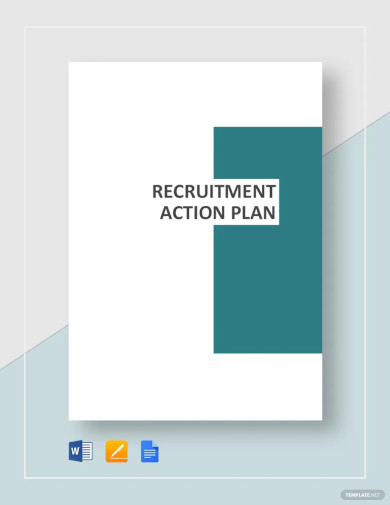
Recruitment Action Plan Template

Recruitment Process Improvement Plan Template
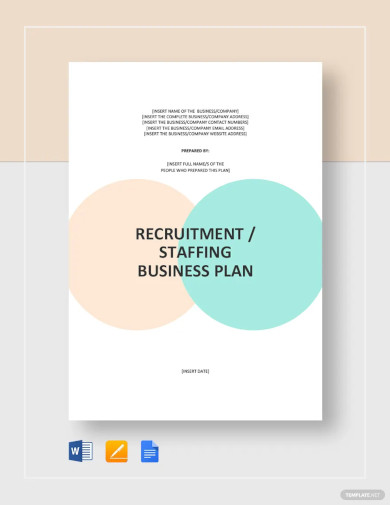
Recruitment/Staffing Agency Business Plan Template

University Recruitment Plan
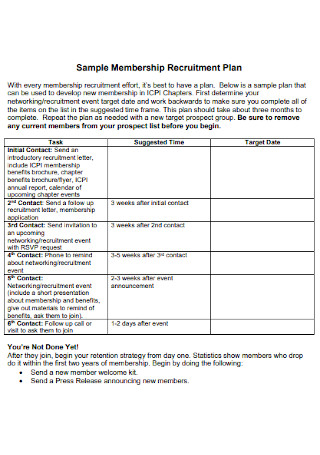
Sample Membership Recruitment Plan
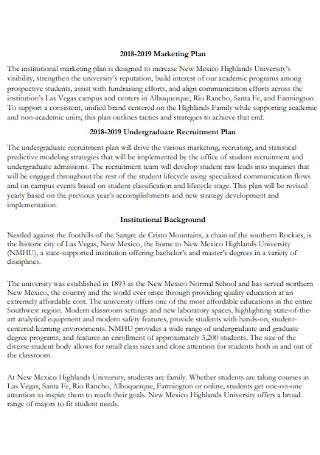
Undergraduate Recruitment Plan
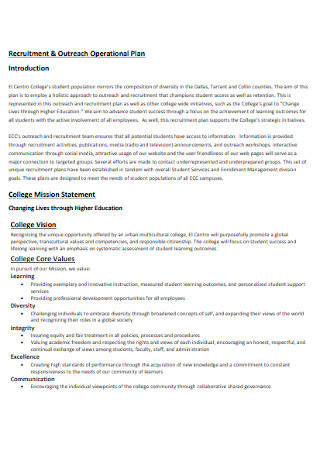
Recruitment and Outreach Operational Plan
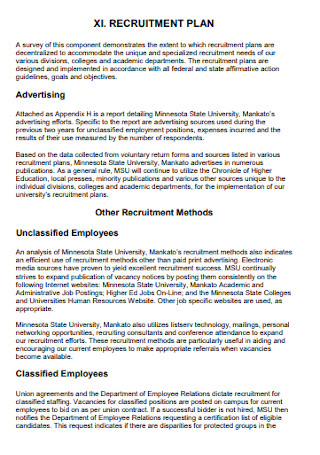
Basic Recruitment Plan Template

Staff Recruitment Plan
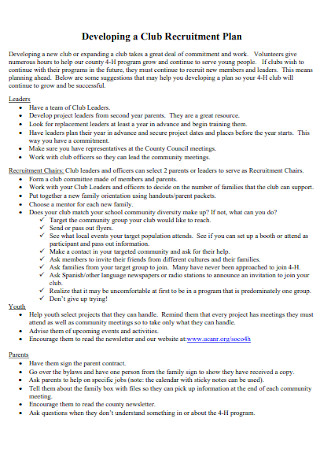
Club Recruitment Plan
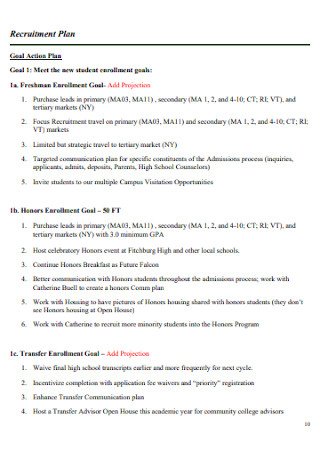
Office Recruitment Plan
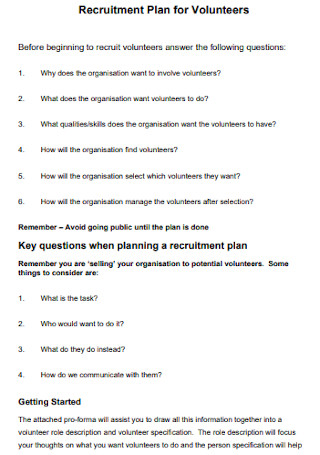
Recruitment Plan for Volunteers
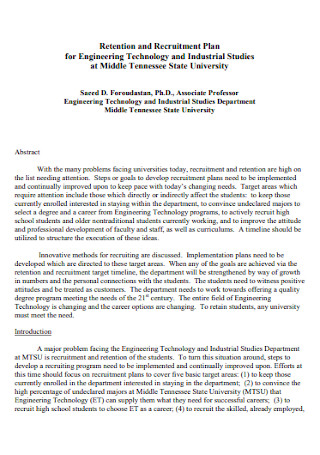
Recruitment Plan for Engineering Technology
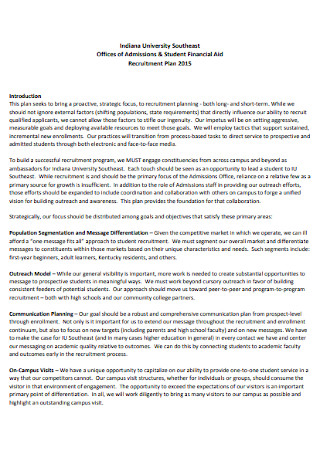
Student Financial Recruitment Plan
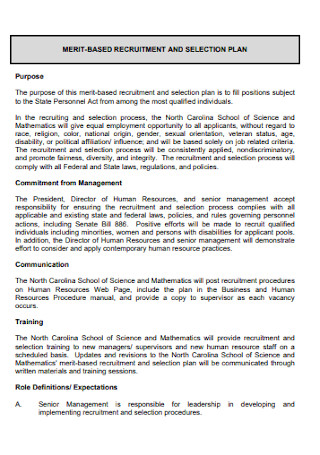
Recruitment Selection Plan

Annual Faculty Recruitment Plan
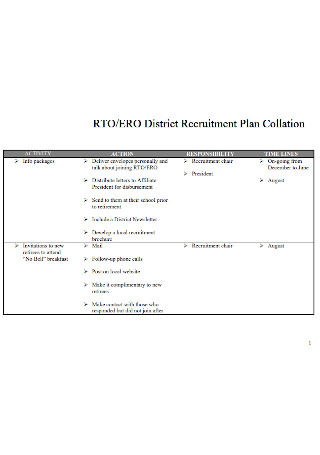
District Recruitment Plan
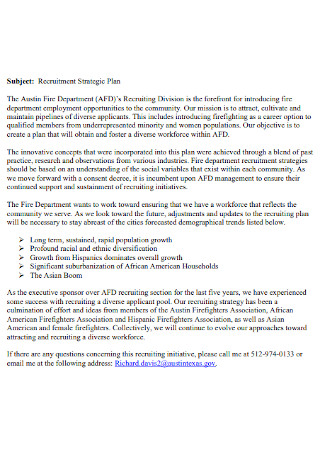
Recruitment Strategic Plan
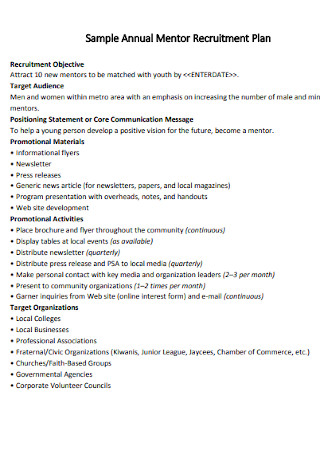
Sample Annual Mentor Recruitment Plan
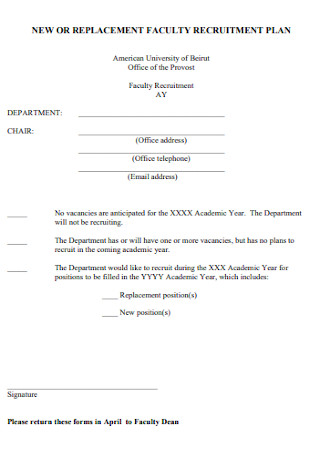
Faculty Recruitment Plan

Graduate Recruitment Plan

Standard Recruitment Plan Template
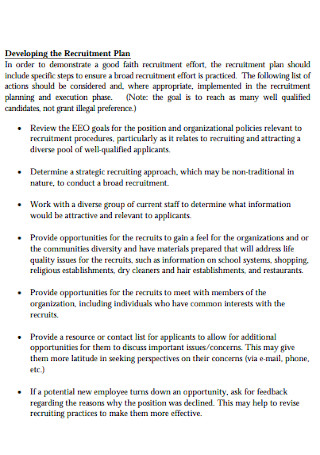
Recruitment Developing Plan

Public Safety Recruitment Plan
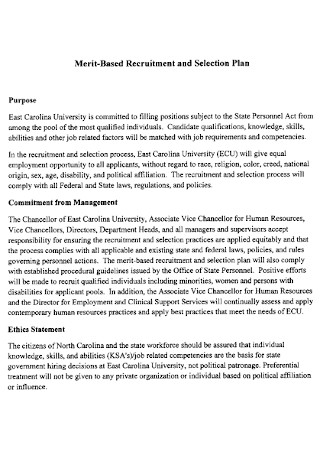
Merit-Based Recruitment and Selection Plan

Formal Recruitment Plan Template
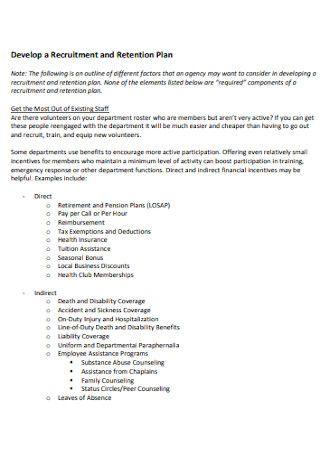
Recruitment and Retention Plan
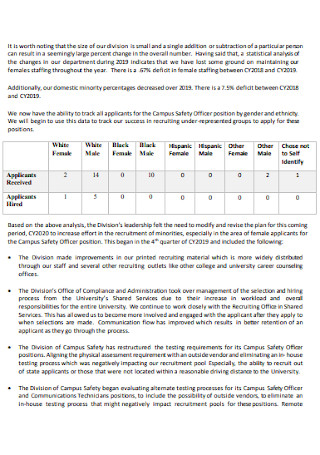
Campus Safety Recruitment Plan
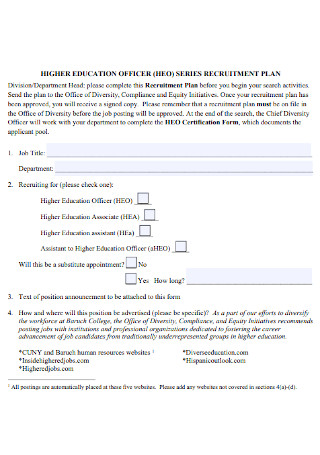
Education Officer Recruitment Plan
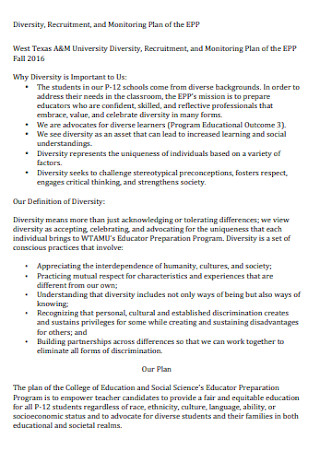
Recruitment and Monitoring Plan
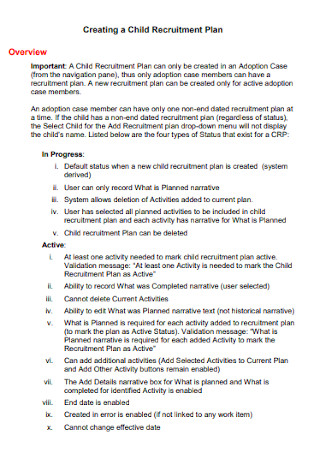
Child Recruitment Plan
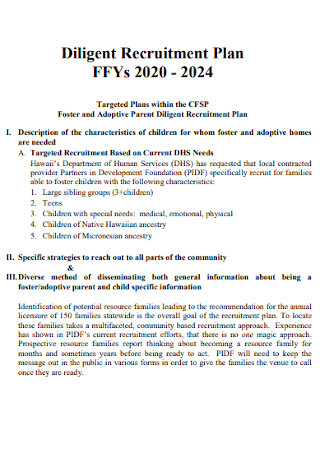
Diligent Recruitment Plan

Diversity Recruitment Plan
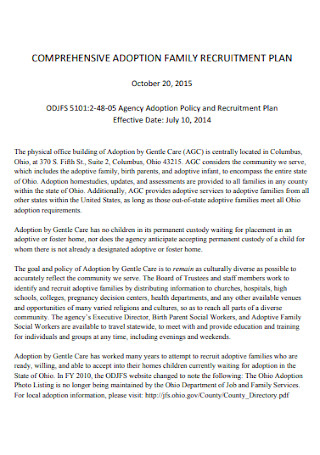
Adoption Family Recruitment Plan
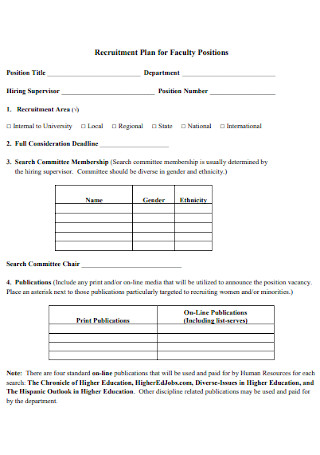
Recruitment Plan for Faculty Positions
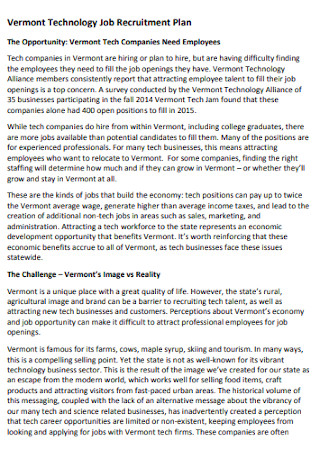
Job Recruitment Plan
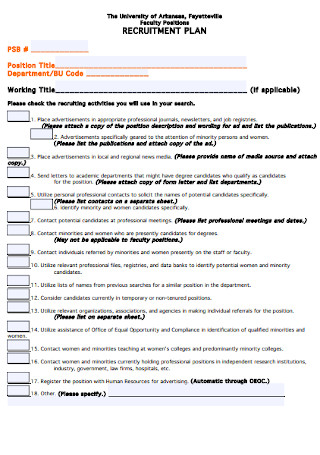
Sample Faculty Recruitment Plan
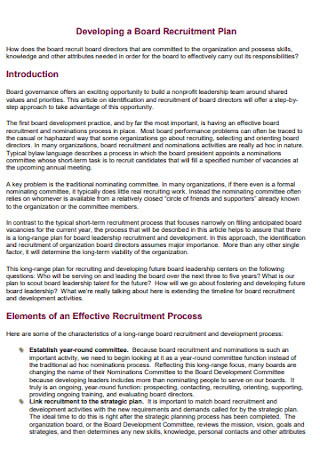
Board Recruitment Plan
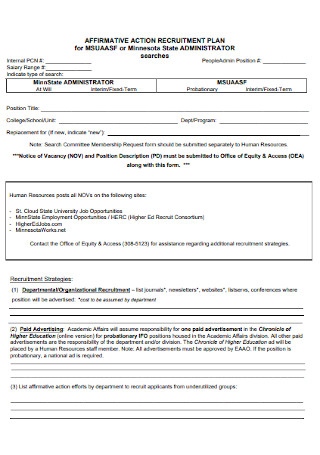
Affirmative Action Recruitment Plan
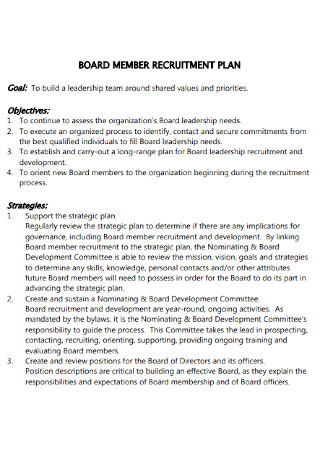
Board Member Recruitment Plan
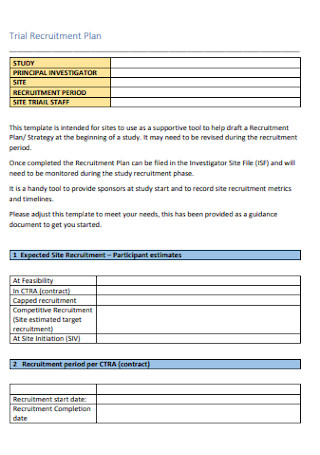
Trial Recruitment Plans
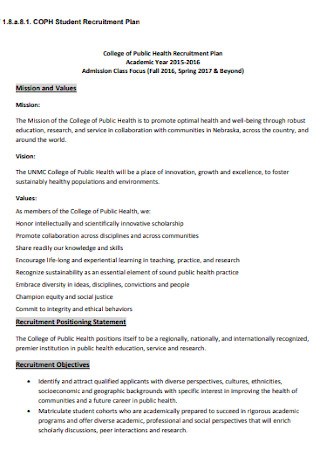
Student Recruitment Plan
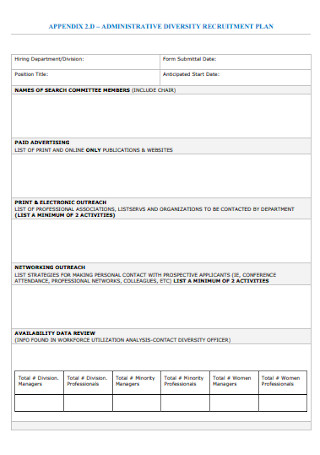
Administrative Diversity Recruitment Plan
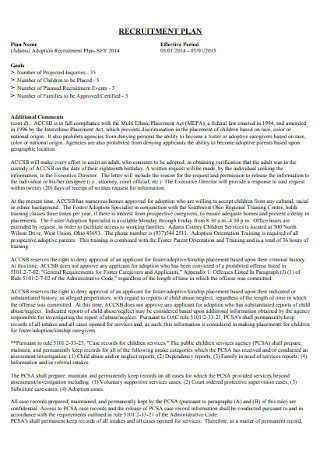
Recruitment Plan Format
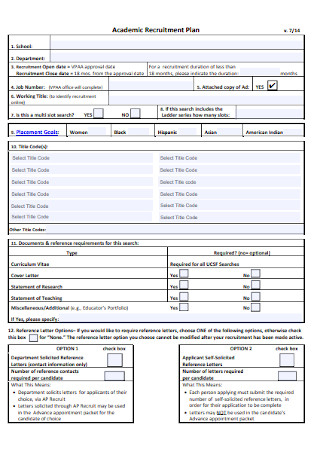
Academic Recruitment Plan
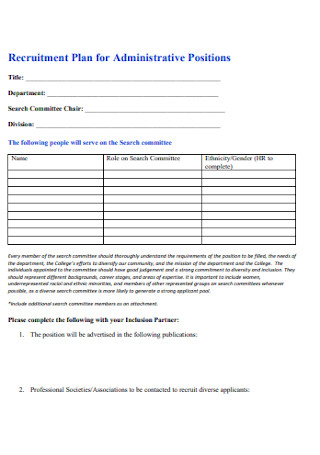
Recruitment Plan for Administrative Positions
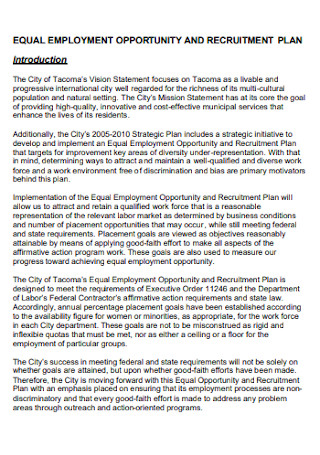
Employment Recruitment Plan
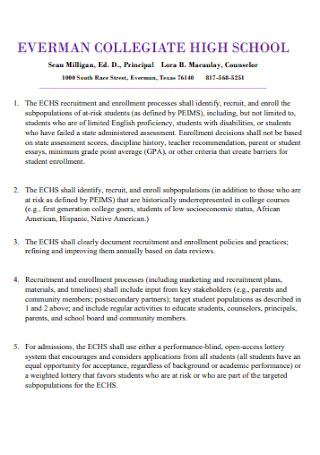
High School Recruitment Plan
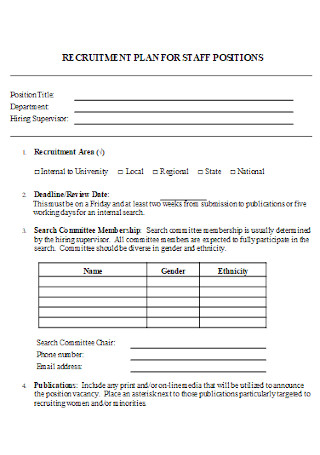
Recruitment Plan for Staff Position
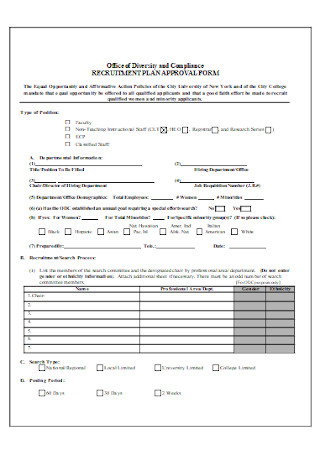
Recruitment Plan Approval Form
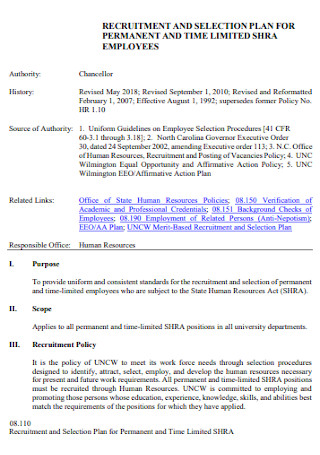
Permanent Recruitment Plan Template
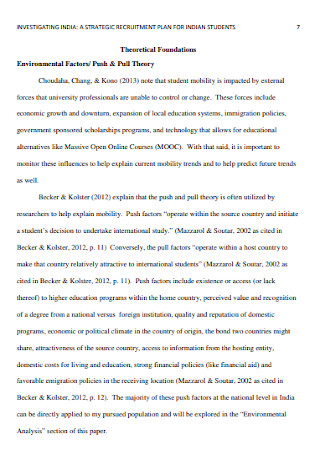
Strategic Recruitment Plan for Student
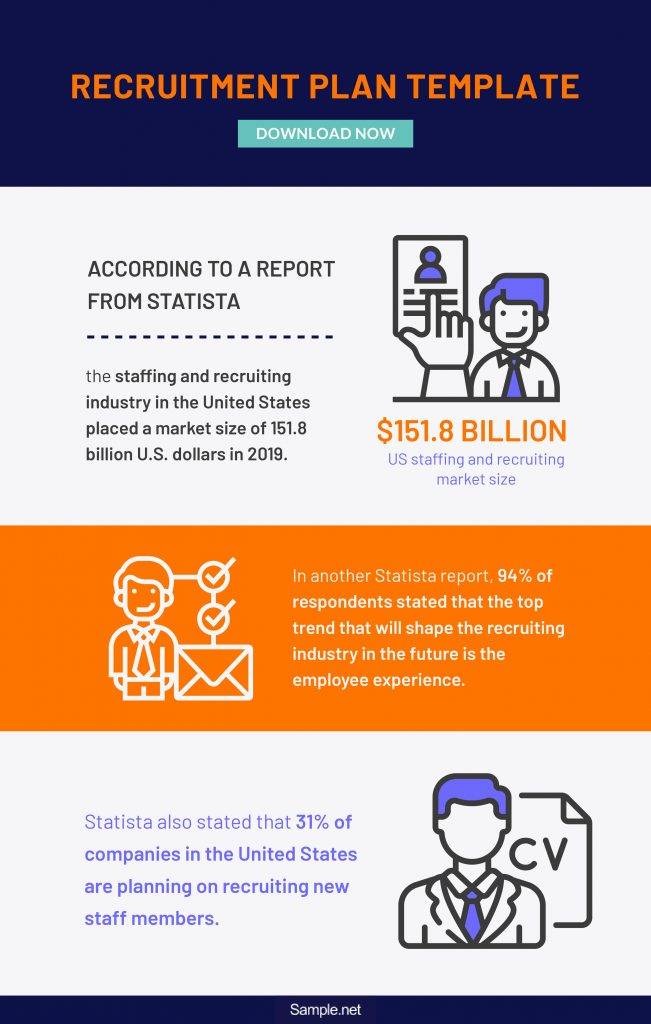
Step 1: Identify Hiring Needs and Skills Gaps
Step 2: make a hiring plan and recruitment calendar, step 3: determine tools to execute the plan, step 4: describe the requirements for the position, step 5: set a budget for the recruitment plan, share this post on your network, you may also like these articles.

In this comprehensive guide, we explore the essentials of creating an effective Floor Plan. Whether you are designing a new home, renovating an existing space, or planning an office…
Nursing Care Plan

In this comprehensive guide, we explore the essentials of creating an effective Nursing Care Plan. Whether you are a nursing student, a new graduate, or an experienced nurse, this…
browse by categories
- Questionnaire
- Description
- Reconciliation
- Certificate
- Spreadsheet
Information
- privacy policy
- Terms & Conditions

9 steps to a successful recruitment campaign

1 click unsubscribe at any time
Launching a recruitment campaign isn’t just an HR affair. 👀 Imagine attracting talent who have the hardskills and fit in perfectly with your team’s culture!
It’s a strategy used to attract 🧲, assess and hire talent for a company. It can be broken down into 3 objectives:
- 1️⃣ Fill a position.
- 2️⃣ Strengthen the employer brand .
- 3️⃣ Attract the best candidates .
In short, we’ll explain how to launch your campaign in 9 steps + innovative examples! 😇
Grab your best latte and happy reading! (Reading time: 5 minutes) ✨.
Launch a recruitment campaign in 9 steps
But why launch a recruitment campaign at all? Well, in an increasingly competitive job market, simply publishing an ad, sourcing and waiting for applications is no longer enough… A recruitment campaign will enable you to target 🎯 precisely the profiles you’re looking for, reach candidates who aren’t necessarily looking for a job, and above all, stand out from the competition . 💪🏼
Let’s go through the 9 steps! 👇🏼
1) Define the position to be filled
Here, we’ll detail the responsibilities, daily tasks and objectives to be achieved .
Make no mistake about this step, as it lays the foundation for the entire recruitment process .
In fact, if you’re clear and precise about the job’s duties from the outset, you’ll reduce the risk of misunderstandings, and you’ll be sure that candidates understand what’s expected of them. 😇
To do this, you can work with the people involved to understand the real needs:
- What specific skills are needed?
- What are the minimum qualifications?
Then define the working conditions, level of responsibility and opportunities for advancement within your company. 📈
This way, you filter out from the outset those whose skills or expectations don’t match up, handy no? 👀
2) Define the candidate’s profile
This step confirms that you’re attracting qualified candidates who are aligned with your company’s culture, employer brand and value. In reality, it’s like drawing a sketch of the ideal person for the job. 🤖
First, identify 🔎 the role’s technical skills . These can be:
- Specific qualifications.
- Years of experience (junior, senior).
- Specific knowledge for the position (programming language, design tools, etc.).
Don’t limit yourself to technical skills.
Soft skills are just as important! Does the job require good communication skills, adaptability, and initiative? 👀
In addition to skills, think about the candidate’s personal characteristics . Ask yourself whether it’s essential for the person to be proactive, creative, or results-oriented. 🤔
Finally, ask yourself what would attract a candidate to your company? Is it the fact of :
- 🖥️ Work on innovative projects?
- ⚖️ Work-life balance?
- 🦋 Opportunities for personal and professional development?
Example : you’re recruiting a digital project manager, here’s his candidate profile. ⬇️
| Criteria | Details |
|---|---|
| Training | Training in project management |
| Experience | 5 years’ experience in digital marketing |
| Technical skills | Ability to manage multi-functional teams, strong affinity with new technologies |
| Behavioral skills | Dynamic, adaptable to change, strong sense of initiative |
| Personal characteristics | Proactive, results-oriented, creative |
| Values and culture | Aligned with innovation and teamwork, shares company values |
| Professional motivations | Motivated by the development of disruptive projects, attracted by growth opportunities and work-life balance |
3) Write the job offer
The job title must be precise and understandable. Avoid titles that are too technical or internal to the company, which may not be recognized by potential candidates.

It must immediately grab attention and give a clear idea of the role! 😇
Next, briefly describe the company. This section should offer an overview of your mission, your values, and what sets your company apart from the rest!
Pshiit, highlight what might attract a candidate , such as company culture or benefits. 👀
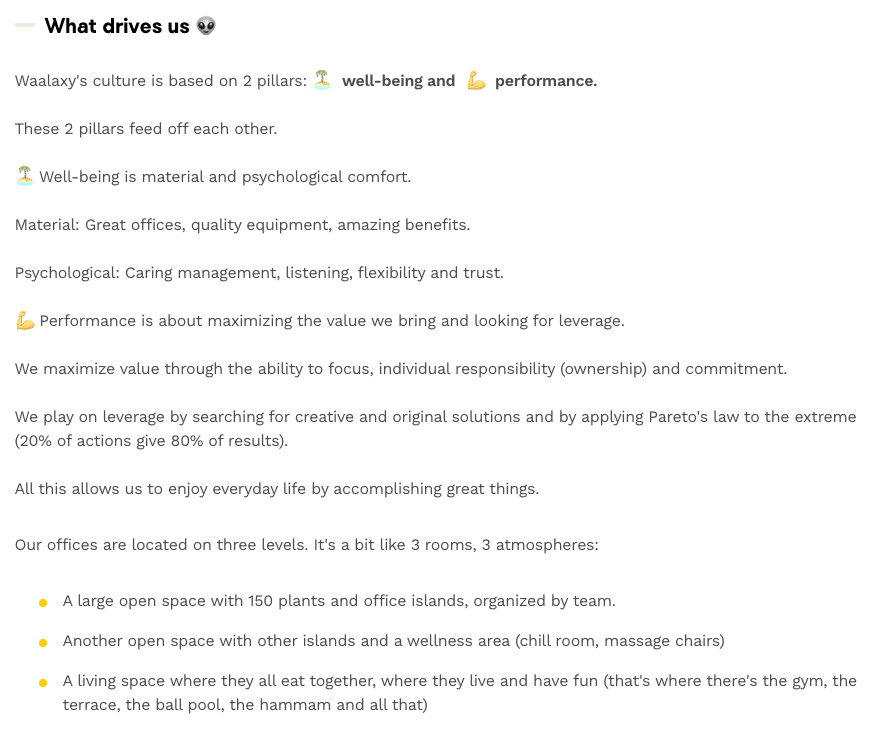
As for the description of responsibilities, you can list the main tasks and underline the challenges of the position. 💪🏼
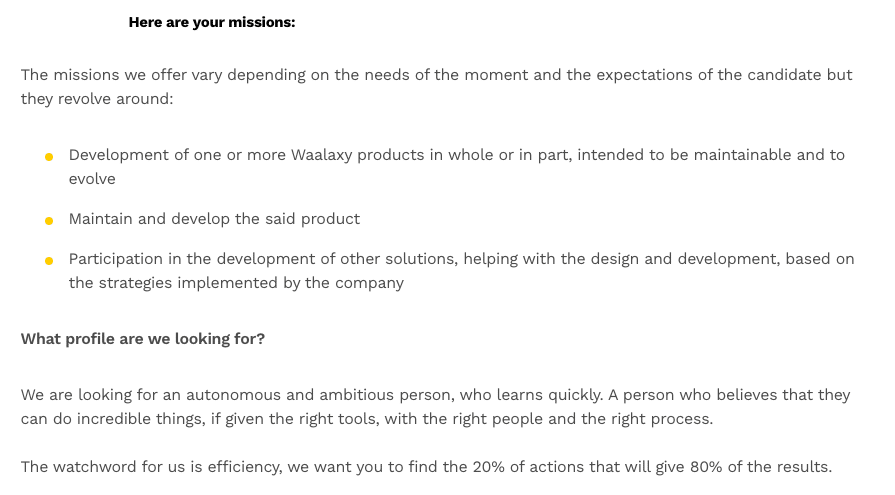
Qualifications and skills required should be stated (only if this is an important criterion in your company). To do this, separate essential skills from those that are merely desirable.
This allows candidates to better assess whether they fit the profile you’re looking for.
Finally, don’t forget to specify the location of the position, the type of contract or any other details you feel are important! 🦋
4) Create candidate personas
If you didn’t know, a candidate’s persona is a fictitious profile that represents your ideal candidate. This marketing technique helps you better understand candidates’ motivations , behaviors and expectations , so you can better attract them. 🧲
If you don’t know how to do this, it’s very simple. Start by analyzing what your current employees do (especially those in positions similar to the one you’re looking for) and identify commonalities:
- Career path.
- Challenges faced.
This information will help you in your quest to find the ideal candidate .
Finally, don’t hesitate to segment your personas according to the different types of profiles you want. Let me explain! ⬇️
You can create a persona for a young graduate looking for his or her first professional experience , and another for an experienced professional looking to move into a new sector. 🦋
In any case, for each one, don’t hesitate to identify 🔎 :
- 🌞 The elements that might convince them to apply .
- 🩵 The messages that match them most closely.
- 📢 Preferred communication channels.
5) Distribute the job advert
This step is very important because it’s not just about posting the ad on as many platforms as possible, but selecting the most relevant channels to reach your target audience ! 👀
Already, start by identifying the job boards where you can find your nugget candidates. ✨ I’m thinking in particular of platforms like Welcome to the Jungle, Indeed, or LinkedIn . 👀
There’s a quick and easy strategy for sending out your job postings: prospecting. 🚀
We’re going to show you how to use a tool that’s going to make your recruitment automation easier: Waalaxy. 👽
If you don’t know what Waalaxy is, it’s an automated prospecting tool for LinkedIn and E-mail, designed to be easy to use and accessible to everyone . 👽
Back to business, go to LinkedIn and search for your profile by mentioning, for example, job title, location, industry sector and profile language. 👇🏼
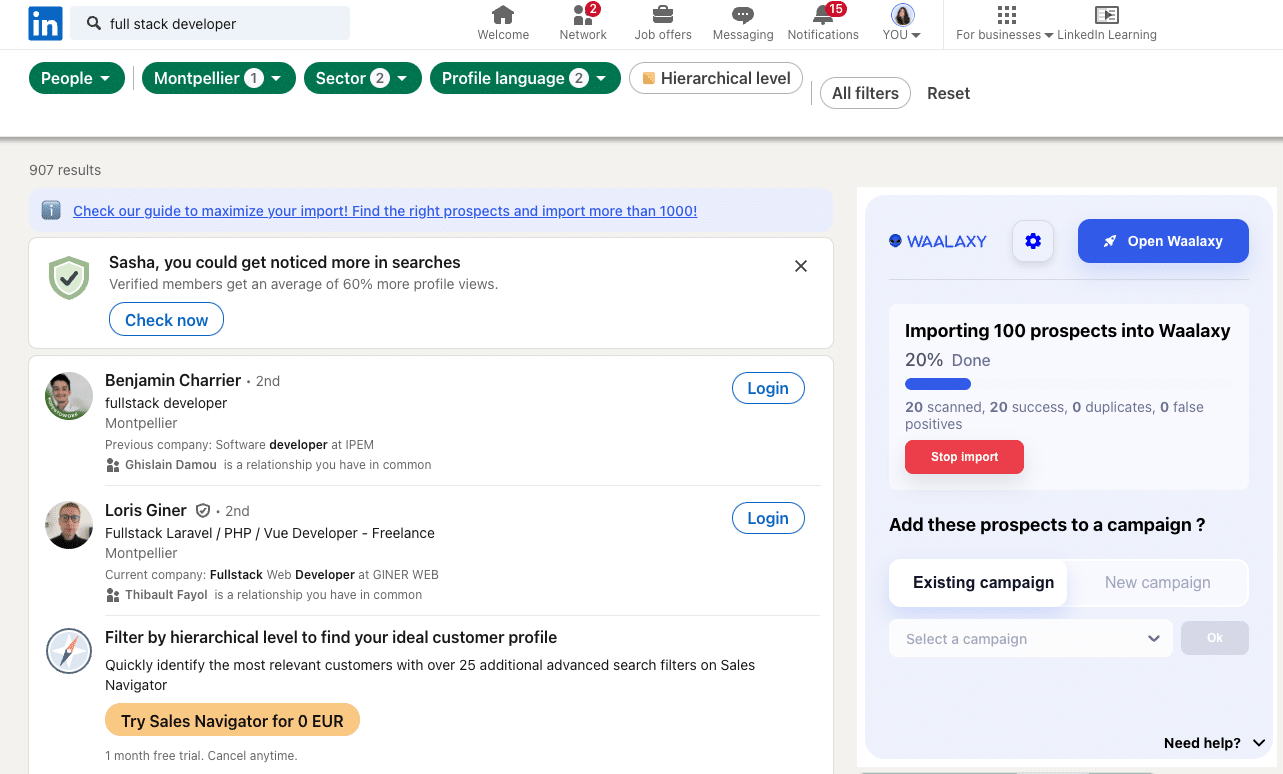
Then import them directly into Waalaxy using the Chrome extension. 😇
Once your prospects have been imported, you can create your campaign (over 99 sequences). We have chosen « Invitation + Message ».

Next, set the parameters of your campaign and, most importantly, write an impactful , relevant message that makes your prospects want to apply!

If you’re in need of a little inspiration, Waalaxy has just released Waami, an AI assistant that drafts messages to perfection. ✨
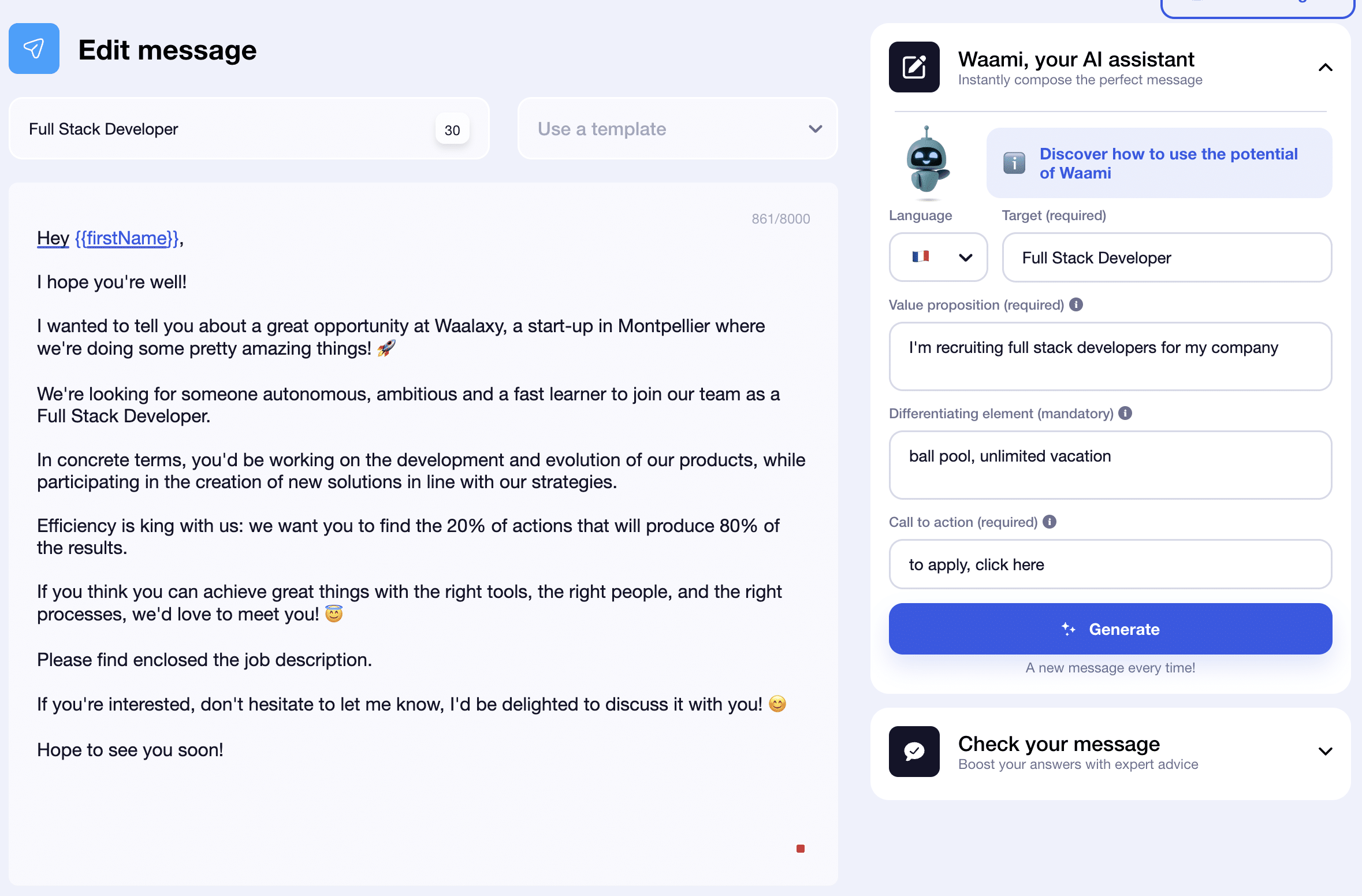
To find out more about the tool, click here! 👇🏼
6) Track candidate interactions
Once your ad has been posted and the applications start coming in, you need to keep a close eye on the interactions. 👀
To do this, you can use an application tracking system (ATS) to centralize all applications and interactions.
It’s advisable to respond promptly to every application. Even an automated acknowledgment can make a difference, as it shows candidates that their application has been received and is being considered. 😇
But wait, we’re not just talking about managing applications here. Think also of the possible questions or requests for information that candidates may have by e-mail, or even on social networks. 🦋
Responding quickly and sincerely strengthens your company’s image and improves the candidate’s experience.
7) Select resumes
This step allows you to filter the candidates to define those who best match the positions! 😇
A little tip: establish selection criteria based on the skills , experience and qualifications you defined in the previous steps.
But that’s not all: take the time to evaluate the soft skills that jump out at you 👁️, such as :
- Adaptability.
- Leadership.
- Communication skills.
These elements can be decisive for the long-term success of a position.
Finally, once you’ve shortlisted the CVs, get ready to enter the interview phase! ✨
8) Conducting interviews
Last but not least, the interviews! 💪🏼
Prepare for your interviews with targeted questions 🎯 that address both specific skills for the position, and soft skills.
For example, you can ask behavioral questions that assess how the candidate has handled similar situations in the past. 👀
The eighth stage of the recruitment process involves conducting interviews . This phase is crucial for assessing both the candidates’ technical skills , and their fit with the company’s culture and ability to integrate into the team.
During the interview, observe the candidate’s communication, attitude and enthusiasm.
Did you know that there are software programs that allow you to make a selection of CV?
How can you do this? Well, thanks to filters that you decide on, such as: 👇🏼
- Specific skills.
- Professional experience.
- Defined criteria.
We recommend these two tools: 👇🏼
1️⃣ Workable: this tool uses artificial intelligence to analyze and sort candidates’ CVs. It also offers candidate recommendations based on these criteria, which can help you focus on certain profiles. 👀

2️⃣ Teamtailor: this tool allows you to quickly filter applications to eliminate those that don’t match your criteria, and therefore reduces the time spent on pre-selection.

Take detailed notes for each interview to compare candidates objectively. 📝
9) Analyze the recruitment campaign
Now we’ve reached the final stage of a recruitment campaign : analysis! 🤓
To do this, examine key performance indicators (KPIs) such as:
- 🔵 Conversion rate (candidates interviewed vs. hired).
- 🟣 Number of applications received.
- 🔵 Recruitment time .
- 🟣 Cost per hire .
📢 Breaking news: a short break in the program to quickly return to Waalaxy. 📢 Directly on the dashboard, you have the statistics of your campaign of quickly with some KPI ! 👀
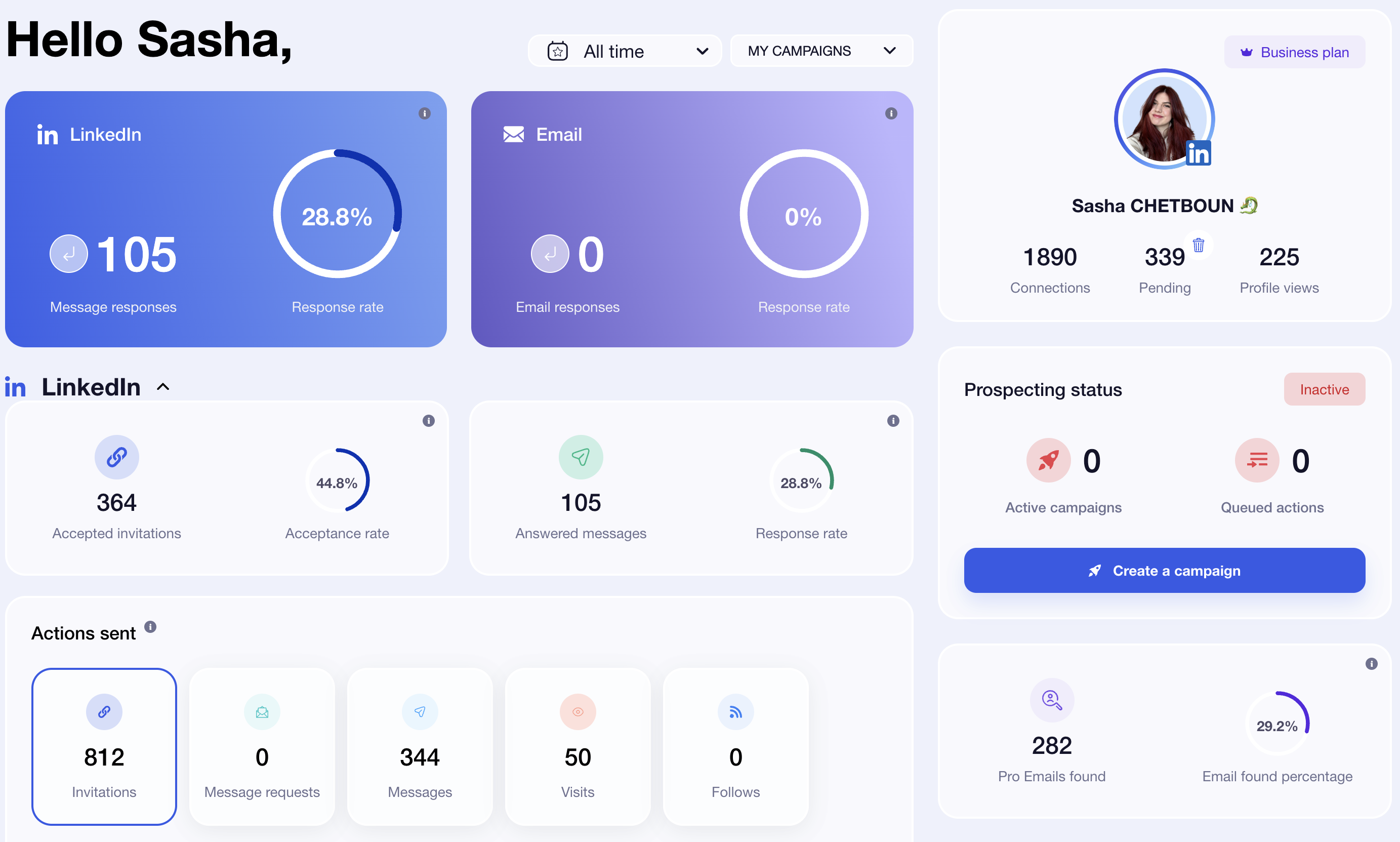
📢 End of breaking news, thank you for listening.📢
Once you’ve recruited your candidates, ask yourself: are they a good fit for the job and the company? 🤔
To do this, don’t hesitate to gather as much feedback as possible from stakeholders, not forgetting the candidates. 🌞
Finally, a word of advice: document your successes and failures, so that you can adjust your strategies to improve your next campaigns. 💪🏼
7 examples of innovative digital recruitment campaigns
Now that you’re a recruiting whiz 🃏, let’s analyze some recruitment campaigns that worked! 😇
Example 1: Waalaxy
Violette Léger (HR at Waalaxy) regularly posts anecdotes about the company, its values and other stories on LinkedIn.
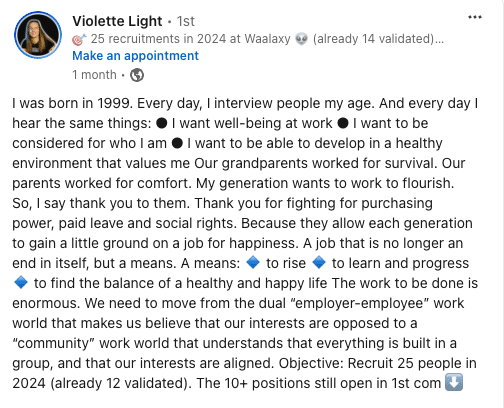
In this post , she thanks previous generations and creates an emotional connection.
Why ? 🤔
Well, this empathy helps to humanize the company and attract 🧲 candidates who share these values (incidentally, she mentions at the end that Waalaxy is recruiting ). 👀
By publishing on LinkedIn , the approach moves from a simple job offer to a genuine promise of company culture. 😇
Example 2: McDonald’s

In this campaign, McDonald’s doesn’t show off its restaurants or the latest trendy menu, but rather what young people call the brand, nodding to the campaign messag e, Make It Yours. 🍟
It’s easy to see that this is more than just a fast-food restaurant, it’s a place where young people can turn and make themselves at home. 🏠
It’s also a reminder that leaving home or going to university is a luxury many can’t afford.
Example 3 : The army
The campaign is designed to attract specialized civilian talent who may not be interested in traditional military careers, but who may be motivated by unique scientific challenges. 💪🏼

Indeed, the campaign is clearly geared towards people with research skills in glaciology or geophysics. ❄️
The slogan proves that this work allows candidates to advance in their field, take on unique definitions and contribute to world-class projects. 😇
Example 4: Disney

In this campaign, Disney invites potential candidates to be authentic, to join Disney, and to contribute to the history of the legendary brand. 😇
Each image has been carefully chosen and represents something:
- 🏰 Castle: represents the magic and heritage of Disney.
- 🔥 Fire: evokes modern animation and new stories.
- 💡 Neon: symbolizes technology and visual innovation (hello Groot).
- 🌟 Ahsoka Tano (Star Wars character): represents iconic franchises.
- 🐧 Ocean with penguins: illustrates the diversity of content, including nature documentaries.
Example 5: Google

Here, the aim was to recruit talented software engineers and mathematicians without directly announcing that Google was behind the ad. 👀
The billboard displayed a problem, and few people are capable of solving it (I dare you to succeed 🤔).
This strategy encourages those capable of solving the problem to access the website, making the invitation exclusive and attracting the attention of top talent. 💡
Example 6: Best University
To reach students, the University of Florida wants to raise awareness of alcohol abuse and the prevention, treatment and recovery programs available to them. 👀
This starts with a catchphrase from Albert Einstein that makes no sense whatsoever to grab attention. 🤯

Then, the university reassures students about the potential social pressure of alcohol.
The poster uses a demystifying strategy, showing that exaggerated or erroneous perceptions are not uncommon, and that misconceptions about alcohol consumption can also exist. 👀
Example 7: Ikea
Last but not least, our favorite furniture brand… Ikea ! 🇸🇪

In this campaign, Ikea is targeting individuals who share the company’s values and vision of offering 50% plant-based main courses in restaurants by 2025.
It’s technology meets sustainability.
Ikea encourages entrants to contribute their innovative ideas, while tasting plant-based meatballs prepared using a 3D printer. 🖨️
Get your first customers this week
Take advantage of the power of Waalaxy to generate leads every day. Start prospecting for free, today.
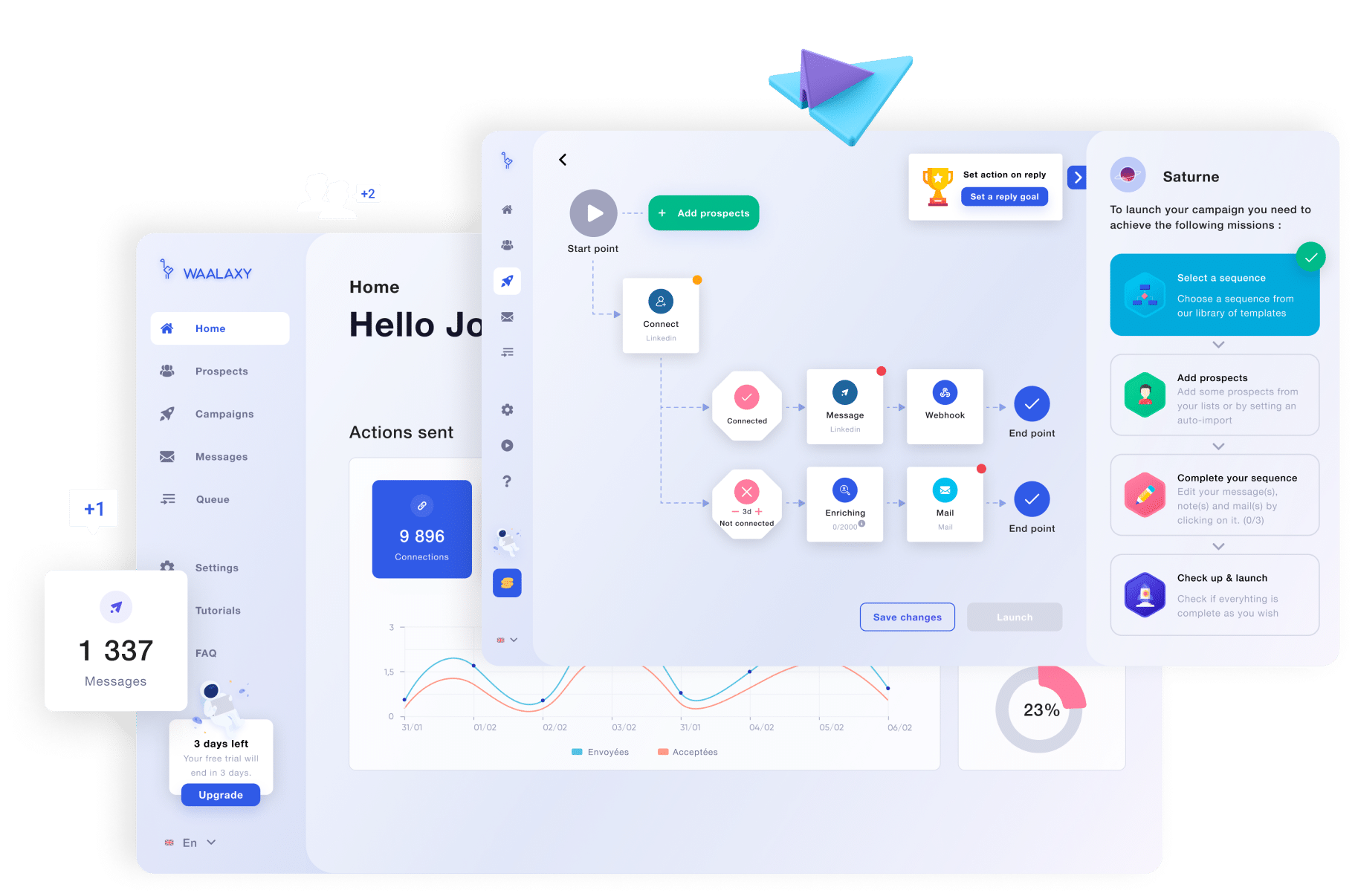
How about a quick recap?
As you can see, launching an effective recruitment campaign is more than essential if you want to :
- 1️⃣ Attract the best talent .
- 2️⃣ Strengthen your competitiveness.
- 3️⃣ Ensure your growth.
A well-thought-out strategy is the key 🔑 to building a team aligned with your values , and continuing to contribute to your long-term success.
So don’t let this opportunity slip through your fingers , start your recruitment campaign now! 💪🏼
Frequently asked questions
Wait, don’t start your campaign just yet, we’ve got a few other things to tell you first. 🤭
What types of recruitment ads are there?
There are several types of employment contract , but here is a non-exhaustive list: ⬇️
- Professionalization contract.
- Apprenticeship contract.
- Fixed-term contract.
- Seasonal contract.
- Portage salarial.
- Part-time employment.
- FIXED-TERM CONTRACT.
- OPEN-ENDED CONTRACT.
What are the 2 recruitment methods?
There are two types of recruitment: 👇🏼
- Internal recruitment: fill vacancies using talent already present within the company. This promotes internal mobility, employee loyalty and reduces recruitment costs.
- External recruitment: looking for candidates from outside the organization. This brings in new blood, new skills and a wider range of profiles.
What are the recruitment channels?
There are several recruitment channels :
- Traditional advertising ➡️ job boards, newspapers, specialized platforms.
- Social network ads ➡️ aims to reach a wider audience and generate direct engagement on LinkedIn, Facebook , Instagram or Twitter.
- Video ads ➡️ provides a dynamic presentation of the company and the position to be filled .
That’s it, you can start your recruitment campaign ! See you soon. ✌🏼
Want to go further?

Scalability guide for start-ups

The 5W1H Method: How to define a problem correctly?

- Know all about prospecting
- How to use LinkedIn Sales Navigator?
- LinkedIn Emoji Keyboard : The List to Copy and Paste
- Your ideal LinkedIn thank you message
7 examples of successful prospecting messages
- Video tutorials
- Help Center
- Waaliens Community
- Email Finder
- LinkedIn Prospecting
- AI Prospect Finder
- LinkedIn messaging
- Affiliate program
- Legal notice
- Terms & Conditions
- Use of data

Get the ultimate e-book for multi-channel prospecting 📨
Or How to go from 0 to +10 leads per week – No experience needed.

Social media
Prospecting
Recruitement
7 examples of successful LinkedIn prospecting messages
Masterclasses
Dans la piscine
Sucess story

Get all Products for $197!
- Management eBooks
- Marketing eBooks
- Finance eBooks
- Project management eBooks
- Technology eBooks
- Checklists and Sheets
- Bundles and Packs
Username or email address *
Password *
Lost your password? Remember me
Diversity recruitment strategies and how to improve them
Diversity and inclusion have become more than just buzzwords—they are essential to successful business strategies. Companies that prioritize diversity in their recruitment practices are better equipped to foster innovation, drive employee engagement, and achieve long-term profitability . However, creating a truly diverse workforce requires more than good intentions; it demands a well-thought-out and actionable diversity recruitment strategy.
This comprehensive guide explores everything you need to know about diversity recruitment strategies, including what diversity recruiting is, why it’s essential, and how to implement effective strategies to build a more inclusive workforce.
What is diversity recruiting?
Diversity recruiting is the strategic search and employment of people with different backgrounds, races, ethnicities, ages, genders, abilities, sexual orientations, and other distinctive individual characteristics. It is a method beyond regular hiring processes in such a way that it brings inclusion into the workplace by valuing different perspectives . It intends to build a workforce that mirrors the vast array of people in society to foster creativity, problem-solving, and innovation within the organization.
Diversity recruiting means being aware of these biases and how to cleanse them in job postings, candidate assessments, interview practices, etc. Embracing diversity recruitment strategies means embracing the view that every candidate will have an equal opportunity to succeed.
According to a 2023 McKinsey report, companies with greater gender and ethnic diversity are 39% more likely to have above-average profitability than their less-diverse counterparts. This statistic underscores the tangible benefits of diversity, not only in terms of social equity but also in driving business success. A diverse workforce can bring different perspectives and ideas, leading to more innovative solutions and a better understanding of the diverse customer base, ultimately contributing to the company’s success.
The concept of diversity recruiting is a subset of the overall umbrella practice known as DEI: diversity, equity, and inclusion . Strategies for DEI recruiting are intended to be fair and devoid of any barriers that may prevent specific groups from being represented proportionately within the workforce. Those strategies include proactive sourcing of diverse candidates, ensuring diversity in the interview process, and creating a company culture embracing inclusivity.
Underlining its relevance, diversity recruitment is not a trend but a vital component of modern human resources practice , which you can learn more about in our e-book Human Resources Explained . As businesses go more global, the various perspectives and ideas that come with having a diverse team could prove highly advantageous. In addition, workforce diversity will help an organization better understand and serve its diverse customer base.
Why is it important to have a diversity recruitment strategy?
A diversity recruitment strategy is crucial for several reasons, both from a moral and business perspective. Firstly, a diverse workforce fosters a more inclusive and supportive workplace culture . Employees who feel valued and included are likelier to be engaged, productive, and loyal to the company. Human Resources Explained , in turn, reduces turnover rates and saves the organization the costs associated with recruiting and training new hires.
A well-defined diversity recruitment strategy also enhances the company’s reputation . In today’s socially conscious world, customers and job seekers are increasingly considering how companies address diversity and inclusion. Organizations known for their commitment to diversity often attract top talent seeking an environment where they can thrive, regardless of their background.
Moreover, diversity in the workplace leads to better decision-making and problem-solving . Diverse teams can solve problems faster than teams composed of individuals with similar backgrounds. Diversity brings together different viewpoints and experiences, leading to more creative and effective solutions.
Another critical aspect of diversity recruiting is its role in driving innovation . Diverse teams are more likely to develop novel ideas and approaches, giving the company a competitive edge in the market. Companies like Google and Microsoft have long recognized diversity’s value and implemented comprehensive diversity hiring strategies to foster innovation.
Additionally, having a diversity recruitment strategy is essential for compliance with legal and regulatory requirements . In many countries, laws are in place to prevent discrimination in hiring, and companies must demonstrate that they are taking steps to ensure equal opportunities for all candidates. Failure to do so can result in legal consequences and damage to the company’s brand.
Lastly, from an ethical standpoint, diversity recruitment aligns with the principles of fairness and equality . It ensures everyone has an equal chance to succeed regardless of background. This helps build a more just society and aligns with the values of many modern organizations.

Diversity recruiting strategy examples
Diversity recruitment strategies can vary widely depending on the organization’s goals, industry, and specific challenges. However, several proven strategies can be adopted by companies to enhance their diversity hiring efforts.
Another strategy is to implement bias-free hiring practices . This involves training recruiters and hiring managers to recognize and mitigate unconscious biases that may influence their decisions. Techniques such as blind recruitment, where candidate names and other identifying information are removed from resumes, can also help to prevent bias. Studies have shown that blind recruitment can increase the chances of diverse candidates advancing in the hiring process.
Employee resource groups (ERGs) can also significantly influence diversity recruitment. ERGs are voluntary, employee-led groups formed around shared characteristics or life experiences. These groups can provide valuable insights into the needs and challenges of diverse employees and help shape more inclusive hiring practices. Companies like PepsiCo and Google have used ERGs to connect with diverse talent and improve recruitment strategies.
Referral programs encouraging employees to refer candidates from underrepresented groups can be another powerful tool. Research from the National Bureau of Economic Research suggests that referrals tend to produce more successful hires. By incentivizing referrals from diverse backgrounds, companies can tap into networks they might need access to through traditional recruitment channels.
Internship and mentorship programs targeted at underrepresented groups are also highly effective in building a pipeline of diverse talent. Programs like Google’s Code Next and Facebook’s University Recruiting focus on providing opportunities for students from underrepresented backgrounds to gain experience in the tech industry. These programs help diversify the workforce and develop the next generation of leaders.
Lastly, companies should regularly review and update their job descriptions to ensure they are inclusive and not deter diverse candidates. Using gender-neutral language and emphasizing the company’s commitment to diversity and inclusion can make job postings more appealing to a broader range of candidates.
How do you ensure you are following the diversity recruiting best practices?
Ensuring your organization follows diversity recruiting best practices requires a proactive and continuous approach. It’s not enough to simply set diversity hiring goals; companies must actively work towards creating an inclusive hiring process that supports those goals
One of the first steps in following diversity recruiting best practices is to conduct a comprehensive audit of your current hiring processes . This involves analyzing recruitment data to identify potential biases or disparities in how candidates from different backgrounds are evaluated and selected. For example, examining the stages at which diverse candidates drop out of the hiring process can provide insights into where improvements are needed.
Training is another critical component of diversity recruiting best practices. All individuals involved in the hiring process, from recruiters to hiring managers, should receive training on unconscious bias and cultural competence. This training helps to ensure that all candidates are evaluated based on their skills and qualifications rather than preconceived notions or stereotypes.
Implementing structured interviews is also a best practice in diversity recruiting. Structured interviews involve asking all candidates the same questions, reducing the likelihood of bias influencing the evaluation process. They are one of the most reliable methods for predicting job performance and help ensure a fair and consistent evaluation of all candidates
Another best practice is establishing clear diversity recruitment metrics and regularly monitoring progress against these metrics. This could include tracking the diversity of candidate pools, the percentage of diverse candidates who advance through each stage of the hiring process, and the retention rates of diverse employees. By regularly reviewing these metrics, companies can identify areas for improvement and make data-driven decisions to enhance their diversity recruitment strategies.
It’s also essential to foster an inclusive company culture that supports diversity beyond just the hiring process. This means creating an environment where all employees feel valued and included, which can be achieved through initiatives like diversity training, employee resource groups, and inclusive leadership practices. An inclusive culture not only helps retain diverse talent but also attracts new candidates looking for a supportive and welcoming workplace.
Finally, companies should seek employee feedback on the effectiveness of their diversity recruitment efforts. Surveys, focus groups, and exit interviews can provide valuable insights into how current and former employees perceive the organization and where there may be opportunities for improvement
What is a diversity recruiting plan, and what should it contain?
A diversity recruiting plan outlines an organization’s steps to attract, hire, and retain a diverse workforce. It is a roadmap for implementing diversity recruitment strategies and ensuring the company meets its diversity and inclusion goals.
At the core of a diversity recruiting plan is a clear definition of the organization’s diversity and inclusion objectives . These objectives should align with the company’s overall mission and values and be specific, measurable, achievable, relevant, and time-bound (SMART). For example, an objective might be to increase the percentage of women in leadership roles by 20% over the next three years.
The plan should also outline the key strategies that will be used to achieve these objectives. This could include specific recruitment initiatives, such as partnerships with diversity-focused organizations, targeted outreach to underrepresented groups, and implementing bias-free hiring practices. Each strategy should be clearly defined, with details on how it will be executed, who will be responsible for it, and how success will be measured.
A diversity recruiting plan should also include a timeline for implementing the various strategies and achieving the defined objectives. This timeline should be realistic, and the resources and support needed to carry out the plan effectively should be considered.
Another critical component of the diversity recruiting plan is the establishment of accountability measures. These include assigning roles and responsibilities for diversity recruiting efforts, regularly reviewing progress, and holding leaders and managers accountable for meeting diversity goals.
Metrics and diversity KPIs (Key Performance Indicators) are essential for measuring the success of the diversity recruiting plan. These metrics include the diversity of the candidate pool, the percentage of diverse hires, the retention rates of diverse employees, and employee satisfaction scores related to diversity and inclusion. Regularly tracking and analyzing these metrics can help the organization make data-driven decisions and adjustments to the plan as needed.
The plan should also include communication strategies to ensure that all employees know the organization’s commitment to diversity and how they can contribute to these efforts. This might involve regular updates from leadership, training sessions on diversity and inclusion, and opportunities for employees to provide feedback on the plan.
Finally, a diversity recruiting plan should be a living document that is regularly reviewed and updated to reflect changes in the organization’s goals, the external environment, and the effectiveness of the strategies being implemented. This continuous improvement ensures that the organization remains committed to diversity and inclusion over the long term.
Which types of diversity should you have in mind?
When developing and implementing diversity recruitment strategies, it’s essential to consider the various types of diversity that contribute to a well-rounded and inclusive workforce. Companies can create a more dynamic and innovative work environment by understanding and addressing these different types of diversity.
Considering all these types of diversity when crafting a diversity recruitment strategy is crucial for building a truly inclusive workforce. Each form of diversity brings perspectives, skills, and experiences, contributing to a more prosperous and more dynamic work environment.
Companies can build a more inclusive, innovative, and successful workforce by implementing and continuously refining diversity recruitment strategies. Diversity recruiting is not just about meeting quotas or checking boxes; it is about creating a workplace where everyone can thrive and contribute to the organization’s success.

Human Resources Explained
Over 70+ pages of pure knowledge.
Buy for $27

All Products Special
You get 40 Business eBooks, 2 Ultimate Checklists, 1 Ultimate Cheat Sheet, and 15 game-changing tools.
Get all products for $197
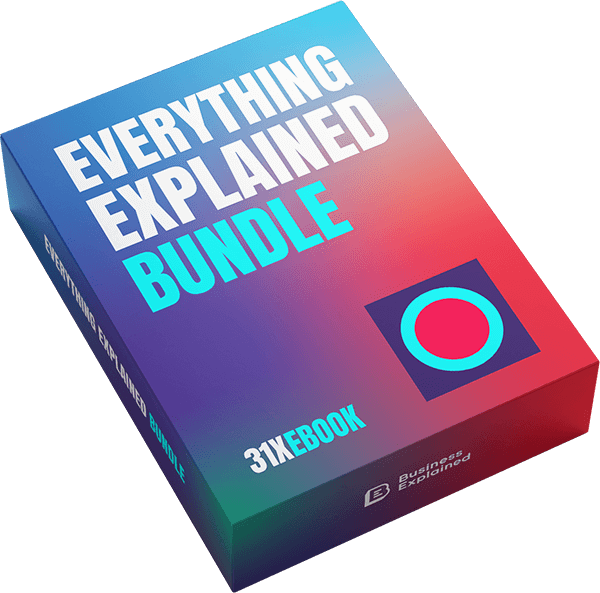
ultimate offer
Bundle: Everything Explained
You get all 31 of our Business eBooks !
Get all 29 eBooks for $119
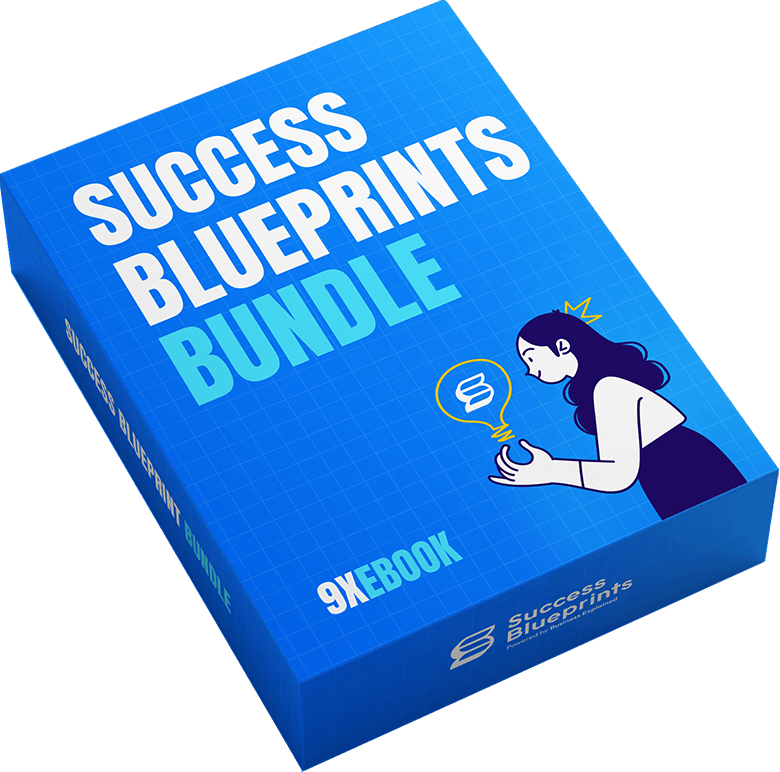
Bundle: Success Blueprints
You get all 9 of our high-quality eBooks !
Buy bundle for $109

Pack: Elevate Sheets
Enjoy 3 Ultimate Sheets and 15 Additional Tools.
Buy Pack for $119
- Login / Register

IMAGES
COMMENTS
Writing a business plan in recruitment has always played a crucial part in the interview process for a number of recruitment agencies around the world. A comprehensive business plan can demonstrate a recruiter's commitment, knowledge and commercial acumen. During economic uncertainties in 2023, these qualities are more important than ever. Arriving at an interview armed […]
A free example of business plan for a recruitment agency. Here, we will provide a concise and illustrative example of a business plan for a specific project. This example aims to provide an overview of the essential components of a business plan. It is important to note that this version is only a summary. As it stands, this business plan is ...
Crafting a well-structured business plan will help you to: get familiar with the recruitment agency market. be aware of new consumertrends and apply them to your project. recognize profitability factors for a recruitment agency. understand the hiring needs, job requirements, and talent preferences of client companies.
Writing a staffing agency business plan is a crucial step toward the success of your business. Here are the key steps to consider when writing a business plan: 1. Executive Summary. An executive summary is the first section of the business plan intended to provide an overview of the whole business plan. Generally, it is written after the whole ...
A business plan has 2 main parts: a financial forecast outlining the funding requirements of your recruitment agency and the expected growth, profits and cash flows for the next 3 to 5 years; and a written part which gives the reader the information needed to decide if they believe the forecast is achievable.
A comprehensive startup business plan for a recruitment agency should include: Executive summary: Start with a clear and concise overview of your business — your elevator pitch. Highlight your business goals, mission statement, and the services you plan to offer. Market analysis: Conduct thorough research on the staffing industry, focusing on ...
The #1 Recruitment Business Plan Template & Guidebook offers an easy-to-follow framework for creating a step-by-step recruitment strategy that will get results. This comprehensive guide includes everything you need to know to develop an actionable plan backed by best practices and insightful tips from industry experts. ... Here is an example of ...
Potential Recruiter Salary. On average, a recruitment consultant has the potential to earn between $65,000 and $75,000 annually. Charges for placing a candidate can range between 14 and 20 percent. Charges for your services may be based on a percentage of the candidate's first annual salary.
Thorough market research is the best first step when you're writing a business plan. Market research means examining the industry your business will exist in, and finding out the needs and preferences of that industry's consumers. For a recruitment agency, a key research topic for your business plan would be finding out the impact COVID-19 ...
The pay rate data will be determined by changing market factors including business demand. Our experience shows that the following is true with regard to pay and bill rates. A "good deal" for most temporary agencies is 50% of pay rate markup. Thus, if the pay To is unlock $10, the help bill try Upmetrics! is $15. .
Step 3: Management and key personnel. A business is only as good as the people behind it. To really make your recruitment agency a success, you'll need the support of a great team. In the management and key personal section of your plan you should detail your management, staff, and plans for further growth.
3) Chat with HR, your C-suite, and hiring managers. These three stakeholders can offer invaluable insights you can use to build your recruitment plan. The key is proactively engaging them to secure the data, info, and preferences that will inform your TA resource allocation in 2024. Speaking with these hiring team members and executives ...
This template includes a complete recruitment agency business plan example, with a financial forecast and the following sections: Executive summary: the executive summary gives the reader a clear and concise overview of your business idea. Company: this section lays out the structure of your business, including its location, management team and ...
We walk through the key components and include examples. At the end of the article, you can download a free recruitment business plan template which is tailored towards the key components mentioned in this article. Length. A business plan should be packed full of relevant information but should be compressed and to the point. Avoid verbiage ...
You only need a basic plan to start, well thought through definitely, but not War and Peace. A start up recruitment business plan doesn't need to be super sophisticated. However what you do need is a well thought through plan so you can build solid foundations for growth, remove as much risk as possible and allow you, once you go live, to ...
Event planners often will work for between $12.50 and $25 per hour, depending on the length of the job, requirements, and experience needed. We find a $5 per hour markup on the $12.50-$17.50 is reasonable, and a $10 per hour markup on anything over $17.50 per hour. Fundraisers.
Follow these steps to write a recruiting plan that suits your company's needs. 1. Research recruitment needs. Creating a recruiting strategy plan requires extensive research across multiple areas. Research the requirements of each position and the marketing methods most effective for attracting applicants.
A detailed, step-by-step roadmap for implementing the recruitment strategy. It outlines specific tasks, timelines, responsibilities, and resources required to execute the strategy. Focus. Long-term goals, the 'what' and 'why' of the recruitment process. Short-term objectives, the 'how' and 'when' of implementing the strategy.
Step 2: Develop the headcount plan. Now that you have context, data, and feedback on previous hires, you can start planning for the future. The more an organization invests time into these exercises, the easier and more likely it will be to meet recruiting goals on time and within budget.
This recruitment agency business plan sample has been written with aspiring entrepreneurs in mind. Although it is summarised, it highlights the essence of a plan. By going through this sample, you can avoid the most common mistakes many entrepreneurs make. As always, our advice to new entrepreneurs is never to have zeal without knowledge.
Example of a recruitment plan This sample recruitment plan uses the template above as a guide. You can use this example to inspire your own recruitment plan: Recruitment plan Fellini's Café 1 July 2021 Prepared by Sue Jones, restaurant manager Recruitment goals This recruitment plan aims to achieve the following goals for the business: Hire five new employees in the next six months to allow ...
A recruitment plan template is a business's structured approach to recruiting, screening, interviewing, and hiring new employees. It includes the detailed steps, strategies, and timelines required to find the best candidates. ... For example, managers may need spend valuable time to support HR leaders during recruitment. 3. Determine how to ...
The recruitment process has five stages that may be present in most organizations. These stages include planning, sample strategy development, searching, screening, and evaluation and control. It is important for a business to know these stages to have an effective recruitment process.
Launching a recruitment campaign isn't just an HR affair. Imagine attracting talent who have the hardskills and fit in perfectly with your team's culture!. It's a strategy used to attract 鱗, assess and hire talent for a company. It can be broken down into 3 objectives: 1️⃣ Fill a position.; 2️⃣ Strengthen the employer brand.; 3️⃣ Attract the best candidates.
Diversity and inclusion have become more than just buzzwords—they are essential to successful business strategies. Companies that prioritize diversity in their recruitment practices are better equipped to foster innovation, drive employee engagement, and achieve long-term profitability.However, creating a truly diverse workforce requires more than good intentions; it demands a well-thought ...